密輸船&問題船(密入国)
UNDER-PERFORMING SHIPS (1年間に3回以上出港停止を受けた船舶) TOKYO MOUのHP
オーストラリアで摘発された北朝鮮船「ポン・ス」(PONG SU)は ツバル籍に登録されていた。 モンゴル籍船や カンボジア籍船 も違法行為に使われているらしい。
「テロの危機回避などで各国が外国船の船籍を厳しくチェックする動きが強まっており、 検査をかいくぐるために「モンゴル船籍」を取得する船が増えてきたという。」
「昨年4、5月の2カ月間で、日本の港湾に寄港したモンゴル船は24隻しかなかったが、 今年4、5月の2カ月間では約5倍の115隻も寄港している。」
★尾道糸崎税関職員に問題あり の場合もあるし、日本への密輸は簡単かもしれない。
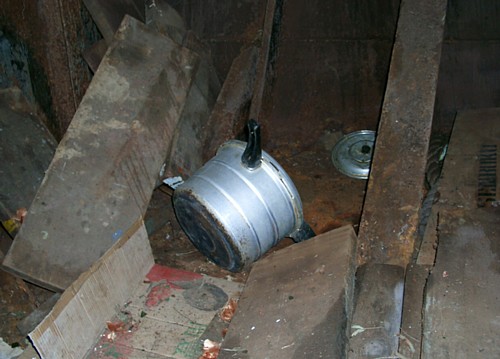 |
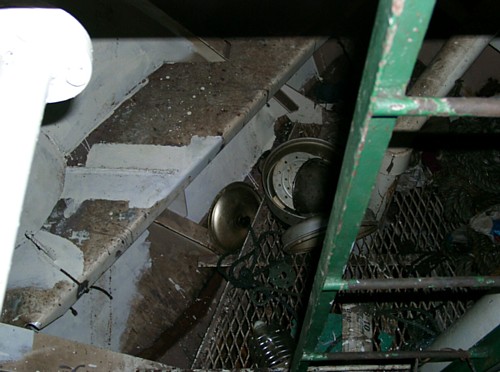 |
|---|
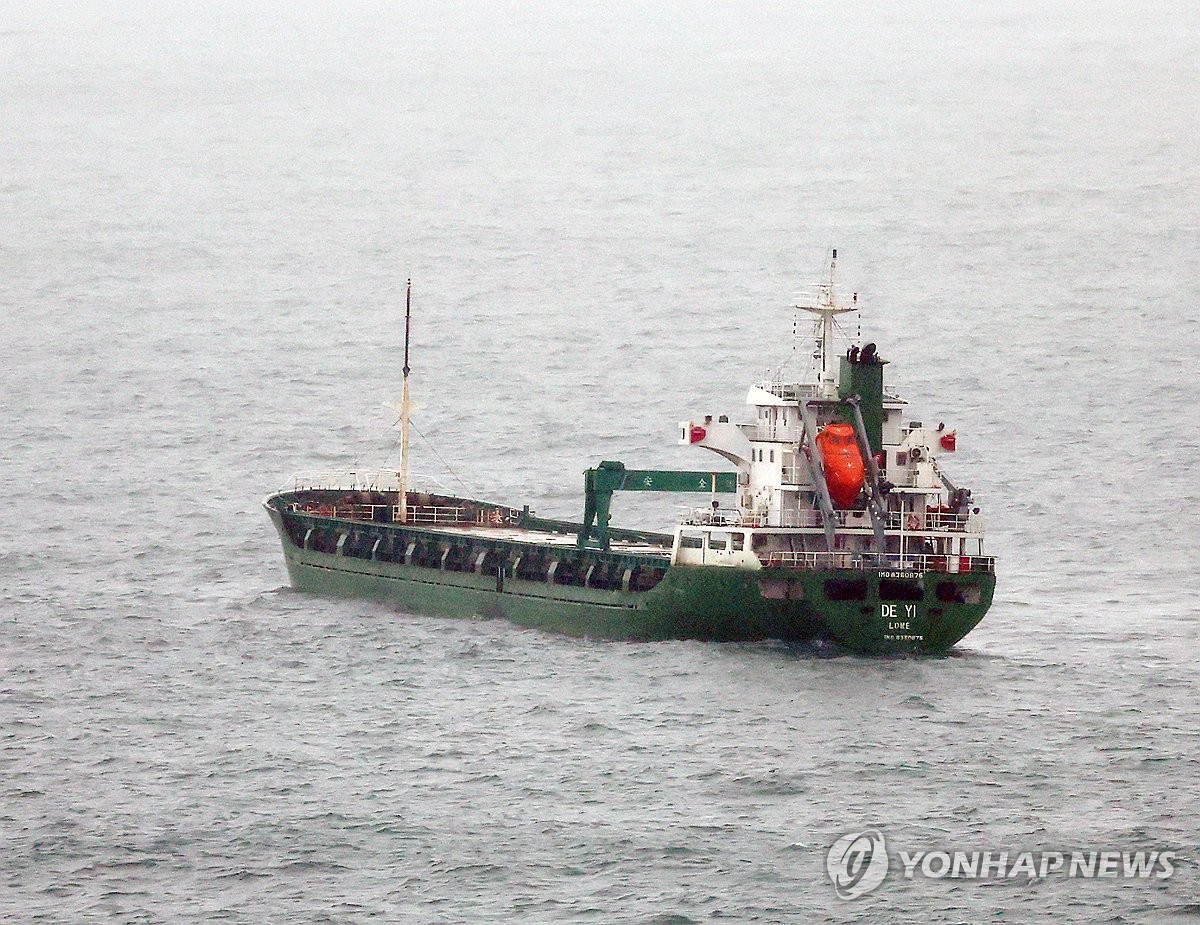
韓国当局が対北朝鮮制裁違反への関与が疑われる無国籍船を拿捕したことが分かった=3日、釜山(聯合ニュース)

(聯合ニュース)
北朝鮮とロシアが貿易しようと、日本に出来る事はない。
日本は過去に北朝鮮に寄港した船や北朝鮮にコントロールされていると思われる船に対して甘い対応、又は、見逃していると思われるような対応を取ってきた。こちらの問題をしっかりと対応するべきだと思う。日本は保安、又はセキュリティーに関しては甘いと思う。
北朝鮮の核・ミサイル開発を巡る国連安全保障理事会の制裁違反が指摘される同国の複数の石油タンカーが4月前半、ロシア極東のボストーチヌイ港に出入りしていたことが、読売新聞の衛星画像分析でわかった。安保理決議で輸入が制限されるガソリンなどの石油精製品を積み、北朝鮮に輸送した模様だ。石油精製品の密輸が、海上で船から船に移す「瀬取り」だけでなく、大胆な手法で行われるようになってきている。
【表】最近行われていることが分かっている、露朝間の主な取引内容
分析は、安保理の下で対北朝鮮制裁の履行状況を監視してきた北朝鮮制裁委員会専門家パネルの古川勝久・元委員と共同で実施した。米宇宙企業プラネット・ラボ社が4月前半に撮影したボストーチヌイ港の複数の衛星画像と、国連の専門機関である国際海事機関(IMO)や外務省などが公開する船舶の形状やサイズを比較した。
4月1、3、7、10日の画像では、北朝鮮のタンカーと特徴が一致する計4隻が、石油タンクとみられる構造物が並ぶ岸壁に係留されたり、港湾内を航行したりしている様子を確認できた。
1日の画像が捉えたのは、「YU SON号」とみられる船舶だ。過去に瀬取りを行った容疑で安保理の制裁対象となっている。3、7、10日の画像にそれぞれ写ったのは「UN HUNG号」「PAEK YANG SAN1号」「WOL BONG SAN号」の3隻とみられ、いずれも制裁に違反して北朝鮮側に売却された船舶だった。専門家パネルは4隻について、北朝鮮への石油精製品の供給を制限した安保理決議に違反した疑いを重ねて指摘してきた。
船舶の運航情報を公開するサイト「マリントラフィック」で4隻の航跡を確認したところ、4隻ともボストーチヌイ港への寄港前後は、船舶自動識別装置(AIS)の信号が途絶えていた。航跡をたどれなくすることで、石油精製品の輸送を隠蔽(いんぺい)しようとした可能性がある。
「YU SON号」は、3月上旬に朝鮮半島西側の黄海から、対馬海峡を通過して日本海まで進んだが、3月9日を最後にAIS信号を発しなくなった。衛星画像で4月1日にボストーチヌイ港への係留が確認された。この間の詳しい動向は不明だが、12日にロシア・ウラジオストク沖で信号を再び発し、対馬海峡経由で黄海まで戻った。
10日の衛星画像で、ボストーチヌイ港付近での航行が判明している「WOL BONG SAN号」とみられる船舶は、13日にロシア・ウラジオストク沖で信号を発し、対馬海峡を通過して、20日に北朝鮮西岸の南浦(ナムポ)付近に着いたことがわかった。
北朝鮮は、2017年12月の安保理決議で、石油精製品の輸入量上限を年50万バレルに制限されている。米国のジョン・カービー大統領補佐官は今年5月の記者会見で、ロシアによる北朝鮮向けの石油精製品供給が3月だけで16万5000バレルを超え、すでに年間上限を上回ったと指摘した。
北朝鮮の石油精製品の密輸は、同国の領海内などで瀬取りにより行われてきたことが、専門家パネルの報告書で指摘されてきた。古川氏は「今年春以降、北朝鮮のタンカーがボストーチヌイ港に直接寄港し、石油精製品を調達するようになった」と指摘。「密輸が常態化しており、国連制裁が機能していないことは明らかだ」と説明している。(衛星画像分析の詳細は、9日の朝刊特集面で掲載予定)
衛星画像を分析して、日本を取り巻く安全保障環境の現状を報告する。(随時掲載)
◆船舶自動識別装置(AIS)=船の位置や針路、速度などの情報を自動的に送受信する無線装置。海上人命安全条約で、国際航海に従事する舶船に搭載が義務づけられている。衝突防止や運航管理などに役立てられている。
ロシア・北朝鮮の蜜月、大胆手法の背景に
今回の衛星画像分析でわかったのは、北朝鮮が石油タンカーをロシアの港に堂々と横付けし、国連安全保障理事会の決議に違反する石油精製品の輸入を繰り返している可能性が高いということだ。北朝鮮が、より大胆な手法をとるようになった背景には、ロシアとの結びつきの強まりがある。
ロシアはウクライナ侵略の長期化で、北朝鮮から、安保理決議に違反して弾道ミサイルや弾薬の提供を受けるようになったとされる。北朝鮮への石油精製品の供給はその見返りという位置付けだ。
対北朝鮮制裁の履行状況は安保理の下に設置された専門家パネルが監視してきたが、3月下旬、専門家パネルの活動期間延長を巡る決議は、ロシアの反対で否決された。監視の目をなくそうというロシアの狙いは明白で、北朝鮮の増長を招く結果となった。
ロシアとの連携強化は北朝鮮にとって、核・ミサイル開発のための資金や燃料だけでなく、関連技術の獲得にもつながった。日本の安全保障への影響は深刻だ。安保理決議に違反するこれらの行為は決して許してはならない。
専門家パネルの廃止で制裁違反の事例が増えることが懸念される。国際社会は弱体化した監視網の立て直しと、制裁の実効性の確保に取り組む必要がある。(政治部次長 仲川高志)
By: Joanna Rose Aglibot Philippine Daily Inquirer
SAN FELIPE, ZAMBALES, Philippines — As the livelihood of residents in this coastal town return to normalcy following the recent suspension of dredging operations involving Chinese workers, the presence of another foreign aggregate carrier with Chinese crew has once again raised concerns.
Renan Gilig, a resident of Sitio (subvillage) Laoag in Barangay Maloma, said villagers were worried that the dredging operation that they had been opposing would resume.
“It’s hard not to think that dredging activities might start again without us knowing it, especially since we’ve seen similar [dredging] ships in the area recently,” Gilig, also the executive secretary of the Laoag Integrated Fisherfolk Association, told the Inquirer on Wednesday.
He said if the arrival of aggregate carrier MV Hyperline 988 was related to the provincial government’s plan to continue the suspended Maloma River restoration project, the national government must step in.
“It is also important to thoroughly complete the full and necessary investigations [into the dredging operation here]. Make it open to the people and ensure the true and correct purpose of the project,” Gilig added.
Deficiencies
MV Hyperline 988, a vessel with a Philippine flag but registered in Sierra Leone, was detained by the Philippine Coast Guard (PCG) in the waters off this town on May 15 following the discovery of 21 “basic deficiencies.”
The PCG said 13 of these deficiencies were grounds for detention, like the absence of statutory certificates and garbage and oil record books.
According to Commander Euphraim Jayson Diciano, head of the PCG station in Zambales, the vessel will remain detained pending the submission of its permits and other documents related to its purpose in docking here.
“After the PCG station evaluates all circumstances in light of the ship owner’s explanations, it will resolve the matter and send the report to inspectors for further assessment before releasing it,” he said.
Diciano said the ship owner must report to the PCG within 10 days of being notified about the deficiencies.
“However, concerns with other agencies pertaining to national security are influencing the PCG’s decision on Hyperline 988’s release,” he said, without elaborating.
In March, at least 17 vessels registered in the Philippines but owned by China Harbour Engineering Co. Ltd., carried out dredging activities here.
But these vessels were eventually held at the Manila anchorage area by the Maritime Safety Services Command of the PCG after also finding some deficiencies.
“This is a big insult to us Filipinos. While our fellow fishermen are driven away by the Chinese coast guard from our territory, we’re being lenient to Chinese workers who are here illegally,” said Gilig.
The Inquirer tried to reach Gov. Hermogenes Ebdane Jr. and San Felipe Mayor Reinhard Jeresano for comment on the possible resumption of the dredging operations but they were not immediately available.
Senate probe
In 2019, the Department of Environment and Natural Resources (DENR) issued Administrative Order No. 13 rationalizing the dredging activities in the heavily silted river channels of Bucao in Botolan, Maloma in San Felipe, and Sto. Tomas traversing the towns of San Marcelino, San Narciso and San Felipe.
Local officials and the DENR have been conducting public consultations for the continuation of dredging operations in some coastal areas of the province.
But affected residents had mounted a series of protests opposing the dredging operation and the presence of Chinese workers in the town, forcing the provincial govern ment to suspend the project
Sen. Jinggoy Estrada, chair of the Senate committee on national defense, filed a resolution on May 15 seeking to investigate the dredging activities of Chinese vessels in the province.
According to Estrada, the activities affect the livelihood of residents, cause undue damage to the environment and impact tourism.
The senator also inspected this town in March and was able to talk to some of the residents who protested against the dredging activities.
The Philippine Coast Guard detained at least seven Chinese crew members of a foreign-flagged ship on Thursday after it was found to have entered the Southeast Asian country's waters illegally.
The Coast Guard sent personnel to investigate after being notified that a tanker, identified as the Sierra-Leone-registered MT Hyperline 988, was flying the Philippine flag in waters off the town of San Felipe in Zambales province, local media cited the agency as saying.
The crew had switched off the vessel's automatic identification system, which ships use to broadcast their position to each other, and ignored the Coast Guard's radioed instructions.
During the inspection, the seven Chinese nationals onboard, including the captain, "failed to present original and printed versions of relevant documents, including the crew list, passports, and seaman's books," Euphraim Jayson Diciano, chief of Zambales' Coast Guard outpost, told the Philippine Daily Inquirer.
The Coast Guard said the ship had departed Hong Kong on May 11. The crew reported that they had set a course for San Felipe before reaching their alleged final destination, the Philippine capital Manila, due to the cheaper docking fees, although San Felipe does not operate a port and thus does not charge a docking fee.
The agency noted that the ship had a record of eight prior offenses related to pollution and safety. As of Saturday, the Hyperline 988 was being held in waters off San Felipe, Diciano said.
The Philippine Coast Guard and Chinese embassy in Manila didn't immediately respond to written requests for comment.
The detainment comes amid heightened tensions in the South China Sea between Chinese maritime forces and the U.S. Mutual Defense Treaty ally.
A shadow fleet tanker linked to India’s Gatik Ship Management was detained yesterday (Thursday) after its Russian crew alleged they were not paid, according to TradeWinds, a global shipping news source.
This may be the least of the owners’ and crews’ worries. Windward’s risk indicators and AI models revealed that the Electra’s behavior pattern clearly indicates it was likely involved in another illicit activity. Windward used our new Sequence Search capability to shed light on an emerging smuggling pattern involving 65 tankers…
Brief Background
The Electra (IMO: 9307815), a chemical tanker owned by Gatik Ship Management and currently sailing under the flag of Gabon – it previously sailed under the Saint Kitts and Nevis flag – was detained earlier this week following a suspicious ship-to-ship (STS) transfer off the coast of Greece.
The Electra has been flagged as medium risk in the Windward system since February 2023 for its relation to the Russia regime and various other risk indicators, such as port calls in Russia, STS operations with Russian-affiliated vessels, and indicators of suspicious cargo onboard. It is part of the dark fleet, which utilizes dark activities along with deceptive shipping practices (DSPs) to move wet cargo.
How We Got Here…
Electra arrived at Ust Luga in November 2023 and departed Russia in December, after loading cargo – there was a draft change from 7.0 to 10.3. The vessel then sailed to Greece, where it conducted a one-day meeting with another Indian-owned vessel.
After the meeting, the Electra offloaded cargo and departed to Gibraltar, where it was detained, according to TradeWinds.
Despite the reason for detention – the alleged non-payment of workers – the Electra’s behavioral pattern clearly indicates it smuggled oil out of Russia.
New Technology Reveals a New Smuggling Sequence
Sequence Search is a unique way for users to conduct advanced analysis of vessels’ behavioral typologies and trade movements, by searching for a sequence of activities. It helps contextualize the journey and reveals trends and patterns, enabling users to see if route deviations were conducted for security reasons, or for concealing illicit activities.
Based on Electra’s behavior, Windward’s experts utilized the Maritime AI™ platform to check the following sequence of activities:
Port call in Ust Luga > STS in Greece > Area visit to Gibraltar
We found that three of the Gatik Ship Management’s vessels sailed in the exact same pattern. All three of the vessels are currently sailing under the flag of Gabon, and all are flagged as either high or medium risk in the Windward system.
Utilizing Windward’s unique Sequence Search capability, we broadened the query for all tankers that behaved in the same pattern in the last year.
We are pleased to share our AI insights and the trend that was revealed: 65 tankers sailed the same pattern. None of them are Russian-flagged and all are either medium or high risk in the Windward system.
What Did We Learn?
All eyes are obviously on the Red Sea crisis as the Houthi disruptions continue, which has potentially emboldened bad actors in other areas. The already complex maritime and supply chain landscapes continue to get even more complex.
The war between Russia and Ukraine is intensifying and could have a major impact on your organization. The risk for sanctions and inadvertently trading for sanctioned/restricted Russian crude oil or oil products is still high. This could cost an organization many millions.
It’s important to quickly know who you may be trading with, with full visibility into suspicious cargo and ship-to-ship (STS) engagements. STS engagements are often important indicators for various DSPs, such as oil smuggling. Our unique STS model can help.
Predictive analytics and Sequence Search can also help you be proactive and discover fast-evolving DSP patterns and trends in a volatile landscape.
シーチェストだったらコカインを紛失する事はないだろうが、ボルトを外さないといけないし、暗くなってからダイバーが潜らないと周りに気付かれるだろうし、暗くなると危険だし、作業が難しいと思う。報酬が高ければ仕事を受ける人がいるのかもしれないが、事故で死亡する可能性があるから余程お金に困っている人しか関わらないように思える。
(高雄中央社)海洋委員会海巡署(海上保安庁に相当)偵防分署は29日、台湾海峡で漂流していたいかだなどから1381キロ、末端価格約35億台湾元(約160億円)の大麻を押収し、台湾への不正薬物の密輸に関与していたとみられるモンゴル船籍の小型タンカーの乗組員10人を摘発したと発表した。1度の押収量としては台湾では過去最多だとしている。
同署では密輸の情報を入手後、約3カ月かけて証拠を集め、9日に専門チームを立ち上げた。10日未明には南部・高雄の北西沖でいかだ1隻に立ち入り検査し、大麻221.7キロを押収。11日に同海域で漂流していた無人の救命ボート4隻などから大麻1159.3キロを見つけた。
その後、高雄興達港沖で小型タンカーに立ち入り検査を行ったところ、同船が救命ボートを使って大麻を台湾に密輸しようとしていたことが判明した。
台湾橋頭地方検察署(地検)は、摘発された小型タンカーの乗組員は台湾人3人とミャンマー人7人で、取り調べ後、毒品危害防制条例や不正薬物運搬の罪に違反している疑いが強いとして身柄を拘束したとしている。
鹿児島市の港を拠点とするカツオ漁船で大麻を所持していた疑いで、高知県の53歳の船長の男を逮捕していたと、第十管区海上保安部が17日、発表しました。
十管によりますと、大麻取締法違反の疑いで現行犯逮捕されたのは、高知県黒潮町のカツオ漁船の53歳の船長の男です。
船長は、今年5月15日に鹿児島市城南町の岸壁に係留してあった自分が船長を務めるカツオ漁船の寝台の下に、乾燥大麻24.381グラムと吸引器具を隠し持っていた疑いです。
十管や五管などが、今年3月に「五管管内で稼働する貨物船の船長と、その同郷で鹿児島を水揚げ基地とするカツオ漁船の船長がそれぞれ船内で大麻を所持している」との情報を入手して共同で捜査し、5月に漁船を捜索して現行犯逮捕していました。
船長は逮捕当時、「自分で使う目的で所持していた」などと話していたということで、7月に懲役1年、執行猶予3年の有罪判決を受けています。
これに関連して、高知県黒潮町の54歳の貨物船船長と55歳のタンカー船長も大麻所持の疑いで摘発されていて、十管は、一連の捜査が終結したとして、17日に発表しました。

メキシコから韓国の地方港に入港した貨物船から94万人が使用できる量のコカインが見つかり検察が捜査に入った。
【写真】ダイバーがコカインの入ったカバンを見つけて引き揚げている様子
大邱(テグ)地検強力犯罪捜査部(部長検事チェ・ジェマン)は関税庁と共同で5日、蔚山(ウルサン)温山(オンサン)港に停泊中のメキシコ発2万5000トン級貨物船からコカイン28.43キロを押収したと15日、明らかにした。これは約94万人が同時に使用できる量で、時価にすると約142億ウォン(約15億7600万円)に達する。検察は米国麻薬取締局(DEA)と協力してコカインの密輸ルートを捜査中だ。
検察によると、コカインが発見された場所は船のバランスを取ったり冷却水として使うために海水が流入する通路、いわゆる「シーチェスト(sea chest)」と呼ばれるところだった。シーチェストは普段海水に浸かっている。6日、ダイバーがシーチェストに付着していたフジツボの除去作業をしている途中、怪しいカバンを発見して通報した。コカインは1キロずつ28個のブロック状に包装され黒いカバンの中に入っていた。このうち2個のブロックの中からは位置情報システム(GPS)装置も見つかった。大邱本部税関は通報を受けたカバンを開いて簡易試薬検査を通じてコカインである事実を確認した。
続いて大邱地検は麻薬と船員の携帯電話を緊急押収して船体を捜索した。これとあわせて通報者と6つの国籍の船長・船員19人を対象に麻薬類を使用したかどうか鑑定を依頼して貨物船の入出港ルートなどを分析している。
麻薬が見つかった貨物船は亜鉛・鉛鉱石を運ぶシンガポール船籍の貨物船で、先月4日メキシコ・マンサニージョ港を出発した後、同月16~19日にカナダ・バンクーバー港を経由して5日蔚山温山港に到着した。その後、日本を経てニュージーランドに入港する予定だった。
検察は「現在までの捜査の結果、該当の船舶に乗船した船員が麻薬密搬入に関与したという情況は確認されていない」と伝えた。
検察はこのコカインが昨年密輸出のために貨物船のシーチェストに隠したが計画通り回収されないまま放置されたものとみている。検察関係者は「海運会社側は昨年6月3日に最後のシーチェスト清掃作業を行ったこと、押収当時に最大バッテリー寿命が1年のGPS装置のバッテリーがすべて放電して作動していなかった点、コカインのカバンの表面に繁殖していたフジツボの状態などを考慮すると、1年ほど放置されていたようだ」と説明した。
一方、最近発生した多くのコカイン密輸事件は韓国を経由した後に他の国へ出港しようとする船舶や、他の国で荷物を下ろすことができなかった貨物から摘発された。
1月ブラジルから出発してシンガポール・香港を経て釜山(プサン)港に入港した船舶から100キロが発見された事件、2021年9月ペルーから出発してエクアドル・グアテマラ・メキシコ・日本を経て釜山港に入ってきた船舶から400キロを摘発した事件などが代表的だ。
検察関係者は「今後も国内外の関係機関と緊密に協力して麻薬類密輸犯罪に対応して麻薬類が国内に流入しないように徹底的に監視していく」と伝えた。
| From(BALTICSHIPPING.COM) | |
|---|---|
| Ship Name: | SEA EUNICE |
| IMO: | 8609072 |
| Type of ship: | Chemical tanker |
| Former names: |
Z-TWO (2016) Z TWO (2016) DELETOVCI (2010) DJELETOVCI (2010) SHOHU MARU (1998) |
| Flag: | Sierra Leone |
| Gross tonnage: | 724 tons |
| DWT: | 1312 tons |
| Year of Built: | 1986 |
| Builder: | SASAKI SHIPBUILDING - OSAKIKAMIJIMA, JAPAN |
| Class society: | CROATIAN SHIPPING REGISTER |
| Owner: | SIERRA FISHING - FREETOWN, SIERRA LEONE |
| Manager: | SIERRA FISHING - FREETOWN, SIERRA LEONE |
船底に付着させていたのか、それとも水面下の船側なのか?船底だと情報がないと気付くことは不可能。船側だったら海水が綺麗な港だと結構、下の方まで見えるので気付く人がいてもおかしくない。
末端価格で約470億円分だと情報を持ち込んだら報酬がもらえるシステムになっているかな?
連邦警察との共同作戦で大規模押収
ブラジル海軍は現地時間の2023年4月16日、サントス湾で4月13日に連邦警察と共同で行われた商船への臨検により、約780kgのコカインと思われる物体を発見、これを押収したと発表しました。
【全部コカインです!】小麦粉でも入っているのかと思うほどの量(写真)
コカインはヨーロッパへ向かう船を検査した際に発見。船体の水面には出ていない部分に押収物が隠されていたそうで、海軍パトロールグループのダイバーがこれに対応しました。
なお、現地メディアの報道によると、4月7日に新たにサントスの連邦警察長官に就任したばかりのダニエル・コラサ・ジュニオール氏指揮下で初の大規模な押収劇となるそうです。
ちなみに、押収物全てがコカインだった場合、日本での末端価格は約470億円分にもなります。
基本的に「Suspected North Korean smuggling ships」が登録されている便宜置籍国の船の多くはサブスタンダード船の可能性が非常に高い。そして、PSC(外国船舶監督官)が厳しい検査を行えば、たくさんの不備を見つけられるはずである。PSC(外国船舶監督官)が多くのサブスタンダード船が登録されている国籍の船舶を検査して問題を見つけられないと言う事は、知識や能力が低いか、やる気がないと言う事だと思う。つまり、日本の問題が簡単に「Suspected North Korean smuggling ships」の入出港を許していると言う事だと思う。
Lax rules allow suspicious vessels to easily enter country's harbors
TAKUMI KITAMOTO and SHOHEI NOMOTO, Nikkei staff writers
TOKYO -- Ships suspected of violating United Nations sanctions imposed on North Korea are sailing in and out of Japanese ports, according to a study by Nikkei.
The study found six ships cited as linked to smuggling or as former North Korean-flagged in U.N. reports made 38 calls to the ports over the past three years.
Since 2006, Japan has prohibited imports and exports from North Korea. In 2016, it expanded the legal scope to prevent certain vessels from entering its harbors. Since then, North Korean-flagged ships, vessels that have called at North Korean ports since 2016, and ships sanctioned by the U.N. are not allowed to enter Japanese ports.
But the list of ships sanctioned by the U.N. has not been updated since 2018 due to opposition from China and Russia despite a U.N. Security Council panel and countries flagging certain vessels for suspicious activity. North Korea also makes frequent use of transactions that utilize third countries as well as ship-to-ship transfers of cargo at sea, limiting the effectiveness of rules that govern flagged carriers and direct routes.
Consequently, countries have implemented countermeasures independent of the U.N. South Korea, for example, has stepped up efforts to determine the country of origin of shipments of items such as coal and iron ore, which North Korea is prohibited from trading in.
The U.S. examines ships that have departed from countries with lax inspections. Both countries monitor ships suspected of smuggling and may seize them.
According to Japan's Foreign Ministry, South Korea had sanctioned nine vessels and the U.S. has sanctioned 17 as of April last year.
Nikkei examined the routes of 110 ships between 2020 and 2022 that were flagged in U.N. Security Council reports. Although not subject to sanctions, the ships are regarded as suspicious. At least six of these ships had called at Japanese ports 38 times in total, according to the route records obtained from British data provider Refinitiv's Automatic Identification System (AIS) signals and port entry records.
Five of the vessels are suspected of smuggling North Korean coal, and one is a former North Korean-flagged vessel, according to the report. In all cases, the AIS signals frequently go dark making it difficult to accurately determine routes and ports of call. However, Japanese legal measures do not apply because there is no record of recent port calls to North Korea.
The Japan Coast Guard has conducted on-site inspections of the six ships, but said "even if they are suspected by U.N., we cannot take any special measures."
A Togo-flagged vessel, which called at ports in March and April 2021, including Tokyo, was sanctioned by South Korea in February 2019 on suspicion of smuggling North Korean coal. According to its Tokyo port records, the ship arrived from China, loaded with "scrap," and set off for Vietnam.
The Hong Kong-based operator and shipowner did not respond to inquiries about details of the transaction.
In August 2020, a Sierra Leone-flagged ship stopped at Japan's Kagoshima Port and left, but went dark once it was near China's Ningbo-Zhoushan port, an area that the U.N. has identified as a staging ground for North Korean smuggling.
The ship's management company in Dalian, China, did not respond to inquiries.
South Korea banned the ship from entering its ports in 2018 on suspicion that it was involved in smuggling North Korean coal, and the U.S. has also urged caution in dealing with the ship.
According to the Foreign Ministry and others, Japan has never taken any independent measures to refuse ships from entering its ports. The government insists there has not been any violations of port calls, but Takehiko Yamamoto, professor emeritus at Waseda University who studies security issues, said "Japan's port surveillance system needs to be further strengthened."
According to the Japan Coast Guard, on-site inspections of ships suspected of violating sanctions are centered on document confirmation and interviews, but warrants are required for special inspections.
"At the very least, we should be able to analyze the radio communication history during a voyage," said Katsuhisa Furukawa, a former member of the panel that advises the U.N. Security Council on North Korea sanctions.
As North Korea accelerates its weapons development, monitoring maritime logistics is becoming more important.
"Japan's approach to North Korea-related ships based on compliance with the United Nations isn't very effective," said Masahiko Asada, a professor at Doshisha University who studies sanctions.
KYODO
Vessels involved in North Korea’s export of coal, which is banned under U.N. resolutions, have made repeated port calls in Japan, possibly as a way of evading the embargo, data obtained by Kyodo News showed Sunday.
Such vessels have made over 100 port calls in Japan since the U.N. Security Council banned North Korean coal exports in August 2017 following a series of ballistic missile tests in violation of earlier resolutions, records from private firms that track shipping and the Japan Coast Guard showed.
The vessels, many of which are Panamanian-flagged, visited Russia and China before or after they came to ports in northern and northeastern Japan, in a possible attempt to disguise the origin of their cargoes.
South Korea began cracking down on Pyongyang’s coal shipments to the country in August 2018, prohibiting 10 vessels used to carry coal — the reclusive state’s biggest foreign currency earner — from entering its ports. Since then, six of them have come to Japan, with one changing its name and registration.
Port inspections of the vessels did not find any banned materials, according to the coast guard, though experts say such ships often appear to be engaged in legitimate operations and smuggled cargoes are not easy to find.
Japan’s special law for regulating Pyongyang’s shipping only applies to North Korean-flagged vessels.
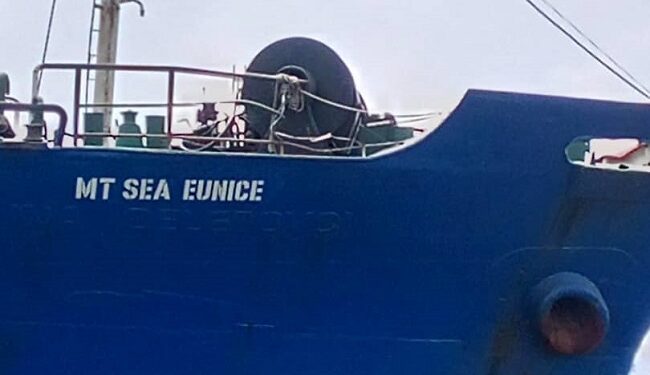
BY THE MARITIME EXECUTIVE
In another daring high-seas boarding, Spanish authorities have seized 4.5 tonnes of cocaine from an aging livestock carrier off the coast of the Canary Islands.
The waters of the mid-Atlantic near the Canary Islands are a favorite transshipment point for cocaine smugglers bringing cargoes from South America to Europe. The area is also within reach of Spanish shore-based counternarcotics teams, who search and seize smuggling vessels on the high seas with regularity.
Last week, Spain's National Police and Tax Agency Customs Surveillance Service intercepted the livestock carrier Orion V at a position about 50 nm to the southwest of the Canary Islands. The Togo-flagged vessel was nominally carrying 1,750 cattle on a voyage from Cartagena to Beirut.
A boarding team from the Tax Agency patrol ship Fulmar came alongside the Orion V and climbed the pilot ladder in heaving seas. The 28 crewmembers were arrested, and the vessel was diverted to port for an inspection. Search teams found 4.5 tonnes of cocaine hidden in the vessel's cattle feed silos.
The crew remains aboard the vessel under guard so that they can continue to care for the cattle, according to El Pais. The ultimate fate of the livestock is still under discussion.
The U.S. Drug Enforcement Agency, Spain's countersmuggling and counterterrorism centers, and the Togolese flag state authorities collaborated in the operation.
The 1973-built Orion V was built as a geared yard-and-stay freighter under the name of Vera Mukhina. She began a second life as a converted livestock carrier at some point after 2008, even though she was already past the typical age for demolition. She was purchased in 2022 by a buyer in Florida and reflagged to Togo.
Her recent port state control records are heavy on serious deficiencies, including issues with firefighting equipment, lifeboats, general cleanliness, deck corrosion, deck cracking and "dangerous areas." Port state inspectors in Cartagena, Colombia returned to the ship five times between her arrival in mid-November and her departure on January 7.
The seizure of the Orion V was the second major high-seas drug bust that the Fulmar completed in the span of a week. On January 18, her crew intercepted another Togo-flagged vessel, the Blume, and found 4.5 tonnes of cocaine on board. In addition, in early December the Fulmar intercepted a sailing yacht off the Canary Islands and seized 2.5 tonnes of cocaine.
by Mikhail Voytenko
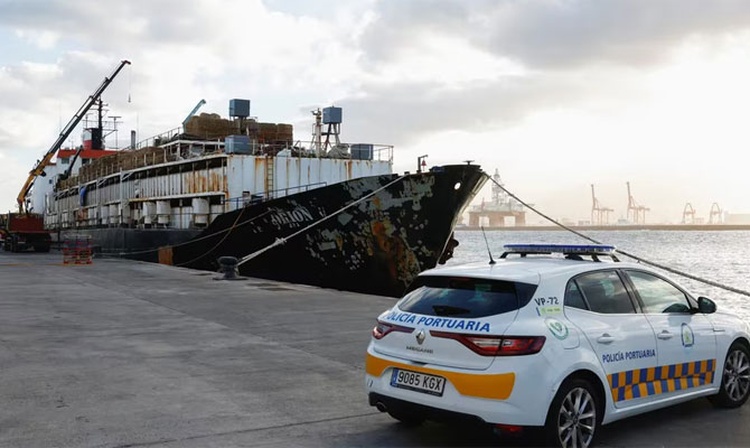
By Borja Suarez
MADRID, Jan 28 (Reuters) - Spanish police seized 4.5 tonnes of cocaine with an estimated street value of 105 million euros ($114 million) after raiding a cattle ship off the Canary Islands earlier this week, a statement said on Saturday.
The ship had stopped at ports in about a dozen countries before Tuesday’s raid, and police said drug smugglers had started using livestock ships because it was more difficult for police to trace their illicit cargo.
“International organizations are reinventing themselves to transport drugs from Latin America to Europe, using livestock to make the control and localisation more difficult,” the Spanish police statement said.
Police arrested 28 crew members on the Togo-flagged Orion V, which had been trailed from Colombia in an operation by Spanish authorities, the U.S. Drug Enforcement Administration and Togo police.
Officers unloaded dozens of boxes containing the cocaine on the port side in Las Palmas on the island of Gran Canaria.
($1 = 0.9202 euros)
(Additional reporting by Graham Keeley and Miguel GutierrezEditing by Helen Popper)
スペイン警察、家畜運搬船から1億1400万ドル相当のコカインを押収
ボルハ・スアレス
[マドリッド 1月28日 ロイター] - スペイン警察は今週初め、カナリア諸島沖の牛船を強制捜査した後、推定1億500万ユーロ(1億1400万ドル)のコカイン4.5トンを押収した。
船は火曜日の襲撃の前に約12カ国の港に停泊していた.警察は、警察が違法な貨物を追跡することがより困難だったため、麻薬密輸業者が家畜船を使用し始めたと述べた.
スペイン警察の声明は、「国際機関は、家畜を使ってラテンアメリカからヨーロッパに麻薬を輸送するために自らを改革し、管理と現地化をより困難にしている」と述べた.
警察は、スペイン当局、米国麻薬取締局、およびトーゴ警察による作戦でコロンビアから追跡されていた、トーゴ籍船のオリオン V の 28 人の乗組員を逮捕しました。
警官はグラン・カナリア島のラス・パルマスの左舷で、コカインが入った数十個の箱を降ろした。
ABC Newcastle / By Giselle Wakatama and Cecilia Connell

By admin In Insurance Marine News, Keep, Marine Liability, Political Risk, Credit & Finance
Cargo ship Blume (IMO 8649993) was intercepted by the Spanish Police, Civil Guard and Customs off the coast of the Western Sahara on January 18th. The vessel was taken to Santa Cruz de Tenerife on suspicion of drug trafficking.
After the ship arrived at Santa Cruz on January 19th, a search of the ship was reported to have discovered three tons of cocaine on board. All 15 crew members were arrested.
The ship had left Santos, Brazil on December 21st with an announced destination of Riga, Latvia with an ETA of February 15th.
2005-built, Togo-flagged, 2,994 gt Blume It is owned by Rentoor Chartering Ltd of Piraeus, Greece, and managed by Dignatio Corp of the same address. Last AIS was January 17th when the vessel was underway off the coast of West Africa.
日本語訳
スペイン当局が貨物船を阻止、麻薬が発見される
管理者 2023 年 1 月 23 日 In Insurance Marine News、Keep、Marine Liability、Political Risk、Credit & Finance
貨物船ブルーム(IMO 8649993) は、1 月 18日に西サハラ沖でスペインの警察、市民警備隊、および税関によって傍受されました。船は麻薬密売の疑いでサンタ・クルス・デ・テネリフェに連行された。
船が 1 月 19 日にサンタクルーズに到着した後、船内を捜索したところ、船内に 3 トンのコカインが発見されたと報告されています。15人の乗組員全員が逮捕されました。
船は 12 月 21 日にブラジルのサントスを出発し、2 月 15 日のETAでラトビアのリガに向かう予定でした。
2005 年建造、トーゴ籍船、2,994 トンの Blume ギリシャ、ピレウスの Rentoor Chartering Ltd が所有し、同じ住所の Dignatio Corp が管理しています。最後の AIS は、船が西アフリカ沖を航行中の1 月 17日でした。
Mikhail Voytenko
General cargo ship BLUME was intercepted and seized by joint Police, Civil Guard and Customs team on Jan 18 off Western Sahara coast, and taken to Santa Cruz de Tenerife, on suspicion of drug trafficking. She arrived at Santa Cruz on Jan 19, some 3 tons of cocaine were found after intensive ship’s search. All BLUME 15 crew were arrested. The ship left Santos Brazil on Dec 21, limping across Atlantic at some 4-6 knots speed. She’s bound for Riga, Latvia, with ETA Feb 15, according to AIS.
General cargo ship BLUME, IMO 8649993, dwt 4325, built 2005, flag Togo, manager DIGNATIO CORP (EQUASIS).
Ship operators at increased risk of drug smuggling(gard)
In the summer of 2019, Claudio Bozzo, chief operating officer of MSC Mediterranean Shipping Co, flew 4,000 miles from Geneva to Washington DC, for a meeting with US Customs and Border Protection. He’d been sent by MSC’s owner, a secretive 82-year-old billionaire named Gianluigi Aponte, to contain a crisis.
A few months earlier, more than 100 agents had boarded one of MSC’s ships, the Gayane, as it slid into the Port of Philadelphia for what was supposed to be a quick stop on its way to Rotterdam. Deep below deck, hidden in containers packed with wine and nuts, the agents discovered nearly 20 tons of cocaine, worth US$1 billion. The ensuing investigation showed that more than a third of the crew — all MSC employees — had helped transfer vast amounts of cocaine from speedboats at night while the ship powered through the open ocean off South America. It was the largest maritime drug bust in US history.
The crime was so big and brazen that authorities made the exceptional decision to seize not just the cocaine but also the Gayane itself, a 1,000-foot-long ship worth more than US$100 million. During Bozzo’s meeting with the CBP in the limestone Ronald Reagan Building, he apologised for the ordeal and said the crew’s actions had come as a surprise, according to a person familiar with the events. He extolled MSC’s growth from humble beginnings into the world’s largest shipping company and impressed upon the officials how seriously the Aponte family takes the responsibility of running a fleet that accounts for nearly 20 percent of all seaborne container trade.
For US officials, the company’s claim of ignorance didn’t add up. Years before the Gayane was boarded, law enforcement authorities in multiple countries had been monitoring MSC’s vessels and crews, a Bloomberg Businessweek investigation found. US authorities had not only been tracking the Gayane long before it entered US waters, but they also had previously boarded and searched several other MSC ships as part of a broader investigation into an international cocaine-trafficking ring that had burrowed into the shipping company. Using clues collected during those boardings, as well as intelligence gathered in Eastern Europe, they identified the powerful Balkan Cartel as the architect behind the massive shipments. Authorities in the United States and Europe also concluded that the syndicate, which controls more than half of the cocaine flowing into Europe, had infiltrated MSC’s crews over a decade, exploiting its manpower and vessels to help build a cocaine smuggling empire.
“We certainly didn’t see MSC as a victim in all this,” says William McSwain, former US attorney for the Eastern District of Pennsylvania, who presided over the Gayane case until he left the office in January 2021.
Out of view
MSC and the US government are now locked in a legal battle that has taken place largely out of public view. Customs officials have been pressing the company to pay more than US$700 million in penalties, according to multiple law enforcement sources who spoke on the condition of anonymity about the non-public administrative proceedings. Prosecutors in the US Attorney’s Office for the Eastern District of Pennsylvania, meanwhile, are building a civil case arguing that MSC, as the operator of the Gayane, bears responsibility for the drug trafficking and must forfeit the vessel or a substantial portion of its value. While MSC concedes that record amounts of cocaine were found aboard its ship, it disputes key aspects of the government’s version of events and argues that it was the victim of traffickers, not a co-conspirator.
A spokesman for MSC, Giles Broom, says that the company has always taken narco-trafficking seriously, but that the Gayane “incident showed a new level of security threat that we and, as far as we know, the container shipping industry were not yet ready to face.” Today, he says, MSC is regarded as “by far the industry leader in anti-smuggling efforts.” Still, “there is a limit to what anybody should expect from a company and from civilians doing their job: We are not a law enforcement body and we are not mandated, resourced or trained to confront dangerous organised criminal groups.”
Businessweek’s investigation is based on interviews with more than 100 people in a dozen countries, including current and former law enforcement officials and people familiar with MSC’s business, as well as a review of trafficking cases in multiple countries. Many of the sources requested anonymity to discuss confidential details of ongoing or past investigations.
Every shipping company that runs routes from South America to Europe is at risk of being preyed on by cocaine-traffickers. But MSC made for a uniquely attractive target, officials say. It dominates routes that double as cocaine superhighways, primarily those used to haul fresh fruit and vegetables from South America to Northern Europe. It’s also the world’s largest employer of seafarers from Montenegro, a home to the Balkan Cartel. Years before the Gayane seizure, European police officials had warned MSC that its crews had been infiltrated. Yet the steps executives took to mitigate the problem fell woefully short, officials on both sides of the Atlantic say.
The situation has frustrated law enforcement and customs officials as record quantities of cocaine deluge global ports, especially in Europe. US prosecutors aren’t alleging that MSC’s leadership was involved in or benefited from the trafficking, but they’re trying to learn more about the breakdowns in the company’s hiring and security protocols, according to two senior officials involved. Investigators in the US and Europe say they keep coming back to a central question: Why have criminal organisations apparently been able to control key operations aboard some of the company’s ships for so long? “How high the influence of the narco-traffickers lay within this company is unquestionably something that from Day 1 was of great interest to the US government,” says Robert Perez, who was deputy commissioner at CBP from 2018 to July 2021.
It’s rare for a shipping company to incur serious penalties for drugs found aboard its vessels. When fines are imposed in the US, regulators frequently let a carrier negotiate them down. In Europe, fines are rarely imposed at all. Although there are international security requirements for shipping companies, customs and law enforcement officials have little power to hold the companies accountable. All of that has allowed the shipping industry, the primary engine of globalisation, to escape major consequences as it has become increasingly entangled in drug-trafficking.
Until the Gayane sailed into Philadelphia in the summer of 2019.
Inner workings
Despite the name, Mediterranean Shipping Co is based far from the spray of the sea, in a quiet neighbourhood of Geneva. Even in a notoriously insular industry, MSC’s inner workings are especially difficult to decipher. It’s one of the few major shipping companies that’s not publicly traded. It operates a cruise line that publishes annual results, but its cargo business doesn’t release financial statements. Aponte also owns a maze of hundreds of related entities that oversee ferry operators, speedboat manufacturers, shipping terminals, even a private island in the Bahamas.
Aponte is slight, with a head of silver hair, icy eyes and an aristocratic bearing. He remains the chairman of MSC Group. His son, Diego, is president. His daughter, Alexa, is chief financial officer. Two years ago, following the Gayane seizure, he tapped Soren Toft, a longtime executive at rival AP Moller-Maersk A/S, to be chief executive officer of MSC’s cargo business, the first time an outsider has occupied the seat.
The family likes to say seawater runs through their veins, citing shipping documents from the 17th century that bear their name. Aponte was born in tiny Sant’Agnello, on the Bay of Naples; his family sailed goods and passengers across its waters. He also became a seafarer, training as a ship captain and working under Achille Lauro, a former mayor of Naples and shipping magnate. He sailed on vaporetti that ferried wealthy tourists to nearby island resorts such as Capri and Ischia. It was on one of those trips that Aponte met his future wife, Rafaela Diamant, the daughter of a Swiss banker.
In 1970, Aponte purchased an old German break-bulk ship and started MSC. The following year he bought a second used vessel, naming it after his wife. He eventually began buying container ships. When Aponte entered the business, shipping was dominated by legacy companies such as Maersk and Hapag-Lloyd, whose pedigrees dated to the 1800s. He carved out a niche by taking on underserved routes. He also developed a shrewd business model, buying up secondhand container ships, some from scrap yards, then rehabbing them and sending them back out to sea. MSC also distinguished itself by emphasising price over speed of delivery. “MSC, very often in the early years, the inside joke in the industry was that it was shorthand for ‘maybe ship comes,’ ” says Lars Jensen, founder of the consulting firm Vespucci Maritime and a former executive for Maersk. “Your cargo would get there eventually, but you wouldn’t quite know when.”
These strategies allowed him to expand an empire almost entirely organically, rather than via acquisitions, as most of his rivals did. Over time, MSC added routes covering Asia, the United States and South America, and by the early 2000s its motto was “Land covers one-third of the Earth — we cover the rest.”
But as Aponte was building MSC, a powerful criminal organisation was building a maritime operation of its own.
Just after midnight on May 30, 2010, the MSC Oriane was cruising through the English Channel on its way to Antwerp, Belgium, when a nearby lobster fishing boat called the Galwad-Y-Mor began a series of odd manoeuvres, moving first in front of, then behind, the giant cargo vessel. As the Galwad approached, according to UK prosecutors, the Oriane’s crew tossed overboard 11 waterproof duffel bags containing a total of 255 kilos of cocaine worth about US$80 million. After collecting the duffels, the four men on the Galwad, including one from Montenegro, sailed to nearby Freshwater Bay, where they used metal weights to submerge the drugs and connect them to a buoy for later pickup by traffickers.
They never got the chance. UK anti-drug police had been monitoring the operation, and they arrested the men on the Galwad, along with an accomplice. The following year, all five were sentenced to lengthy prison terms. The fishermen continue to maintain their innocence more than a decade later.
Links to Balkans
Behind the scenes, the incident triggered a European investigation into the infiltration of shipping companies by organised crime, according to a person familiar with the matter. Checking with police in Spain, Belgium and the Netherlands, UK authorities learned that the Oriane wasn’t a one-off. Each of those countries had seen operations in which cocaine was carried across the Atlantic on commercial container ships owned by various companies, then transferred to smaller vessels before the cargo arrived in port. These manoeuvres, known as drop-offs, let traffickers avoid official ports of entry, where the chances of seizure were greater, but it meant they needed to recruit crew members aboard commercial cargo vessels, paying them to toss drugs over the side.
UK authorities took the case to Europol, which coordinates cross-border criminal probes among European Union members. Around 2012, agents from the UK, Spain, Belgium and the Netherlands met and agreed to gather all the information they had on drop-offs and to enter case details in Europol’s intelligence-sharing database. It emerged that while several major companies had been used, one name came up frequently: MSC.
Various European trafficking organisations used drop-offs, but they were known to be a specialty of the Balkan Cartel, a rising force in the international cocaine trade. The cartel is a constellation of gangs in five countries, bound by a common language, Serbo-Croatian. Many began as private military groups during the Balkan War of the 1990s, pivoting afterward to weapons trafficking, cigarette smuggling, auto theft and money-laundering. Among their ranks are ex-cops and former intelligence operatives. Their factions cooperate but also compete. Some have gained a reputation for brutality — last year a police raid in a Belgrade suburb uncovered an industrial meat grinder with traces of human DNA.
Although the cartel operates all manner of criminal schemes, US officials say its revenue comes mainly from cocaine. The gangs are also innovators. In the early 2000s they began stitching together a logistics network that stretched across the Atlantic. In South America, they embedded members with producers, cultivating relationships right down to individual labs deep in the jungle. In Europe, they built a wholesale distribution network. And in the early days, they sometimes filled out their supply chain by acquiring their own ships. Most of the time, the ships would transport legitimate loads of soybeans or other bulk commodities. For illicit loads, the traffickers would bring in a dirty captain and crew.
Then the Balkan Cartel doubled down on what current and former law enforcement officials say was a primary competitive advantage: Balkan sailors. Many came from Montenegro, a tiny nation on the Adriatic Sea that has a maritime tradition dating back centuries and several schools that train and accredit seafarers. Even high schools there prepare students for a career at sea. This created a very attractive recruiting pool for the criminal gangs that were leveraging the high seas for their trafficking operations.
In many respects, the Oriane case had the telltale signs of earlier Balkan smuggling operations that used their own ships and crews. Now, to Europol investigators, it looked as though the traffickers had instead started planting their corrupt crews on the vessels of major shipping companies.
By 2013 other countries in Europe had come to suspect that the cartel had found a way into MSC’s crewing operation. The findings of their investigations were considered highly sensitive, but they occasionally emerged in public. That November the Montenegrin police directorate published a 100-page report on Balkan organised crime, a portion of which was dedicated to cocaine trafficking. Gangs in the area, it read, “have developed networks of temporary members which usually consist of seafarers from Montenegro, Serbia and Croatia, who are mainly employed on container ships of the MSC company.”
The following year, Spanish police began tracking a gang of Montenegrin and Serbian traffickers who were arranging for cocaine shipments to be carried across the Atlantic on MSC ships and dropped by the crew off the coast of Europe. Court records detail how the group’s contacts in South America controlled “an immense fleet of seamen hired from MSC ships” who could help traffic large quantities of cocaine to Northern Europe. Another report from the Montenegrin police directorate, this one in 2015, said the main mode of cocaine smuggling for Balkan organised crime groups remained “container ships of the MSC company, covering the South America—Western European line.”
Around 2016, officers from the Netherlands, Belgium and the UK approached MSC’s management, with senior Dutch police taking the lead. They provided the company with select details gathered from the investigations and asked for help curbing the drop-offs. MSC was told that the Balkan Cartel had used a crewing agency in the region to get corrupt sailors on board its ships, according to Jan Janse, police chief for the Port of Rotterdam, whose team was involved in the outreach.
The company also got a warning. “We told them what we saw. And we told them that it had to stop,” Janse says. “And if it wouldn’t stop, we told them that there would be the risk that we would do what the United States did later, which was seize their ships.”
It’s unclear what MSC did with the information. Broom, the spokesman, says the company doesn’t have a record of such a meeting taking place in Geneva in 2016. “MSC has met over many years with various customs and law enforcement authorities to discuss drug-trafficking risks as part of our collaborations in many countries,” he says.
Janse says he believes the company took extra security measures and switched the crewing agency it used in the Balkans. Dutch anti-drug police began to see fewer drop-offs, and the technique eventually disappeared almost entirely. But the smugglers only grew more sophisticated.
By 2016, record quantities of cocaine were arriving in Northern Europe, partly because of increased production in South America. There was evidence that traffickers were forgoing the customary passage through Spain in favour of large commercial container ports in Belgium and the Netherlands. For the first time, Belgium surpassed Spain as the country with the largest quantity of cocaine seized, according to an EU drug report.
The same year, Panama completed a US$5.4-billion expansion of the Panama Canal. Formerly 33 metres (108 feet) at its narrowest, it was now at least 55 metres wide, granting access to supersize ships and tripling the volume of cargo that could pass through. Businesses cheered the expansion, but Jürgen Stock, the secretary-general of Interpol, warned in a speech in Panama a month after the project’s completion that it could hasten the flow of cocaine across the Atlantic.
New routes
MSC began operating a route that capitalised on the enlarged canal. Several of its largest ships would load up on fruits and vegetables in Chile, Peru and Colombia, then make stopovers in the Bahamas and Philadelphia before crossing the Atlantic to the massive ports of Northern Europe. Then they’d circle back. Port officials in Philadelphia dubbed the route the Philadelphia Express and said it would boost the local economy and transform the region into a major gateway for fresh produce on the East Coast. Within months, MSC’s behemoth ships were snaking up the Delaware River, laden with blueberries, mangoes and asparagus. The company’s container capacity going from South America’s Pacific coast to Europe nearly tripled from June 2016 to June 2019, according to BlueWater Reporting. By 2019, MSC accounted for almost half of all container capacity on those routes.
MSC’s new routes ended up opening commercial opportunities for traffickers, as well. There’s an old drug agent adage: Smugglers are in the logistics business. Here, traffickers were able to gain many of the same efficiencies as established shipping companies simply by inserting their goods into the massive flow of containerised cargo. Most of the cocaine that enters the US comes over land, through Mexico. But geography stipulates that Europe get it by air or by sea, and by 2016 most of it arrived there by commercial cargo ship.
As the cocaine surge to the continent turned into a crisis, European officials offered to share more information about seizures with their American counterparts. Immediately one fact stood out: Some ships known to have carried cocaine to Europe were stopping briefly in US ports. And some of those were MSC ships sailing through Philadelphia.
The main investigative arm of the US Department of Homeland Security, known as Homeland Security Investigations, began working with European partners to analyse major cocaine busts, especially those at the ports of Antwerp and Rotterdam. HSI agents tapped into data collected by customs authorities on shipping manifests and vessel movements in South America. They learned that while Europe-bound cocaine had mostly come from South America’s east coast, especially from Brazil, over the past few years the trend had begun to shift. Now much of the cocaine heading to Europe originated in and around west coast ports, such as Callao in Peru and Guayaquil in Ecuador.
At first, investigators assumed the drug was being smuggled through traditional methods, such as hiding it alongside legitimate cargo that’s being packed at warehouses or farms, or the “blind hook,” in which accomplices break into containers and stash cocaine inside. Beginning around 2017, HSI spent months trying to uncover the traffickers’ methods, first in Colombia and then Panama, according to two people familiar with the probe, but the agents kept hitting dead ends.
HSI, along with US customs agents, began boarding cargo vessels as they neared Philadelphia, examining crew quarters, engine rooms, even one ship’s propeller shaft, mostly without luck. But the searches also allowed them to isolate individual crew members in an effort to develop sources aboard the ships, according to one former senior US official.
By 2018, the official says, investigators had concluded that the traffickers weren’t using the traditional smuggling methods at all. Instead, they were using Balkan crew aboard MSC cargo vessels to load the drugs while the ships were at sea. Investigators worked every angle to get inside that network, tapping communications and cultivating informants. Finally, they had the opening they needed.
By the time Aleksandar Kavaja started preparing for his upcoming voyage aboard the MSC Gayane in the spring of 2019, his hometown of Bar, Montenegro, was an established recruiting ground for the Balkan Cartel. Locals say it wasn’t hard to guess which sailors might be in on the cocaine trade—they were likely the ones with Maseratis and new homes overlooking the Adriatic.
Bar, a small, ancient city dotted with beaches and olive groves, is home to Montenegro’s largest seaport, where MSC is ubiquitous. It’s a stop for the company’s cruise line, and MSC also operates a crew training center just to the north—one of four it runs worldwide, with the others in India, Italy and Ukraine. Of the 6,000 seafarers in Montenegro, about 2,250 work for MSC, according to Mimo Draskovic, head of the maritime management study program at the Faculty of Maritime Studies in Kotor.
Kavaja was among them. He’d grown up on the outskirts of Bar, on a farm that had been in his family for generations. His mother, Ranka, worked at a local soup kitchen, and his father, Radoslav, earned money by fashioning trinkets from seashells and selling them to tourists. Aleksandar’s grandfather had been a sailor, so his family was thrilled when he graduated and landed a job with MSC. He would earn a salary of about €4,500 a month (US$4,750), more than 10 times what his parents were earning. In 2015, at age 21, Aleksandar went to sea.
Over the next several years, he sailed on at least four MSC ships—the Lorena, the Diana, the Deila, the Erica—installing, wiring and repairing electrical equipment as the vessels made stops in South Korea, Panama, Malta and other far-flung places. He didn’t love the job or the months away from his family. “He’s not a sailor at heart,” his mother says. But he was committed to supporting his family financially.
One day in mid-April 2019, Kavaja had lunch in a coffee shop in Bar. He was due to board the Gayane at the Port of Antwerp in a few days, for what would be his sixth journey aboard an MSC ship. After finishing his meal, he stepped outside and was approached by a man he didn’t know. “We know who you are, we know who your family is,” the man said, according to US court records. “We know that you’re going to leave on that ship in five days.”
The man held out a mobile “narco” phone, as prosecutors referred to it in court filings, and told Kavaja he had a choice. He could either take the phone and agree to follow orders, or he would risk his and his family’s safety. If he agreed, he would be paid US$50,000, nearly a year’s salary.
He took the phone.
Two months before Kavaja set foot on the Gayane, drug agents got information that there was cocaine on board another MSC ship, the Carlotta, according to a person with knowledge of the probe. The ship was on its way to the port of Newark, New Jersey, which MSC sometimes uses as a back-up to Philadelphia. When the Carlotta arrived, agents searched the vessel and found 3,200 pounds of cocaine stashed in a container of dried fruit. It was the largest drug seizure in Newark in 25 years.
The load’s size garnered immediate attention, and resources poured into the investigation from HSI and the US Drug Enforcement Administration. Homeland Security agents in New York began working with the DEA’s international division, which had tracked the Balkan Cartel for years from its office in Croatia.
Fresh clues
The Newark bust yielded fresh clues. Investigators collected data from some of the Carlotta’s refrigerated containers, which track sudden changes in interior temperature. The data indicated that some of the containers had been opened while the ship was underway. It “showed pretty clearly that something was going on at sea,” says a person familiar with the probe.
During the search of another MSC cargo ship that spring, agents found a small two-way radio in a crewman’s cabin, according to a person with knowledge of the discovery. The radio used a frequency typical of small craft, and the captain told investigators there was no reason the device should have been aboard a commercial cargo ship. HSI questioned the crewman, who was from the Balkans, but he wasn’t arrested. During other searches, investigators found evidence that someone on board the ships had snipped a wire, overriding a device limiting the weight small cranes at the stern could lift.
A second major US seizure took place on March 19, this time on board the MSC Desiree in Philadelphia. Customs officials found more than a half ton of cocaine, the largest amount seized in Philadelphia in almost two decades. Agents ultimately identified at least four MSC ships where they believed crew members were involved in smuggling cocaine: the Carlotta and the Desiree, plus the Avni and the Gayane.
US agents weren’t the only ones finding drugs. In April, Peruvian authorities discovered 2.4 tons of cocaine stuffed into 64 suitcases and bags aboard the Carlotta, which had apparently gone right back to carrying drugs. Authorities in Panama then found 1.3 tons of cocaine during a search of the Avni. (US investigators had also suspected that cocaine was on the ship and planned to search it in Philadelphia, according to two people familiar with the investigation, but the Panamanians beat them to it.)
The crew members’ roles on the vessels gave the traffickers a huge advantage. The sailors had access to key data, such as container locations and destinations, which investigators later said allowed them to pick boxes that had room to stash large amounts of cocaine and that were less likely to trigger a customs search once they arrived in port. That posed an enormous challenge for US authorities, since drugs could be located virtually anywhere in a sea of boxes on the ship.
Searching a fully loaded ship is difficult, so much so that it’s rarely done. Holds are cramped and containers can be difficult to get to. The agents acquired special oxygen monitoring devices in case they had to go deep beneath the deck, where rusted iron can deplete oxygen levels. They assembled a group of drug-sniffing dogs and obtained cameras that could be snaked into a loaded container to find cocaine.
The agents also began quietly briefing the partners they’d need to conduct a full vessel search: the US Coast Guard, the Delaware State Police, Philadelphia city cops, even a maritime-trained SWAT team. All they lacked was the last-minute intelligence that would tell them which ship to search. By the time the Gayane arrived in Philadelphia that June, everything was in place.
As the Gayane was sailing southbound from Panama, Kavaja’s narco phone rang. When he picked up, according to his lawyer, a man told him to report to the upper deck. Kavaja did so and found other crew members there waiting.
Court records show that three others had been recruited in Montenegro before boarding the ship. Kavaja’s role was to phone traffickers carrying cocaine on speedboats and communicate the Gayane’s position so they could locate it at night. He also recruited others to help move the heavy loads. In total, at least 8 of the 22 crew members aboard the Gayane — six from Montenegro, two from Samoa — handled the job. Each stood to make US$50,000 or substantially more, depending on their role.
While the Gayane was just off the coast of Peru, according to court records, a Montenegrin seafarer named Bosko Markovic helped assemble the crew members, who waited on the deck alongside four men in ski masks. Markovic was the ship’s first officer, one rank below the captain and in charge of the cargo and deck crew. A speedboat had just pulled up alongside the hulking vessel. Another Montenegrin, Ivan Durasevic, the ship’s second mate and third in command, operated a small crane, hoisting up giant nets stuffed with black duffel bags and bales of cocaine. Once the nets were on deck, the other crew pushed the drugs to a hold on the vessel. The men broke into a series of containers by cutting the security seal on each one. After stashing the cocaine inside, they resecured the containers with a fake seal, complete with the MSC logo. Sometimes they had to cut steel cables or bend metal railings to squeeze in the cocaine, then use welding irons and paint to disguise the damage.
Over the next several nights, as the Gayane sailed south, the ship was met by at least six speedboats, according to court records. It never stopped moving. It didn’t even appear to slow down, according to law enforcement officials. The job was carried out as the vessel powered through the open ocean — an incredible feat of seamanship.
By June, the Gayane had made its southernmost stop, at a small port in the Bay of Concepción near Coronel, Chile, and begun the return journey. When the vessel hit the coast of Peru again and made its northbound journey to Panama, it was approached by at least eight more speedboats. The night-time hoisting and heaving resumed.
On the afternoon of June 16, the Gayane was in US territorial waters, bound for Philadelphia. As it entered Delaware Bay, the Coast Guard contacted the captain and directed the ship to head for an area called Big Stone Anchorage. Commercial vessels normally stop there to await an authorized riverboat captain who can navigate a local channel. But as the Gayane pulled in, three patrol boats and a helicopter approached the ship, and a team of law enforcement officers ascended its Jacob’s ladder.
Some agents rounded up crew in the galley, while others headed for the bridge to find schematics for the vessel. The search for drugs started with the above-deck containers while the Gayane was still in the bay. At around 3am on June 17, the ship reached Philadelphia’s Packer Avenue Marine Terminal, within view of the spring-green Walt Whitman Bridge. More than 100 agents were waiting. They believed there was cocaine on board, but they didn’t know where it was. A team began swabbing the crew’s hands for traces of the drug. Several tested positive.
At around 7am, just as the sun rose over the bay, agents got their first strike: a stash of bricks tucked into burlap sacks inside a container. Joseph Martella, CBP’s port director, was off the day the Gayane arrived in Philadelphia, but he was carefully monitoring his phone and headed to the port. Just after 10am, a second container full of cocaine was found. Martella then made the unusual decision to offload and physically inspect every one of the 4,000 containers on the ship.
After nearly a week of work, the government had dug through loads of wine, dried nuts and scrap batteries to identify seven containers that carried cocaine. Customs officials spent days weighing the drugs, counting the bricks and logging it all into evidence. At one point, as the agents rushed to finish their task, they looked around and saw white dust everywhere, Martella recalls. One of the agents realised it wasn’t ordinary dust and instructed everybody to mask up.
In total, the haul consisted of more than 15,000 bricks of cocaine, weighing nearly 20 tons and with an estimated street value exceeding US$1 billion. The authorities were alarmed not only by the sheer quantity of drugs but also by the audacity of the operation. The leader of the onboard scheme, the first officer, had been in charge of the crew’s schedule, allowing the co-conspirators to be on duty at the same time. And both he and the second officer had access to key details about the containers, according to court records. (The captain of the Gayane was questioned by a grand jury but never arrested or charged.)
'Aware of reports'
On June 18, two days after the Gayane was detained, MSC released a public statement. “MSC Mediterranean Shipping Company is aware of reports of an incident at the Port of Philadelphia in which US authorities made a seizure of illicit cargo,” it said. “MSC takes this matter very seriously and is grateful to the authorities for identifying any suspected abuse of its services. Unfortunately, shipping and logistics companies are from time to time affected by trafficking problems.”
Over the following 10 days, agents continued to interview the crew members, who remained sequestered on the ship. They pulled the sailors off one at a time, interviewing them for hours as they pieced the operation together. At first, the story the crew told about hoisting five elephants’ worth of cocaine off speedboats while the ship coursed through the waves seemed far-fetched. But prosecutors obtained a warrant to seize the ship’s voyage data recorder, which contained information on the vessel and its movements, and on it they found radar images indicating the various points at which small boats had approached the Gayane and remained alongside, three officials say.
Seizing a ship is an extreme measure, but the revelations about the crew members’ involvement in trafficking so much cocaine emboldened authorities. On the morning of July 4, CBP agents boarded the Gayane and handed the captain a seizure warrant. At nearly the same moment, notice of the seizure was emailed to MSC executives. “When a vessel brings such an outrageous amount of deadly drugs into Philadelphia waters, my office and our agency partners will pursue the most severe consequences possible,” said US Attorney McSwain in an announcement.
MSC moved swiftly to get its very expensive cargo ship sailing again. In exchange for a US$10-million cash payment, as well as a US$40-million bond and promises that the company would cooperate with any ongoing investigation, the Gayane was allowed to continue to its original destination of Rotterdam. On July 13, almost a month after being detained, the ship was out on bail.
By the time Bozzo, the MSC executive, arrived in Washington on August 27, the potential for long-term harm to the company was mounting. Customs officials had suspended the “trusted trader” status granted to MSC under a September 11-era program,e that allows carriers to avoid lengthy screenings and delays at US ports in exchange for observing certain security protocols. Meanwhile, prosecutors in the Eastern District of Pennsylvania brought criminal charges against the eight crew members, including Kavaja and the first and second officers. All of them would eventually plead guilty and be sentenced to time in federal prison. Behind the scenes, US authorities identified a faction of the Balkan Cartel that had financed and organised the operation, learning that the gang had brought in partners from Colombia and Northern Europe to share the risk. So many groups had a share of the Gayane’s cocaine that one US law enforcement official described it as the trafficking equivalent of an Amazon truck.
Over the next several months the government entered discussions with MSC, with the aim of getting it to agree to new security measures, such as rotating crews more frequently and requiring them to take polygraph tests. In exchange, the US government held out the prospect that it would substantially reduce the fines MSC was facing. Including the earlier seizures aboard the Carlotta and the Desiree, those now totaLled more than US$700 million, based on the statutory penalty of US$1,000 per ounce of cocaine.
The focus of federal prosecutors now shifted to a civil forfeiture investigation — a step designed to recover proceeds used in the commission of a crime. Although the use of the Gayane in a crime was an established fact, MSC could mount an “innocent owner” defence. It would require the company to show that it couldn’t have anticipated the use of its vessel to traffic cocaine or that it had taken reasonable steps to prevent such conduct.
By the fall of 2020, it had become clear that MSC wasn’t ready to strike a deal with the government. The company informed CBP that it planned to contest the penalties connected to the Gayane, as well as the Carlotta and the Desiree. Company lawyers also presented customs officials with findings of an internal investigation it had conducted. “MSC does not dispute that US authorities found almost 20 tonnes of cocaine at the Port of Philadelphia,” says Broom, the company spokesman. “But MSC’s investigation has led us to the conclusion that the majority of that cocaine was not, and could not have been, loaded at sea.” MSC didn’t give further details about where and how it believes the drugs were loaded.
If the company were to demonstrate that some portion of the cocaine was loaded on land, indicating that its employees played a lesser role in the scheme, the government could have a more difficult time justifying harsh penalties. It could also serve as evidence if the forfeiture matter ever went to trial. According to one US official involved in the investigation, though, MSC’s claims contradict facts already established in court as part of the crew’s guilty pleas and sentencing proceedings. “That position is directly at odds with the factual findings of the court,” the official says.
The government is also pursuing a wider criminal investigation against members of the Balkan Cartel who are believed to have orchestrated the Gayane operation. On October 30, Goran Gogic, a Montenegrin former heavyweight boxer, was apprehended at Miami International Airport before he could board a flight to Switzerland. In an indictment, prosecutors accused him of organising logistics for cocaine smuggling aboard commercial container ships on behalf of the Balkan Cartel, including on the Carlotta, the Desiree and the Gayane. According to one person familiar with the investigation, Gogic is “probably two or three levels down from the person who pulled all this together.” Gogic’s attorney says his client maintains his innocence.
The Gayane ordeal could serve as an inflection point for the industry. Janse, the Dutch police official, likens the situation to the one faced by banks two decades ago, when regulations across multiple countries forced them to better track the criminal activities of their clients and adhere to strict compliance standards. It was a profound change in the way they did business, and it cost them billions of dollars. “I was involved in combating money-laundering 30 years ago, and all the banks used to say that they couldn’t look at clients’ money and say it comes from criminality,” Janse says. “None of them say that now. And that’s the thing we have to do with all the shipping companies.”
If there were ever a moment for shipping companies to spend more money to curb trafficking aboard their vessels, now would be it. When demand for consumer goods rebounded from the initial pandemic crash, cargo prices surged, and the companies enjoyed a once-in-a-generation windfall. They pulled in a record US$217 billion in profit in 2021 and are on track to make US$275 billion this year, according to Drewry Shipping Consultants Ltd. Aponte’s personal wealth more than doubled during the pandemic, to US$19 billion, according to the Bloomberg Billionaires Index. And MSC went on a ship-buying spree, purchasing 128 secondhand container ships between 2020 and 2021, expanding its fleet to 645 and passing Maersk as the leading shipping line, according to industry data provider Alphaliner.
While MSC says it has long taken security seriously, it concedes that the Gayane was a “wake-up call.” After the incident, the company said it would spend US$100 million over five years on anti-smuggling security upgrades. It says it now uses guard patrols on vessels sailing along the west coast of South America, drug-sniffing dogs at high-risk ports and remotely monitored cameras on its vessels. Earlier this year, Bozzo, the chief operating officer, helped arrange an industry-sponsored conference with the United Nations and the World Customs Organization to discuss ways to better tackle narcotics-trafficking. And MSC has made one other big change, according to a person familiar with its internal decision-making: Montenegrin seafarers are no longer used on its ships crossing the Panama Canal.
Meanwhile, the Gayane continues to navigate the world’s oceans. It stopped recently in Thailand, Saudi Arabia, Egypt and Portugal — far from the sea lanes of South America.
Eight American cruise ship passengers were taken in to custody after they allegedly tried to leave Jamaica with US$850,000 worth of cocaine.
Reports are that the eight people disembarked the vessel which arrived in Ocho Rios from Miami, Florida on Wednesday.
About 1:30 pm, they were re-boarding the vessel for departure, and anomalies were reportedly detected in their luggage.
During a search conducted by members of the Narcotics Division, a total of twenty-four packages containing cocaine weighing just over 17 kilograms (38 pounds) were found concealed in their bags.
The passengers were arrested for breaches of the Dangerous Drugs Act.
Police say their identities are being withheld pending further investigations.
Investigations are ongoing.
以前からもあるが、コンテナに荷物と一緒に混載する方法に戻りつつあるのか?
3月横浜港に入港したコンテナ船の積み荷から、大量のコカインが見つかっていたことが分かりました。押収量としては国内最多の700キロ分に及ぶとみられています。
横浜税関によりますと、3月30日に横浜港に入港した船のコンテナから、バナナなどと一緒に隠されたコカインが、袋に小分けされた状態で見つかりました。 一部はまだ検査中ですが、同様の袋はおよそ700キロ分発見されていて、全てコカインと判明すれば末端価格にして140億円相当、国内でも過去最多の押収量だということです。
横浜税関は引き続き分析を進めるとともに、国際的な密輸組織が関与しているとみて、関税法違反の疑いで調べています。
以前から九州エリアのセキュリティーは甘いと思っているので驚かない。
熊本県天草市で今月、覚醒剤約590キロ(末端価格約354億円)が押収され、台湾人と日本人計13人が覚醒剤取締法違反容疑で逮捕された事件は、日本の警察、海上保安庁、税関などの関係機関と、台湾当局との連携で覚醒剤の国内流入を阻止した。一度の押収量としては過去3番目に多く、日台の捜査当局は、国際的な密売組織が関与した疑いもあるとみて捜査を進めている。
繰り返し渡航
「薬物の密輸が行われそうだ」。今年6月、台湾の海巡署(海上保安庁に相当)から日本側に情報が寄せられた。これが捜査の端緒となった。日台の関係機関は昨年12月、密輸対策で連携する覚書を交わしていた。
台湾の警察当局によると、台湾人の会社役員黄奕達容疑者(43)が国際的な密輸を計画しているとの情報を入手。黄容疑者が日本に繰り返し渡航していることもわかった。
福岡県警や第7管区海上保安本部(北九州市)などは、海上で船から荷物を受け取る「瀬取り」で密輸が行われるとみて捜査を進めた。黄容疑者らを追う中で、台湾人の漁業洪福財容疑者(68)らが宮崎県内のホテルを転々としながら、宮崎市内の港に係留されている漁船に出入りしていることを確認した。
急きょ天草へ
捜査関係者によると、11月にも不審な動きはあった。この時は、漁船が宮崎市内を出港後、悪天候のためにそのまま帰港した。そして、今月に入り、同じ船が再び出港。海保はレーダーなどで追跡し、捜査員らは南九州地方や沖縄で警戒した。
今月10日、黄容疑者と日本で接触するなど、密輸計画への関与が疑われていた台湾人デザイナー孫●皓容疑者(38)が、福岡からレンタカーで天草に向かった。捜査員らも天草に集結した。(●は日ヘンに「均」のつくり)
翌11日、宮崎市を出港していた漁船は天草沖数十キロの海上を燃料切れで漂流していた。近くを通った別の船に救助され、天草市の魚貫(おにき)港にえい航された。駆けつけた捜査員らが、漁船の船倉にあった麻袋の中から覚醒剤を見つけた。乗船していた洪容疑者ら3人が覚醒剤取締法違反容疑で現行犯逮捕された。
福岡県警などは、漁船は東シナ海の公海上で、外国船から覚醒剤を受け取ったとみている。
東南アジアで密造?
県警などは17日までに、孫容疑者や無職吉田樹矢容疑者(33)ら10人を密輸計画に関わったとして次々に逮捕し、逮捕者は13人になった。吉田容疑者は指定暴力団住吉会傘下組織の親交者で、陸揚げ後の運搬役だったとみられる。他にも、別の指定暴力団の傘下組織元組長がいた。
天草市内ではレンタカーの保冷車も見つかった。捜査関係者によると、覚醒剤の運搬に使用される可能性があったという。逮捕された13人は「覚醒剤とは知らなかった」「密輸とは聞いていなかった」などと供述している。
台湾の捜査関係者によると、覚醒剤は台湾への持ち込みが確認されていないという。タイ、ミャンマー、ラオスの国境付近の「ゴールデン・トライアングル」と呼ばれる地域で密造された可能性があるといい、日台の捜査当局は今後も捜査を進める。
横山翼 緒方健二
熊本県天草市の漁港に係留した船内から大量の覚醒剤が見つかった事件で、福岡県警などによる逮捕者の中に複数の指定暴力団の関係者がいることが、捜査関係者への取材でわかった。暴力団同士が協力していた可能性があるという。
覚醒剤が重すぎて?運搬船が燃料切れ 熊本の密輸事件
県警などは台湾人2人や広島県東広島市の無職少年(19)を覚醒剤取締法違反(営利目的所持)容疑で現行犯逮捕。別の10人も同法違反(営利目的輸入予備)容疑で逮捕した。13人は容疑をおおむね否認している。
発表では、押収量は約590キロ(末端価格約354億円相当)で薬物乱用者の通常使用量約1967万回分。ポリ袋入りで1袋約2キロ。295袋が5袋ずつ59個の段ボール箱に入り麻袋に包まれ船倉に並んでいた。
捜査関係者によると、宮崎市を出た船が東シナ海の公海で外国船籍らしき別の船から受け取り、熊本方面を目指した。洋上で受け渡す「瀬取り」とみられる。
13人の中には、指定暴力団の山口組(兵庫県)の元組員や住吉会(東京都)の関係者がいるという。この規模の密輸では大量の資金を用意する必要があり、県警などは複数の組織が協力した可能性もあるとみて調べている。
推測なので何とも言えないが、海上での受け渡し、又は、海上での回収がかなり横行していると思う。
島根県警大田署は19日、大田市仁摩町馬路の網屋港でブロック状のコカイン約1キロ(末端価格約2000万円)が見つかったと発表した。
発表によると、15日午前9時頃、知人と海岸を清掃していた近くの男性漁師(69)が、薄茶色の粘着テープが巻かれた漂着物を発見。近くの消防施設で消防署員とともに包みを開いたところ、白い塊だったことから、消防署員が大田署に通報した。
同署によると、コカインの塊(縦23センチ、横13センチ、高さ4センチ)が防水性の袋と粘着テープなどで何重にも巻かれており、包みは劣化していた。同署は船舶を使った密輸入の可能性もあるとみて、麻薬及び向精神薬取締法違反の疑いで捜査している。県警組織犯罪対策課によると、2014年以降県警のコカイン押収は初めて。
天草市の魚貫[おにき]港の漁船から11日、密輸とみられる覚醒剤約600キロが押収され、日本人や台湾籍の男女11人が逮捕された。
押収された覚醒剤は末端価格で360億円にも上る。熊本の近海で、これほど大規模な密輸が行われていた事実に、驚きと憤りを禁じ得ない。全容解明へ捜査を尽くしてもらいたい。
今回の密輸で使われたのは、船に積んだ薬物を沖合の海上に浮具をつけて落とし、別の船が拾い上げる「瀬取り」と呼ばれる手口だ。警戒の厳しい空港や港湾に直接密輸する方法よりも当局に発見されるリスクが低く、大量の密輸も可能になる。
密輸船は、荷物の正確な位置を把握するため衛星利用測位システム(GPS)を備え監視が手薄な場所で荷揚げする。海上保安庁の幹部によると、特に九州・沖縄の海域は、目印となる離島が多く、身を隠しやすいため、密輸取引に使われやすいという。警戒を怠ってはなるまい。
今回は覚醒剤密輸の情報から、福岡、熊本、長崎、宮崎、沖縄の各県警と海上保安庁、税関などが合同捜査本部を設置。9月ごろから内偵捜査を続けていたという。密輸船は宮崎県籍で、11月にも宮崎県から出港していたことが分かっている。捜査本部は11月に一度「瀬取り」を図ったが、受け取りに失敗したとみて調べている。
財務省によると、全国の警察や税関が押収した覚醒剤は2016年から昨年まで3年連続で1トンを超え、今年は上半期で既に1・46トン、今回を含めれば2トン(末端価格1200億円)超と、覚醒剤“汚染”が広がっている。
1999年10月に福岡県警などが鹿児島県笠沙町(現南さつま市)で564キロの覚醒剤を押収。2016年5月には沖縄・那覇港のヨットから597キロが発見された。さらに、ことし6月には、警視庁などが静岡県の下田沖で過去最多となる約1トンを押収。20~40代の中国籍の男7人が逮捕される事件も起きた。
これほど大掛かりな密輸には、背後に国際的な犯罪組織があるとみて間違いなかろう。今回の逮捕者の中にも、密輸船に乗っていた台湾籍の男ら実行犯3人のほか、東京や宮崎の日本人ら8人も含まれている。中国や台湾の警察組織などの協力も求め、密売組織やルートの解明、摘発に全力を挙げてもらいたい。
今回の事件は、密輸船が天草市の約20キロの沖合で「燃料切れ」を起こし、偶然、通り掛かった地元漁船に助けられて発覚した。密輸船は携帯電話で、魚貫港近くの燃料店に助けを求めており、市民が巻き込まれたり、給油後、逃走したりしていた可能性もあった。
天草漁協幹部は「あらためて不審船への警戒を強めたい」と話す。事前に警戒を呼び掛けるのは、捜査上難しい点もあろうが、覚醒剤の密輸を水際で食い止め、汚染を防ぐためにも、日ごろから地域と連携し、情報を共有する方策も検討すべきだろう。
熊本県天草市の港で密輸されたとみられる覚醒剤約600キロが押収された事件で、覚醒剤が見つかった漁船が11月にも宮崎県から出港していたことが13日、分かった。この船は今月、同県から出港後、燃料切れとなり捕捉された。捜査当局は11月には取引が計画され、海上で覚醒剤の受け渡しをする「瀬取り」を図ったが、受け取りに失敗したとみている。
船は今月11日、天草市沖で燃料切れになったところを他の船にえい航され、同市内の魚貫港で摘発。覚せい剤取締法違反の疑いで台湾人や宮崎の船舶修理業の男ら計11人が逮捕された。
中央社フォーカス台湾と西日本新聞の記事は同じ事件について書かれているが、書き方によってはこんなにも違う印象になることに驚く。
中央社フォーカス台湾の記事だと台湾と日本の捜査機関が協力し合い、熊本県天草で覚醒剤約600キロを押収したと勘違いをしてしまう。
西日本新聞の「熊本県天草市の小さな漁港で九州最大規模の覚醒剤約600キロが押収されたきっかけは、覚醒剤を積んだ船の『燃料切れ』だった。」が事実であれば、台湾と日本の捜査機関が協力し合った結果の逮捕でない事が明らかだ。
同じ事実を書き方が違うだけでこれだけも読み手の印象を変えてしまうのはある意味恐ろしいと思う。
(台北中央社)台湾と日本の捜査機関が協力し合い、熊本県天草で覚醒剤約600キロを押収した。海洋委員会海巡署(海上保安庁に相当)が12日に発表した。
同署によると、台湾からの情報提供を受けた日本の海上保安庁と警察が11日午後5時ごろ、天草市魚貫港に入港した日本籍の不審な漁船を捜索。船内で見つかった覚醒剤を押収したほか、台湾人2人と日本人1人を現行犯逮捕した。その後の捜査を経て12日までに逮捕された容疑者は計11人で、このうち4人が台湾人。引き続き関連の捜査が続けられる見通し。
台湾と日本は昨年末、密輸・密航対策での協力に向けた覚書を締結した。今回のケースでは同署が屏東地方検察署(地検)に捜査を依頼するとともに情報を提供、日本の海上保安庁などと合同捜査チームを立ち上げて長期的な捜査を続けていたという。覚書を交わして以来最大の協力案件となった。
同署は、今後も他国の捜査機関と密接に連絡、協力し、共に密輸の取り締まりに取り組むとしている。
(劉建邦/編集:塚越西穂)
「熊本県天草市の小さな漁港で九州最大規模の覚醒剤約600キロが押収されたきっかけは、覚醒剤を積んだ船の『燃料切れ』だった。」
「燃料切れ」と言う事はかなり沖まで行ったのか、それとも、覚せい剤を積んだ外航船を探すのに手間取って燃料を消費しすぎたと言う事だろう。
海保や警察が上からの指示で頑張ったのかと思ったら、棚から牡丹餅的な逮捕だったのか?だとすれば、同じような方法で九州のいろいろ場所で似たような事が起きていてもおかしくないと思う。
熊本県天草市の小さな漁港で九州最大規模の覚醒剤約600キロが押収されたきっかけは、覚醒剤を積んだ船の「燃料切れ」だった。
【写真】密輸に使われたとみられる船を多くの捜査員らが囲み、騒然とした熊本県天草市の魚貫港
近くを通り掛かった漁船の関係者らによると、11日午前10時ごろ、同市の魚貫港沖約20キロ付近で止まった船を発見。声を掛けたが反応がないため通り過ぎようとしたところ、中から男性3人が現れ、日本人の少年とみられる1人が「燃料が切れた。海上保安部に連絡したが、助けてもらえない」と訴えたという。
漁船はこの船を近くの魚貫港までえい航。昼すぎに着き、海保などに連絡すると海保や警察から捜査員らが集まってきた。船長の50代男性は「燃料切れの船を助けたつもりだったが、まさか覚醒剤があったとは」と驚いた様子だった。
同市魚貫町は人口約800人の静かな港町。住民の女性(80)は「最初はパトカー2台だけだったが、鹿児島や宮崎ナンバーの車も次々来た」。係留された船からは白っぽい袋が続々と運び出され、岸壁のブルーシートに並べられたという。近所で旅館を営む女性(71)も「最初は事故があったと思った。普段は穏やかな港なのですが…」と不安そうに話した。 (綾部庸介、金子寛昭)
熊本県の天草沖で船を使って密輸したとみられる覚醒剤約600キロが見つかり、福岡県警や税関、海上保安庁などの合同捜査本部が押収していたことが12日、捜査関係者への取材で分かった。県警が一度に押収した覚醒剤の量としては過去最大規模。末端価格は360億円相当とみられる。
【写真】福岡県警本部
県警などは11日、船内で覚醒剤を所持していたとして覚せい剤取締法違反容疑で3人を現行犯逮捕。ほか5人も密輸に関わったとして同法違反容疑で逮捕した。この8人は外国人と日本人で、大半は台湾人。台湾ルートでの密輸とみられる。このほかの数人についても12日に同法違反容疑で逮捕する方針。大規模な国際的密輸組織が関わっている可能性が高いとみて、組織の実態解明を進める。
捜査関係者によると、海外から別の船で運ばれてきた覚醒剤を海上で移し替える「瀬取り」と呼ばれる方法を使ったとみられる。
県警による過去の大量押収は1999年に鹿児島県笠沙町(現南さつま市)の黒瀬海岸で摘発した約564キロが最多。2008年には北九州市・門司港で、シエラレオネ船籍の貨物船から約299キロを押収した。
全国では今年6月、静岡県下田沖で1トンを押収したのが最大とみられる。警視庁などが、営利目的で覚醒剤を所持したとして同法違反容疑で20~40代の中国籍の男7人を逮捕した。
16年6月には、沖縄・那覇港に停泊中のヨットから覚醒剤約597キロが押収され、ヨットに乗っていた台湾人の男女6人が同法違反(営利目的輸入未遂)容疑で逮捕された。
海上や港を除く陸上では、名古屋市内の倉庫で昨年10月に覚醒剤約340キロが押収されたのが過去最大規模とみられる。
警察庁によると、全国の警察が18年に押収した覚醒剤は計約1138・6キロで、3年連続で1トンを超えた。
福岡県警などが、熊本県の港で覚せい剤の密輸グループを摘発し、8人を逮捕したことがわかった。
押収量は、少なくとも600kgにのぼるとみられている。
警察によると、11日、熊本・天草市の漁港で、覚せい剤を密輸しようとした複数の日本人や台湾出身とみられる外国人ら8人を、覚せい剤所持の現行犯で逮捕した。
グループの船を捜索したところ、覚せい剤が見つかり、警察が押収したという。
押収量は少なくとも600kgになるとみられている。
密輸グループは、九州の沖合で、洋上でほかの船から覚せい剤を受け取る「瀬取り」と呼ばれる手口で密輸を図ったとみられていて、警察は、グループのほかのメンバーの行方も追っている。
国内では2019年6月、静岡県の伊豆沖で、覚せい剤およそ1トンが押収されていて、大がかりな覚せい剤の密輸が相次いでいる。
(テレビ西日本)
天草市の港に、数百億円に上る覚醒剤を密輸したとして、台湾の男ら8人が逮捕されたことが、捜査関係者の取材で分かりました。
密輸に使われた漁船は、11日天草市にある魚貫港に接岸し、捜査員が船の中から複数の塊に分けられた覚醒剤・数百キロを押収しました。
「町の人口よりも多いような、警察・刑事だった」(近くの住民)
また別の住民は、RKKの取材に対し「漁船は11日午後1時ごろ、他の船に曳航されて来た。船には3人いたが日本語が通じなかった」と話しています。
捜査関係者によりますと、この船は天草市の港で借り出され、東シナ海で外国の船から覚醒剤を受け取る、いわゆる「瀬取り」に使われたということです。
押収された覚醒剤は、末端価格にして数百億円相当に上る模様です。
警察などは、台湾の男ら少なくとも8人を逮捕していて、今後、流通ルートの解明などを進めることにしています。
朝鮮船籍タンカー「MU BONG 1(ムボン1)号」と船籍不明の船舶による洋上での物資の積替えの疑い 11/26/19(外務省) mu_bong_1_imo8610461.jpg

神戸市の神戸港で10月、神戸税関などがコンテナからコカイン約400キロ(末端価格80億円相当)を発見し、押収していたことが7日、捜査関係者への取材で分かった。8月に愛知県豊橋市の三河港で船舶から見つかった約177キロを上回り、国内最多の押収量という。
捜査関係者によると、コカインは海外から船で運び込まれたとみられる。運搬経路の途中で取り出し損ねたものが神戸港にたどり着いた可能性もあるとしている。税関は兵庫県警と連携し、密輸組織が関与したとみて麻薬取締法違反や関税法違反の疑いで調べている。
コカインは依存性が高く、大量に摂取すると死亡する危険もある。厚生労働省の統計によると、コカインに関する事件の摘発者はここ数年で増加傾向にあり、昨年は217人で過去最高だった。〔共同〕
静岡県南伊豆町の港に寄港した小型船から覚せい剤約1トンが見つかり、警視庁などが覚せい剤取締法違反(営利目的共同所持)容疑で、船の乗組員ら中国籍の男7人を逮捕していたことが5日、同庁などへの取材で分かった。国内で一度に押収された覚せい剤の量としては過去最多で、末端価格は約600億円に上るという。
逮捕されたのは張浩天容疑者(24)ら24~40歳の男。いずれも容疑を否認している。警視庁は国際的な密売グループが関わっているとみて、入手経路などを詳しく調べる。
捜査関係者などによると、男らのうち、3人が乗った小型船が3日夜、同町内の手石新港に到着。港で別の2人が覚せい剤を受け取ったという。付近には見張り役とみられる2人もいた。覚せい剤は約2キロずつ小分けにして袋に入れられ、さらに包装紙で包まれていたという。
船の価値はないかもしれないが、北朝鮮が使えばお金を生む道具になる。
米政府が米領サモアで管理下に置いていた北朝鮮籍貨物船ワイズ・オネスト号について、米ニューヨーク州南部地区連邦地裁は21日、米政府による没収を認める判決を出した。米財務省が売却処分することになる。北朝鮮は貨物船の早期返還を求めており、反発する可能性がある。
【写真】米領サモアのツツイラ島パゴパゴ港で留め置かれた北朝鮮籍の貨物船ワイズ・オネスト号=2019年7月11日、園田耕司撮影
米司法当局によると、この貨物船は国連安保理決議に違反して北朝鮮から石炭を輸出しようとした疑いで昨年4月、インドネシア当局が拿捕(だほ)。その後、米司法当局が押収し、今年5月にサモアに移していた。
米ニューヨーク州南部地区のジェフリー・バーマン検事は21日、「貨物船がこれ以上の犯罪行為に使われることはなくなった。我々は米国の制裁を逃れようとするたくらみを捜査し、訴追し続ける」という声明を発表した。
貨物船は1989年7月に建造され、全長約180メートル、総トン数は1万7千トン。米領サモアの地元紙サモアニュースによれば、貨物船は今月7日にタグボートに引っ張られてパゴパゴ港を出たという。地元住民の間では北朝鮮による報復への懸念が高まっていたこともあり、サモアニュースは「今、ビーチでビールを片手に祝っている。ついに私たちの美しい島からいなくなった」と喜ぶ地元住民の声を伝えた。
米領サモア出発後の貨物船が向かう先は不明。建造から30年近く経つため、スクラップ処分される可能性もあるとみられる。一方、貨物船は北朝鮮が外貨稼ぎの手段として使っており、没収は大打撃だ。実務者協議が再開したばかりの米朝交渉にも影響を与える可能性がある。(ワシントン=園田耕司)
【ワシントン=黒瀬悦成】米司法省は21日、北朝鮮から石炭を海外へ違法に搬出し、重機械を同国に運び込むのに使われていた北朝鮮船籍の貨物船「ワイズオネスト」(1万7061トン)を差し押さえたと発表した。同船は北朝鮮最大のばら積み貨物船。司法省幹部は「司法省は、他の国際パートナーと連携し、世界各地で米国および国際制裁違反に使われた(北朝鮮の)所有物を今後も追跡し続ける」と強調した。
米政府が東部ニューヨーク州のマンハッタン連邦地裁に提出した書状によると、ワイズオネストは2016年11月~18年4月に石炭の密輸出と重機械の搬入に使われ、米国の独自制裁や国連安全保障理事会の北朝鮮制裁決議に違反した。同船は朝鮮人民軍系の企業が運用していた。
同船は18年3月に石炭を積んで北朝鮮の南浦(ナムポ)を出港したが、同年4月に外国の海上治安当局に捕捉され拿捕された。
海上人命安全条約では、一定のトン数以上の船舶には自動船舶識別装置(AIS)の搭載が義務づけられているが、同船は17年8月から同装置を作動させていなかったほか、船籍を他国に偽装するなどの工作を行っていた。
「『関係省庁が立ち入り検査を実施している。北朝鮮産石炭の運搬や、国内法に違反する事実は確認されていない』と述べた。」
このような発言が出来るように抜け穴のある法律にしているのかな?
菅義偉官房長官は21日の記者会見で、北朝鮮産の石炭輸入に関与したとして、韓国政府が入港禁止にした複数の北朝鮮密輸船の日本寄港を把握していると明らかにした。「関係省庁が立ち入り検査を実施している。北朝鮮産石炭の運搬や、国内法に違反する事実は確認されていない」と述べた。
2017年8月の国連安全保障理事会決議で全面的に禁じた北朝鮮産の石炭輸入を巡っては、韓国政府が18年8月以降に入港禁止にした複数の船舶が、少なくとも計26回日本各地に寄港したことが判明している。制裁を逃れる不正取引に、日本の港湾が使われた可能性が指摘されていた。
良く知らない人は「北朝鮮密輸船」とはどんな船なのか想像できないだろう。簡単に言えば、北朝鮮籍の船だと日本に入国できないので船を他の国の国籍に登録して日本に入国する船を下記の記事は「北朝鮮密輸船」と呼んでいると思う。
船が登録される国籍は、チェックが甘い国、問題のある検査会社を承認する国、結果としてはブラック、又は、グレーリストに名前が載っている国、又は、頻繁に出港停止命令を受けるサブスタンダード船が登録されている国が多いので、ターゲットを絞れることが出来る。まあ、例外の国としてはパナマ。パナマ船籍は良い船からサブスタンダード船まで守備範囲が広く、問題のある船まで登録を許してしまうので、パナマ籍に登録すれば経験の浅い保安庁職員やPSC(外国船舶監督官=国交省職員)であれば、ターゲットを絞り切れないと思う。
パナマ船籍以外で日本に入港している外国船籍船に関して言えば、海保の能力ややる気不足だと思う。付け加えて言えば、日本の保安の規則が甘い。荷物を積んでいなければ、外国船はISPS(国際保安)コードを満足していない日本の港でも入港できる。これは日本の保安規則のおかなな部分であるが、規則は規則なので仕方がない。特定の港では荷物を積んでいてもフェンスで囲まれていない港にたくさんの外国船籍船が入港し、接岸している。密航も密輸もすごく簡単だと思う。まあ、それを許しているのは日本国なので仕方がない。
こんな現状で日本は安全と思っている日本人が多いと思うから、日本は凄い国だと思う。メディアが悪いのか、日本人が平和ボケなのかわからないが、将来、日本が悪い方向へ向かっていても隠せない状況になるまでわからない日本人はいると思う。
2017年8月の国連安全保障理事会決議で全面的に禁じた北朝鮮産の石炭輸入に関与したとして、韓国政府が18年8月以降に入港禁止にした複数の船舶が、措置後少なくとも計26回日本各地に寄港していたことが20日分かった。韓国の入港禁止前を含めると、石炭禁輸の国連決議後の日本寄港は100回を超した。前後にロシアや中国を訪れており、産地をこれらの国など北朝鮮以外に見せかけ制裁を逃れる不正取引に、日本の港湾が使われた恐れがある。
民間会社の船舶追跡データや海上保安庁の情報を共同通信が集計した。
二〇一七年八月の国連安全保障理事会決議で全面的に禁じた北朝鮮産の石炭輸入に関与したとして、韓国政府が一八年八月以降に入港禁止にした複数の船舶が、措置後少なくとも計二十六回日本各地に寄港していたことが分かった。韓国の入港禁止前を含めると、石炭禁輸の国連決議後の日本寄港は百回を超した。前後にロシアや中国を訪れており、産地をこれらの国など北朝鮮以外に見せかけ制裁を逃れる不正取引に、日本の港湾が使われた恐れがある。
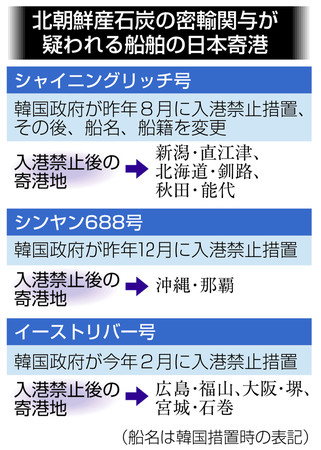
民間会社の船舶追跡データや海上保安庁の情報を共同通信が集計した。安倍晋三首相は六月の日米首脳会談で国連決議の「完全履行」を確認したが、核・ミサイル開発の資金源となる石炭密輸に関わった疑いがある船が自由に出入りしていた実態が明らかになった。
韓国は一八年八月以降、一七~一八年にロシア産と偽って北朝鮮産石炭を持ち込んだなどとして関係者を摘発。不正に関与した計十隻を入港禁止にした。うち二隻は国連も一八年三月公表の報告書で石炭密輸に関わった疑いを指摘していた。
国連決議後、十隻のうち八隻が日本に寄港。韓国の入港禁止後も六隻が日本に寄港した。一隻は韓国入港禁止直後に船名や船籍を変え、北海道、新潟、秋田の港に入った。
日本には北朝鮮船籍の船の入港を禁ずる特定船舶入港禁止特別措置法があるが、いずれもパナマなどの船籍だった。
海上保安庁による日本入港時の検査では禁輸物資の持ち込みなどは見つからなかったが、国連安保理北朝鮮制裁委員会専門家パネルのメンバーを務めた古川勝久氏は、北朝鮮は商業活動に紛れ込ませて密輸を隠蔽(いんぺい)しており「通常検査で違反を見分けるのは困難だ」と指摘している。
この件で、韓国に批判されても仕方がない。事実なのだから!
まあ、韓国の辞任したチョ・グク法相(玉ねぎ男)の子供の不正入学やその他の不正が許されるのだから韓国も問題を見直す必要がある。まあ、日本も韓国も問題を抱える国と言う事だ!
日本に入港している韓国籍船舶の一部は国際条約を満足していないが、PSC(外国船舶監督官=国交省職員)は出港停止命令を出さない。韓国も北朝鮮も日本に目を瞑ってもらっている部分があるのか、日本が間抜けなのであろう。
韓国政府が北朝鮮関連国連安保理制裁により入港を禁止した貨物船が日本の港湾を随時寄港していたという報道が出た。
共同通信は韓国政府が昨年8月以降制裁をかけた船舶の数隻が日本各地に寄港したと20日、報じた。報道によると、韓国政府は2017~2018年ロシアから原産地を偽装して北朝鮮産石炭などを搬入することに関与した船舶10隻の入港を昨年8月以来禁止してきた。この船舶は2017年8月国連安保理が禁止した北朝鮮産石炭の輸入に関連した疑惑が持たれている。
北朝鮮で石炭の輸出は主な外貨稼ぎの手段だ。北朝鮮は石炭密輸出で核・ミサイル開発の資金を用意する。彼らはロシアと中国に立ち寄る方法で北朝鮮産石炭の原産地を偽装するが、この過程で日本の港湾を利用した可能性があると共同通信は分析した。
その間、日本のメディアは時々この船舶の寄港が疑われるという問題を提起してきた。今回の報道には関連船舶数と累積回数が最も多く注目される。
共同通信は民間会社の船舶追跡データと日本海上保安庁の情報を分析した結果を引用し、該当船舶が少なくとも計26回日本各地の港湾に寄港していたと伝えた。2017年8月国連安保理決議以降から昨年8月入港禁止措置の前を含めると、100回を超すと付け加えた。
具体的に国連の制裁決議以降この10隻の中で8隻が日本に寄港し、韓国の入港禁止以降にも6隻が寄港していたと発表されたと言った。この中で1隻は韓国入港が禁止された直後、船舶名と船籍を変えて北海道、新潟、秋田の港に入港したと伝えた。また、パナマなどに船籍を変えて北朝鮮籍船舶の入港を禁止する日本の法網をくぐった。日本の海上保安庁は該当船舶が日本に入港の時、禁輸物資の搬入事実などは確認できなかったと伝えた。
国連安保理は北朝鮮の核・ミサイル開発の資金源を遮断するという名分で2017年8月北朝鮮の石炭輸出禁止の内容が盛り込まれた決議案を採択した。引き続き、北朝鮮産石炭の密輸に関与したと疑われる船舶の入港禁止義務などを加盟国に付けた。
共同通信は安倍晋三首相が6月、ドナルド・トランプ米大統領との首脳会談で国連安保理決議の「完全な履行」を主張しながらも北朝鮮の石炭密輸出関連船舶には黙っていると指摘した。安倍首相が望む日朝首脳会談の実現に障害になることを恐れて制度的弱点の補完に消極的な動きを見せていると伝えた。
これだけのコカインが入る船のシーチェストなら大型船だろうな?まあ、ダイバーを雇えば、シーチェストの蓋を開ければ比較的に簡単に取り入れや取り出しは出来ると思う。
名古屋税関と第4管区海上保安本部は27日、愛知県豊橋市の三河港に入港した外国貿易船からコカイン約177キロを押収したと発表した。末端価格で35億円相当に上り、一度の押収量では国内過去最大という。4管などは関税法や麻薬取締法違反の疑いで捜査を進める。
〔写真特集〕何でもお見通し~大量コカイン密輸男の体内~
発表によると、船が入港した8月19日に税関などが捜索し、喫水線から9メートル下の船底近くにある海水取り入れ口内の空間でコカインを発見。ドーナツ状や箱状に固められ、約1キロごとに小分けされた袋計177個が、南京錠が掛けられるなどしたボストンバッグ7個に隠されていた。
取り入れ口は船の発電機を海水で冷やすために設けられており、4管のダイバーが長時間潜水してバッグを取り出した。コカインは純度が高いとみられ、4管などは密輸入目的だった疑いがあるとみて、愛知県警と情報を共有する。
船舶を追跡できる装置は大型船では二つある。AISとLRITだ。AIS 船舶自動識別装置の情報を受信できる範囲は比較的に狭い。しかし、LRIT(船舶長距離識別追跡装置)は衛星を経由するので電源を切らない限り、追跡できる。超大型原油タンカー(VLCC)LATIN VENTURE IMO9206035はパナマ籍なのでパナマの海運局はLRIT(船舶長距離識別追跡装置)の電源が落ちるまでの位置は把握していると思う。
しかし船名とIMO番号が公開された記事が世界中で公表されると中国の企業以外はこの船を使ってくれないと思う。また、船舶の情報を偽造する事は可能であるが船が大きすぎるので傭船する前に事前確認すると、過去のデータがないなど不自然な事があれば、まともな海運会社、精油所、そして備蓄基地は完全に避けるであろう。
船を売船するにしてもまともな海運会社は関与しないであろう。タンカーの所有者は上海を拠点とするクンルン・ホールディングスはこの船をスクラップで売っても利益が残るぐらいの大儲けをしたのだろうか?
超大型原油タンカー(VLCC)が満載の状態から空船状態になったのであれば、かなりのタンカーが荷物の移送に使われたと思う。船が大きすぎるのでどこかの備蓄基地のシーバースに行くと言う事は不可能だと思う。多くの人間がかかわるので全ての人間が情報を漏らさないようにコントロールするのはかなり難しい。
「マレーシア当局の発表によると、ラテン・ベンチャーは6月29日にポートディクソンに入港し、乗組員を入れ替えた後、7月18日に出港した。ただ貨物の積み下ろしはなかったという。」
ポートディクソンで下船した乗組員達には口止めのためにかなりの報酬が支払われたと推測する。
LATIN VENTURE IMO9206035 Crude Oil Tanker Crude Oil Tanker Panama Flag(Marinetraffic.com)
[シンガポール/クアラルンプール 16日 ロイター] - リフィニティブおよびベッセルズ・バリューの船舶追跡データによると、中国企業が所有する超大型原油タンカー(VLCC)「パシフィック・ブラボー」がマラッカ海峡に向かう途中のインド洋沖合で6月5日、船舶の位置などを示すトランスポンダー(無線中継機)のスイッチが切られ、追跡できなくなっていたことが分かった。
米政府は、パシフィック・ブラボーがイラン産原油を積んでおり、米国の対イラン制裁に違反するとして、アジアの港湾都市に対し同船を寄港させないよう警告していた。VLCCは一般的に約200万バレルの石油を輸送する。[nL4N2343JL]
その後、7月18日にVLCC「ラテン・ベンチャー」のトランスポンダーがマラッカ海峡に面したマレーシアのポートディクソンで作動した。ポートディクソンはパシフィック・ブラボーが最後に位置を示した地点からおよそ1500キロメートル離れている。
ただ、船舶追跡データによれば、ラテン・ベンチャーとパシフィック・ブラボーが発信した国際海事機関(IMO)の船舶識別番号は「IMO9206035」で一致。IMOの識別番号が変更されることはないため、ラテン・ベンチャーとパシフィック・ブラボーは同一のタンカーであり、所有者が米国の対イラン制裁の回避を試みた可能性がある。
オンライン船舶サイト「イクエーシス」のデータによると、タンカーの所有者は上海を拠点とするクンルン・ホールディングスで、シンガポールにもオフィスを構えている。オフィスに電話で問い合わせたが応答はなかった。
追跡データによると、パシフィック・ブラボーとして航海中の貨物タンクは満杯だったが、42日後にラテン・ベンチャーとして現れた際には空だったという。
タンカーの石油が積み下ろされた地点は確認できていない。
マレーシア当局の発表によると、ラテン・ベンチャーは6月29日にポートディクソンに入港し、乗組員を入れ替えた後、7月18日に出港した。ただ貨物の積み下ろしはなかったという。
船舶追跡データによると、ポートディクソンを出港後、タンカーはシンガポールを通過し、マレーシアの南東海岸に寄港。7月25日のデータでは貨物タンクがほぼ満杯となり、8月14日時点では同地点に停泊中という。
By Roslan Khasawneh and A. Ananthalakshmi
SINGAPORE/KUALA LUMPUR (Reuters) - While in the Indian Ocean heading towards the Strait of Malacca, the very large crude carrier (VLCC) Pacific Bravo went dark on June 5, shutting off the transponder that signals its position and direction to other ships, ship-tracking data showed.
A U.S. government official had warned ports in Asia not to allow the ship to dock, saying it was carrying Iranian crude in violation of U.S. economic sanctions. A VLCC typically transports about 2 million barrels of oil, worth about $120 million at current prices.
On July 18, the transponder of the VLCC Latin Venture was activated offshore Port Dickson, Malaysia, in the Strait of Malacca, about 1,500 km (940 miles) from where the Pacific Bravo had last been signalling its position.
But both the Latin Venture and the Pacific Bravo transmitted the same unique identification number, IMO9206035, issued by the International Maritime Organization (IMO), according to data from information provider Refinitiv and VesselsValue, a company that tracks ships and vessel transactions. Thomson Reuters has a minority stake in Refinitiv.
Since IMO numbers remain with a ship for life, this indicated the Latin Venture and the Pacific Bravo were the same vessel and suggested the owner was trying to evade Iranian oil sanctions.
"Without speculating on any particular shipowners' actions, generally speaking for a ship to change its name abruptly after receiving accusations from the U.S., it can only be that the owner is hopeful that the market will be deceived by something as rudimentary as a name change," said Matt Stanley, an oil broker at StarFuels in Dubai.
The Latin Venture oil tanker shut off its transponder from early June to July 18 - https://fingfx.thomsonreuters.com/gfx/ce/7/5922/5905/LatinVentureTransponder.png
The vessel is owned by Kunlun Holdings, which, according to data from Equasis.org, a shipping transparency website set up by the European Commission and the French Maritime Administration, is based in Shanghai. The company also has an office in Singapore.
Calls to the company's offices were unanswered.
Latin Venture status and location on Refinitiv Eikon - https://fingfx.thomsonreuters.com/gfx/ce/7/5921/5904/LatinVentureLatest.png
While operating as the Pacific Bravo, the ship's transmission data showed that its cargo tanks were full before it turned off the transponder. When it reappeared 42 days later as the Latin Venture, it was empty, according to Refinitiv and VesselsValue data.
Reuters was not able to ascertain where or if the oil onboard the Latin Venture was offloaded.
According to a statement from the Marine Department Malaysia, the Latin Venture entered Port Dickson on June 29 for a crew change and departed on July 18. The statement said that no cargo was discharged.
The United States reimposed sanctions on Iran in November after pulling out of a 2015 accord involving Tehran and six world powers that limited Iran's nuclear programme. Aiming to cut Iran's oil sales to zero, Washington in May ended sanction waivers given to some importers of Iranian oil.
Iranian officials were not immediately available for comment.
While it was not aware of this particular situation, China has always opposed unilateral sanctions and "long-armed jurisdiction", a Chinese Foreign Ministry spokesperson said in response to a Reuters request for comment.
"The global community, including China, is legally engaged in normal co-operation with Iran within the framework of international law, which deserves to be respected and protected," the spokesperson said.
Responding to a Reuters request for comment on its reaction to the name change, a U.S. State Department spokesman said on Aug. 1: "We do not preview our sanctions activities, but we will continue to look for ways to impose costs on Iran in an effort to convince the Iranian regime that its campaign of destabilising activities will entail significant costs."
After departing Port Dickson, the tanker sailed past Singapore to the southeastern coast of Malaysia and on July 25 it transmitted that its cargo tanks were nearly full. As of Aug. 14, the ship remains there, ship-tracking data shows.
The origin of the oil cargo could not be determined.
The track of the Latin Venture vessel from Iran to Malaysia - https://tmsnrt.rs/2N3eZcE
(Reporting by Roslan Khasawneh in SINGAPORE and A. Ananthalakshmi KUALA LUMPUR; additional reporting by Muyu Xu in BEIJING, SHANGHAI and BEIJING bureau, Jane Chung in SEOUL and Jonathan Saul in LONDON; editing by Christian Schmollinger)
船の貨物に見せかけて覚醒剤約43キロ(末端価格26億円)を香港から密輸したとして、警視庁は、メキシコ国籍とイラン国籍の男3人を覚醒剤取締法違反(営利目的輸入)の疑いで逮捕し、28日発表した。いずれも容疑を否認しているという。同庁は国際的な犯罪組織が関与したとみている。
逮捕されたのは、メキシコ国籍の住所、職業不詳オロスコ・ボカネグラ・ホセ・ルイス容疑者(46)ら。組織犯罪対策5課によると、3人は4月13日、覚醒剤を隠した船舶用減速機1台を香港の港で外国貿易船に積み込み、同月18日に東京都品川区の大井コンテナ埠頭(ふとう)で陸揚げして密輸した疑いがある。
東京税関の検査で覚醒剤が見つかり、警視庁などが「泳がせ捜査」で行方を追い、5月16日に山梨県富士吉田市の倉庫に運び込まれるのを確認。その後、3人を覚醒剤を所持した疑いで逮捕していた。
静岡県南伊豆町の弓ケ浜海岸で約1トンの覚醒剤が小型船から押収され、中国人の男7人が警視庁などに逮捕された事件で、小型船が横浜港を出港後、伊豆諸島・八丈島(東京都八丈町)で給油していたことが18日、捜査関係者への取材で分かった。支援役が空路で島内に入り、レンタカーで港とガソリンスタンドとの間を往復。警視庁は覚醒剤の受け渡し海域とのほぼ中間に当たる八丈島が密輸の中継拠点だったとみて、全容解明を進めている。
警視庁組織犯罪対策5課は同日、押収した覚醒剤を公開。覚醒剤は約2キロずつポリ袋に小分けされ、数個ずつシートにくるまれていたほか、ペットボトルの飲料水、ホース、燃料用のポリタンクや複数の携行缶などが押収された。約1トンは一度の押収量としては国内最多で、末端価格は約600億円に上る。
捜査関係者によると、密輸グループのメンバーらは5月30日、小型船を係留していた会員制クルージングクラブ(横浜市中区)に集結。31日に海路と陸路に分かれ、3人が小型船で、2人が車で移動を開始した。車に乗っていた中国人1人は羽田空港から空路で八丈島に入ったという。
一方、小型船は同日夕に八丈島に入港。6月1日朝から数時間かけて、借り受けた軽トラックで島内のガソリンスタンドと船の間を繰り返し往復。携行缶を使って船に燃料を給油し、海上補給用にポリタンクにもためていたとみられる。
小型船は給油を終えた後に出港し、島内にいた中国人は夕方の便で羽田空港に戻った。八丈島は、横浜港と小型船が覚醒剤を受け取ったとみられる太平洋の最短コースに近く、横浜港から約260キロ、現場海域まで約320キロで、ほぼ中間地点に位置している。
八丈島は羽田空港からの定期便があるが、大島や三宅島など伊豆諸島の他の島々に向かうには、空路の定期便は都心から離れた調布飛行場(東京都調布市)の発着なうえ、八丈島より現場海域に遠い。捜査関係者は、密輸グループが距離や利便性を考慮し、八丈島を中継拠点に設定したとの見方を示した。
小型船は2日未明、現場海域で受け渡し場所の目印とみられる物体を海面に投入。別の船が目印付近に覚醒剤を落とし、小型船が回収する「瀬取り」の手法でやりとりしたとみられる。小型船は3日夜に弓ケ浜海岸の港で再び給油。夜になって陸路のメンバーと合流し、覚醒剤を荷揚げしたところを警視庁などに摘発された。
今回の事件は、数年前に弓ケ浜海岸の地元住民から寄せられた「不審な船が港に来ている」との通報から捜査に着手。昨年11月に密輸が決行される可能性があり警戒を強化したが、摘発には至らなかった。
密輸グループのメンバーらが5月、香港から関西国際空港に入国するなどし、レンタカーで関東周辺や静岡県内を移動。小型船を準備したことなどが確認されたという。警視庁は覚醒剤の調達先が香港で、暴力団が売りさばく計画だったとみて捜査を進めている。
静岡県伊豆半島の沖合で不審な船が見つかり、1000キロ近く(末端価格でおよそ600億円分)の覚醒剤が押収されました。国内で1度に押収された覚醒剤としては過去最多で、警視庁などは中国人7人を逮捕するとともに国際的な薬物の密売グループが関わっているとみて捜査しています。
3日夜、静岡県南伊豆町の沖合で不審な船が見つかり、その後、警視庁や海上保安庁などが船の中を調べたところ、袋に入れられた大量の覚醒剤が発見されました。
警視庁によりますと、押収された覚醒剤は1000キロ近くで、末端価格でおよそ600億円分にのぼり、国内で1度に押収された覚醒剤としてはこれまでで最も多いということです。
警視庁などは営利目的で覚醒剤を所持したとして現場にいた林境陞容疑者(35)ら中国人7人を逮捕しました。
末端価格が高い日本で売りさばくために香港から密輸したとみて、詳しいいきさつを調べるとともに、国際的な薬物の密売グループや暴力団関係者が関わっているとみて捜査しています。
警視庁によりますと、調べに対して7人はいずれも「知らない」などと供述し、容疑を否認しているということです。
押収量は増加の傾向
ここ数年、日本に密輸される覚醒剤の押収量は増加していて、去年までの3年間、いずれも1000キロを超えています。
中でも一度に大量の覚醒剤を密輸する手口が相次いでいて、去年10月には名古屋市の倉庫で台湾から船で持ち込まれたとみられる覚醒剤およそ350キロが見つかっています。
また、おととしには茨城県ひたちなか市の沖合で、およそ475キロの覚醒剤が見つかり、暴力団の幹部らが逮捕されました。
これまでに国内で一度に押収された覚醒剤で最も多かったのは、3年前の2016年に那覇市の港でヨットからおよそ600キロが見つかった事件がありますが、今回の事件はそれを大幅に上回るとみられています。
捜査関係者によりますと、日本で覚醒剤の末端価格は海外に比べて高く、国際的な犯罪組織が大量に持ち込もうとする動きが活発になっているということです。
静岡県南伊豆町の海岸で今月3日、不審な船舶から覚醒剤約1トン(末端価格約600億円)が発見され、警視庁が押収していたことが警視庁幹部への取材でわかった。覚醒剤の押収量としては過去最大。警視庁は、現場にいた24~40歳の中国人の男7人を覚醒剤取締法違反(営利目的共同所持)容疑で逮捕。海外の麻薬密輸グループによる大規模密輸事件として捜査している。
発表によると、7人は3日午後9時半頃、南伊豆町の海岸で、覚醒剤を所持した疑い。洋上で別の船から受け取ったとみられる。調べに対し、いずれも容疑を否認している。
警視庁と海上保安庁などは「海岸に不審な船が来ている」との情報を入手し、洋上で薬物を受け渡す「瀬取り」が行われているとみて内偵捜査を進めていた。海岸で2~3キロごとに袋に小分けされた覚醒剤を船から荷降ろししている最中に踏み込み、4人を取り押さえ、逃走した3人もその後、身柄を確保したという。
これまでの最大押収量は2016年に那覇港(那覇市)でヨットから押収した約600キロだった。
Vietnam law enforcement agencies, assisted by Coast Guard, on Apr 14 seized Korean tanker PIONEER SPIRIT and Vietnamese tanker QNg 0350 in waters of Quang Ngai province in the South Central Coast region of Vietnam, when the ships were engaged in illegal cargo transfer. Vietnamese vessel was to offload from Korean tanker some 8000 tons of gasoline A95 and deliver it to Sa Ky port. Korean tanker AIS was off, since early April. Understood both tankers, seized in international waters, were taken to nearest Vietnamese port for further investigation. No data found on Vietnamese tanker QNg 0350. Vessel looks more like self-propelled oil barge, than a sea-going tanker. Obviously, QNg 0350 size is much less than that required for taking on 8,000 tons of fuel, so assumedly, the vessel was to make several trips, to deliver all contraband shipment.
Product tanker PIONEER SPIRIT, IMO 9166950, dwt 8735, built 1997, flag Korea, manager KSIM Ltd., Busan.

韓国国籍の船舶が国連安全保障理事会(安保理)による対北朝鮮制裁決議を違反した疑いで昨年10月から釜山(プサン)港に抑留中だと、外交部関係者が2日明らかにした。韓国国籍の出港がこうした容疑で保留されたのは今回が初めて。
この関係者は「対北制裁決議を違反した疑いで昨年10月から韓国国籍の船舶1隻およびその他の国籍の船舶3隻の出港を保留している」と明らかにした。韓国政府は該当船舶が海上で船から舶に移し替える「瀬取り」で北朝鮮船舶に精製油を供給したという情報を受け、調査に着手したという。「瀬取り」は南北交流協力法違反に該当する。政府は実際にこうした「瀬取り」が行われたかどうかの根拠を調べるために昨年10月から該当船舶の出港を保留中と明らかにした。
外交部関係者は「政府は国際社会の責任ある一員として国連安保理による対北朝鮮制裁決議を忠実に履行してきたし、決議違反に関連する動向に注目してきた」とし「韓国国籍の船舶1隻に対しては関係当局で調査が進行中であり、安保理決議の適用については米国および国連制裁委員会と協議中」と伝えた。
抑留中の船舶は2000年に建造され、原油積載容量は7850トン、全長110メートル、幅19メートル。船会社側も容疑を認めたという。
一方、2回目の米朝首脳会談直前の2月末にも北朝鮮の国際貿易港の南浦(ナムポ)などで石炭の輸出と疑われる活動があったと、北朝鮮分析サイト「38ノース」が1日(現地時間)明らかにした。2017年8月の国連安保理決議(2371号)などに基づき、北朝鮮は石炭・鉄鉱石・レアアース(希土類)などの鉱物の輸出が全面禁止された状態だ。
各国船舶95隻のリストにルニスという韓国船舶含まれる 昨年5月に米国が情報共有、9月には関税庁が検索 「韓国狙ったメッセージというよりは 対北朝鮮制裁の維持に向け注意を促すため」
米財務省が21日(現地時間)に発表した北朝鮮との海上での瀬取り疑惑を受けている船舶のリストに、韓国の船舶1隻を含めた世界各国の船舶95隻が載せられた。ハノイでの朝米首脳会談が物別れに終わり、朝米対話が止まった状態で、米国が制裁を徹底して順守するよう国際社会に“注意”を促すためのメッセージを送ったものと見られる。
米財務省外国資産管理室は同日、ホームページで北朝鮮船舶との精製油・石炭の瀬取りに関与したものと見られる北朝鮮及び各国の船舶95隻を公開したが、このリストには「ルニス(LUNIS)」という名前の韓国船籍の船舶1隻も含まれた。外交部は「米国側は油類の違法海上取引及び北朝鮮産石炭輸出を防ぐための勧告措置とともに、疑いのある船舶リストを発表し、関連機関と企業に適切な注意を喚起していると聞いている」とし、「この船(ルニス号)は、これまで韓米間で注視してきた船舶であり、安保理決議に違反しているかどうかについては、徹底的に調査していく」と明らかにした。海洋水産部に確認した結果、ルニスは5400トン級石油タンカーで、主に東南アジア地域を運航している。同船舶をめぐり、韓米が「注視してきた」というのは、米財務省の公式発表がある前に韓米当局間の情報交換があったことを意味する。
実際、韓国政府は昨年5月に米政府からの提供を受け、当該船舶に対する情報を共有したという。関税庁の関係者は「(昨年9月)当該船舶が(韓国の港に)入った際、検索を行った」とし、「(船舶が)入港したら検索して国連決議に違反したかどうかを調べる。米国でも注意報を出したため、より徹底的に調査する」と話した。外交部は「米財務省が発表した今回の指針について、国内業界に注意を促す予定だ」と説明した。
国立外交院のキム・ヒョヌク教授は「北朝鮮が瀬取りなどを通じて国連制裁に隙間を作る状況で、米国が国際社会全般に『制裁を維持してこそ、北朝鮮が非核化のための対話に出る』という注意を喚起するメッセージを送ったものと見られる」とし、「韓国船舶が含まれたものの、韓国に直接警告メッセージを送ったというよりは、国際社会、特に中国に対する警告の意味がある」と指摘した。米財務省は同日、北朝鮮の制裁回避を助けた中国海運会社2社を制裁リストに加えたが、韓国船籍の船舶は制裁対象リストではなく「疑惑船舶」リストに載せられただけで、韓国を狙った警告メッセージを送ったと言えないということだ。「韓国政府にも一種の警告信号を送っているものとみられる」(シン・ボムチョル峨山政策研究院選任研究委員)という意見もあるが、外交部は同日、「米財務省は2018年2月に、北朝鮮の違法海上活動関連に対する注意を促すため、北朝鮮の制裁迂回手法や疑惑船舶のリスト、勧告措置などを含む指針を発表しており、今回発表されたのと同じ指針を更新したもの」だとし、拡大解釈を警戒した。
第2回米朝首脳会談決裂以降、米国が初めて北朝鮮への独自制裁カードを切った。先月、ベトナム・ハノイ(2月27~28日)で米朝が物別れに終わってから3週ぶりだ。北朝鮮の制裁回避を助けた中国の海運会社2社を制裁リストにのせた。また、米国は北朝鮮の石炭・情製油の不法瀬取りに関与したと疑われる船舶のリストを発表し、「LUNIS」という名前の韓国船籍の船舶を含ませた。北朝鮮への制裁履行に韓国政府も協調してほしいという「警告状」という指摘が出る。
米財務省は21日(現地時間)、傘下の海外資産管理局(OFAC)が北朝鮮の対北朝鮮制裁の回避を助けた疑いで遼寧丹興国際貨運有限公司と大連海博国際貨運有限公司など中国海運会社2社を制裁のリストに入れたと発表した。
遼寧丹興国際貨運有限公司は国連安全保障理事会(安保理)傘下の対北制裁委員会が12日、報告書で「金正恩(キム・ジョンウン)北朝鮮国務委員長のナンバー・プレートのないベンツリムジン車両の運送に関与した」と明示した会社だ。財務省は「遼寧丹興は欧州連合(EU)諸国に駐在した北朝鮮当局者などが政権のために物品を購入できるように随時欺瞞的動きを見せた」と明らかにした。これに先立ち、安保理の対北朝鮮制裁報告書は「金委員長のベンツの相当数が中国人企業家George Ma氏の指示に従い、カリフォルニア・ロングビーチ港から中国大連に運送され、その後遼寧丹興のコンテナに船積みされた」と指摘した。
大連海博国際貨運有限公司は、北朝鮮偵察総局(RGB)傘下である白雪(ペクソル)貿易会社に物品を供給し、制裁回避を助力した疑いだ。白雪貿易会社は北朝鮮産金属や石炭を輸出し、あるいは購入した疑いなどですでに制裁対象に指定されている。財務省は「昨年初め、大連海博が中国大連で北朝鮮船舶に貨物をのせ、南浦(ナムポ)にある白雪貿易会社に輸送した」とし「北朝鮮政権が利益を得ただろう」と話した。今回の制裁で遼寧丹興と大連海博の米国内資産が凍結され、米国民が彼らと取り引きする行為も禁止される。
米国の今回の対北朝鮮制裁は第2回米朝首脳会談決裂後、北朝鮮をより圧迫する意味という分析だ。その間、全方位での制裁にもかかわらず、中国が海上での不法瀬取りなどを助ける方式で北朝鮮の「道」を開いたのが事実だ。牙山(アサン)政策研究院のシン・ボムチョル安保統一センター長は「経済封鎖の強化で北朝鮮に圧力をかけながらハノイで米国が要求した非核化措置を受け入れることを求める北朝鮮への圧迫の措置」と解説した。同時に、来週、米中貿易交渉の再開を控えて中国海運会社を名指して制裁することで交渉の優位を占めようとする戦略もあるとみられる。
今回の制裁で注意リストの対象に韓国船籍の船舶(LUNIS)が初めて含まれたのも異例で、注目する必要があるという指摘だ。「LUNIS」は北朝鮮のタンカーと石油を不法瀬取りしたと疑われる第3国船舶18隻に含まれた。「LUNIS」は5412トンの石油化学製品の運搬船で釜山(プサン)A海運会社が所有主だ。韓国船舶を直接制裁したわけではないが、監視の対象に入れたものだ。財務省は不法瀬取り船舶の寄港地として釜山・光陽(クァンヤン)・麗水(ヨス)港など3港を地図に表記したりもした。
財務省は、この他に石油の不法瀬取りをした北朝鮮のタンカー28隻、石炭不法貿易にかかわった船舶49隻など計95隻の船舶の名前を公開した。韓国外交部はこれについて「韓米は昨年下半期から『LUNIS』が北朝鮮の情製油および石炭の不法瀬取りに関与していると鋭意注視していた」と話した。両国政府が情報を共有した状況で、「LUNIS」をリストに入れたわけだ。匿名を求めた専門家は「韓国船籍船舶を注意リストの対象に入れたのは、今後北朝鮮に対する制裁の違反事例が確認されれば韓国企業や船舶も米国の独自制裁の対象に含まれる可能性があるという警告にもなり得る」とし「ハノイ会談決裂後、南北関係に対する進展意志を明らかにする韓国政府に米国が連携を求めたとみられる」と話した。
A tanker operated by Singapore’s top bunker supplier has been arrested in Malaysia on suspicion of making an illegal ship-to-ship (STS) fuel transfer off Pengerang.
Malaysian Maritime Enforcement Agency (MMEA) patrol boats were conducting a joint patrol operation with the Australian Border Force when they detected oil tankers, Kantek 2 and Ramai Awana, according to local media reports.
MMEA believes Kantek 2 was transferring fuel, believed to be marine fuel oil, to Ramai Awana. This happened around noon on 27 September.
Upon inspection, both vessels could not prove they had obtained the relevant documentation from the director of Marine Malaysia in Pengerang waters for the STS operation. They were also unable to produce ship insurance documents.
Data from IHS Markit’s maritime portal indicate that 2008-built, Singapore-registered Kantek 2 is a 6,200 dwt product tanker operated by Sentek Marine & Trading. Ramai Awana, built in 1976, is registered in Cook Islands. It is a 2,120 dwt product tanker operated by Dutaryo Overseas Trading Corp.
Both operators are incorporated in Singapore. Sentek was Singapore’s largest bunker supplier by volume in 2017 and was ranked second in 2016.
At the time of the incident, there were 23 crew members on board both vessels, all of whom are Singaporeans aged between 27 and 55. Four of them were taken into custody to assist with further investigations.
MMEA is investigating the case under Malaysia’s Merchant Shipping Ordinance 1952, Section 49 1B (1) (k), which prohibits the transfer of oil without permission from the director of Marine Malaysia and Section 49 1B (1) (l).
If found guilty, vessel owners could be fined up to MYR100,000 or jailed up to two years, or both.
Pengerang is southeast of Pasir Gudang, Malaysia’s oil refining and downstream hub, and further east of Singapore. It appears to be a hotspot for such illegal transfers, as vessel operators plying the waters near the Pasir Gudang Port boundary attempt to evade tax.
Last month, two Malaysian-registered tankers were arrested on suspicion of illegal fuel transfer, one of which was transporting liquefied natural gas.
A similar case involving another Sentek tanker was reported at about the same time. MMEA detained bunkering tanker Sentek 33 and a fishing vessel, Fu Yuan Yu 677, on suspicion of carrying out illegal STS fuel transfer.
Sentek 33, is a 2014-built, Singapore-registered, 540 dwt bunkering tanker, while China-registered Fu Yuan Yu 677 is part of a fleet belonging to Fuzhou Honglong Ocean Fishing.
Both vessels were anchored about 7 km southeast of Pengerang and Fu Yuan Yu 677 was believed to be receiving marine gasoil from Sentek 33. This took place at about 4 pm in the afternoon.
Upon inspection by MMEA, both failed to produce the permits necessary for anchoring in Malaysian waters or carrying STS transfer. Five of 18 crew members on board both ships were assisting with investigations.
船舶代理店の対応も含め、海保がどれくらい真剣に対応するか次第であろう。
少なくとも2つのケースで船舶代理店が船舶の情報について海保に嘘の情報を流したケースを知っている。
海保は嘘の情報について全く気付いていなかった。
嘘でもバレなければ問題にならない。国際船舶・港湾保安法に基づく国土交通省令を改正しても海保の対応次第で抜け道は残るであろう。
日本政府が独自の判断に基づき実施する対北朝鮮制裁措置の実効性を高めるため、海上保安庁が外国から国内港に入る全船舶に対し、過去の北朝鮮寄港歴の有無について報告を義務付ける方針を固めたことが21日、分かった。国際船舶・港湾保安法に基づく国土交通省令を改正し、船側から入港前に報告を受ける「船舶保安情報」の項目として新たに追加する。罰則対象も拡大され、法令の整備で北寄港船の入港見逃しを防ぐ。
日本は平成28年2月、北朝鮮に寄港した第三国籍船舶の入港を禁じる独自制裁を決定。その後、制裁を強化し日本籍を含む全船舶が対象になった。海保は入港船の北朝鮮への寄港歴について、過去10カ所の寄港先などを記した船舶保安情報で確認、関係機関と共有する情報も活用してきた。
北朝鮮の核実験やミサイル発射を踏まえた北寄港船の入港禁止という独自制裁は、北朝鮮籍船舶を想定して整備された特定船舶入港禁止特別措置法に基づく。その一方で、船舶保安情報の入港24時間前までの報告は国際船舶・港湾保安法で規定。海保は「10カ所より前の寄港先」という2法の間で生じた“ズレ”を埋めるため、国交省令を改正して船舶保安情報に北朝鮮への寄港歴の有無という項目を追加する方針だ。
省令改正を目指す契機は、昨年11月に千葉港で発生した香港籍貨物船の不正入港。貨物船側が報告した10港に北朝鮮の港はなく、千葉海上保安部は入出港を許可。千葉県警が入港後の聞き取りで北朝鮮に寄港した可能性を把握したが、法律違反という認識がなかった。
船舶保安情報への項目追加に伴って、北寄港歴のある船が日本国内に入港した場合の罰則対象も拡大することになる。特定船舶入港禁止特措法(3年以下の懲役や300万円以下の罰金)では船長のみが罪に問われるが、船舶保安情報の虚偽報告を禁じた国際船舶・港湾保安法は、報告者に1年以下の懲役か50万円以下の罰金を科す。報告は船長のほか、船舶所有者や代理人からも認めており、入港手続きを代行する船舶代理店などに対する抑止効果も期待できる。
◇用語解説
北朝鮮寄港船の千葉港入港問題
昨年11月、千葉県警水上警察隊が千葉港に入港した香港籍貨物船に対し、不審情報などを聞き取る訪船活動を実施。昨年1、2月の2回、北朝鮮の羅津(ラジン)港に寄港した可能性を把握したが、県警が千葉海上保安部に連絡したのは出港後だった。海保は問題を受け、北朝鮮に寄港した第三国籍船舶の入港を禁じる独自制裁を決定した平成28年2月までさかのぼって、寄港歴を確認するよう対策を強化した。
日本人でも嘘はつくけど中国人はもっと平気で嘘をつくから証拠や証人がないとなかなか捜査は進まないと思う。
重さ3キロ、1500万円相当の金塊を中国から密輸したとして、29歳の男が関税法違反の疑いで逮捕されました。警察は男の認否を明らかにしていません。
漆畑晃太郎記者「こちらにあるのが、今回押収された金塊です。金塊は1つ約500万円するということです」
逮捕されたのは、大阪市中央区の無職・斉藤岳順容疑者で、すでに有罪判決が確定した中国籍の男と共謀し、輸入の許可を得ず、1500万円相当の金塊を、中国から国内に持ち込んだ疑いがもたれています。
去年3月、中国籍の男が貿易船の船員として清水港に入港した際、税関の職員が身体検査したところ、上着の内ポケットに金塊を隠し持っていたということです。
中国籍の男の供述などから警察は、依頼主として斉藤容疑者を割り出しましたが、中国籍の男は「別の中国人を介して依頼された」などとも話しており、税関や警察は全容解明を進めています。
1 事案の概要
平成31年1月18日(金曜日)午後,北朝鮮船籍タンカー「AN SAN 1号」(IMO番号:7303803)と船籍不明の小型船舶が東シナ海の公海上(上海の南約410kmの沖合)で接舷(横付け)していることを海上自衛隊第1海上補給隊所属「おうみ」(佐世保)が確認しました。
両船舶は,接舷(横付け)した上で蛇管(ホース)を接続していたことから,何らかの作業に従事していた可能性があり,政府として総合的に判断した結果,国連安保理決議で禁止されている「瀬取り」を実施していたことが強く疑われます。
なお,北朝鮮船籍タンカー「AN SAN 1号」は,平成30年3月に国連安保理北朝鮮制裁委員会から資産凍結・入港禁止の対象に指定された船舶です。
2 我が国としての対応
我が国としては,本事案について,国連安保理北朝鮮制裁委員会に通報するとともに,関係国と情報共有を行っています。
水島港に入港したタンカーで覚醒剤6kgを密輸入した疑いでナイジェリア人の船員ら4人が逮捕されました。覚醒剤取締法違反の疑いで逮捕されたのはナイジェリア人の船員オークワン・ゴズタイム・チディマ容疑者(30)ら外国人の船員4人です。警察などの調べによりますと、4人はナイジェリアから来た液化天然ガスを運ぶタンカーで覚醒剤約6kg、末端価格にして約4億2000万円分を密輸入した疑いです。覚醒剤は水島港の手荷物検査でオークワン容疑者のリュックサックの中から見つかりました。警察の調べに対し4人は「何も知らない」と容疑を否認しています。警察は日本に荷受人がいるとみて捜査しています。また、税関は12日付けでオークワン容疑者を関税法違反でも岡山地検に告発しました。岡山県で覚醒剤6kgの押収は過去最多です。
ロシア外務省は1日(現地時間)、米国の制裁目録に入ったロシアの海運会社「Gudzon」所属の貨物船が釜山(プサン)港に抑留されている事件に関連し、駐露韓国大使を呼んで抗議し、船舶の即刻釈放を要求した。
これに先立ち先月28日、ロシア・ウラジオストクに拠点を置く海運会社「Gudzon」所属の多目的貨物船「セヴァストポリ(SEVASTOPOL)」が北朝鮮制裁体制違反疑惑に関連して、先月28日、釜山港で出港禁止措置を受けた。
ロシア外務省はこの日、メディア向けの報道資料を出して「禹潤根(ウ・ユングン)駐ロシア韓国大使を外務省に呼んだ」としながら「イーゴリ・モルグロフ外務次官がセヴァストポリ号の不法抑留に関連し、禹大使に抗議した」と明らかにした。また、「ロシア側は韓国港湾当局が取った貨物船出港禁止措置を直ちに解除するよう要求した」と付け加えた。
先月中旬、修理のために釜山港に入港したセヴァストポリ号は27日に修理を終えて出港する予定だったが、韓国当局が出港禁止措置を下して釜山港に抑留されている状態だ。
抑留された理由は公式には明らかにされていないが、Gudzon側は自社とセヴァストポリ号が米国の制裁目録に入ったことに関連していると把握していて、「北朝鮮制裁に反するような活動に関与したことはない」と主張している。
米財務省は8月21日、石油の瀬取りで国連安保理制裁決議に違反したロシア海運関連企業2社と船舶6隻を制裁すると明らかにし、この中にGudzonとセヴァストポリ号を制裁目録に入れた。
また、ニッキー・ヘイリー国連駐在米国大使は先月17日、国連安保理会議で、ロシアが公海上での瀬取りを通じて北朝鮮に石油を供給し、安保理制裁決議に違反したという証拠が手元にあると主張していた。
覚醒剤約50キロを密輸したとして、神奈川県警薬物銃器対策課と戸部署などは18日、覚せい剤取締法違反(営利目的輸入)の疑いで、イラン国籍で自称会社員の男(41)と、韓国籍の貿易会社経営の妻(48)=いずれも横浜市西区岡野2丁目=を逮捕した。横浜税関によると、今年の覚醒剤の押収量としては最大で、末端価格は約30億円に上るとみられる。
逮捕容疑は共謀して、タイの港でコンテナに積み込んだ約50キロの覚醒剤を貨物船で運搬させ、9月19日に横浜港の本牧ふ頭に密輸した、としている。県警によると、両容疑者とも「何も知らない」などと容疑を否認している。
県警や同税関によると、今月1日に同税関の検査で100袋に小分けされた覚醒剤が発見された。県警などが別の粉末に入れ替えて泳がせ捜査を行い、7日に配送先の横浜市内の貸倉庫から運び出そうとした男を麻薬特例法違反容疑で逮捕。妻も同日、同容疑で逮捕していた。2人は16日に釈放されていた。
県警によると、コンテナは妻の貿易会社が木炭名目で荷受人になっていた。県警は密輸の背後関係を調べる。
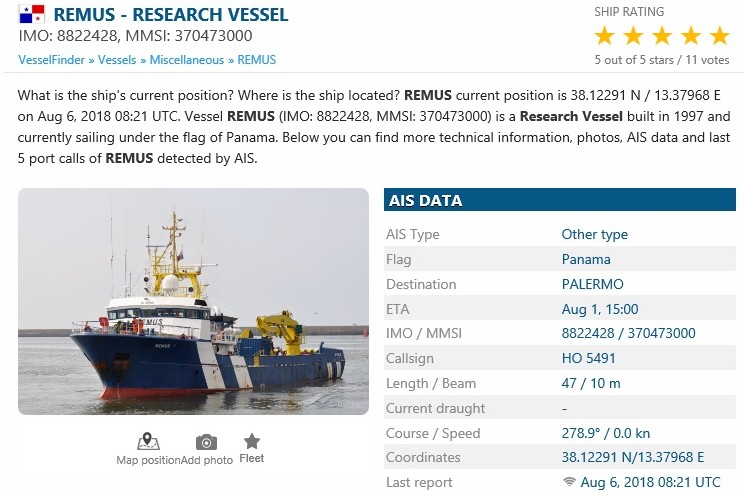
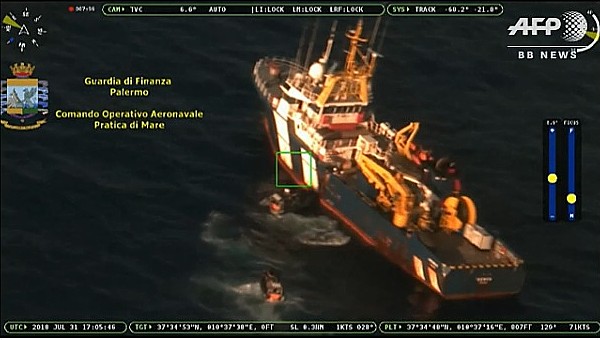
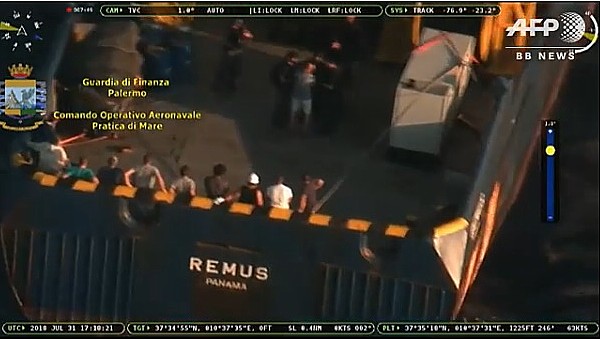
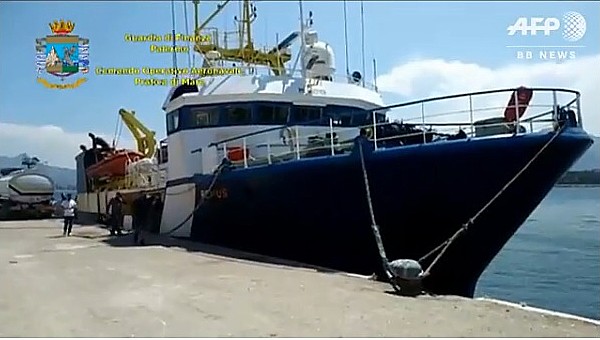
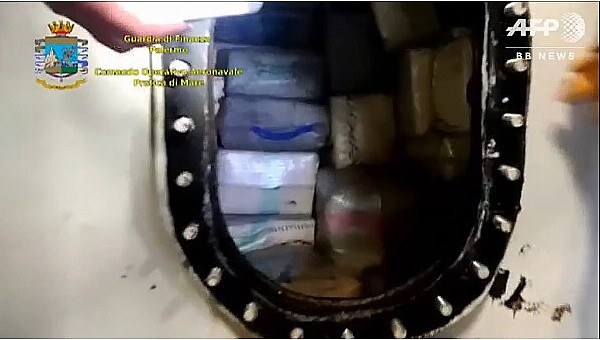
≪すでに一定量の石油を確保か≫
北朝鮮は国連安保理が定めた法定許容量をはるかに上回る量の石油製品をすでに不正輸入したと考えられている。石油密輸の主な手段は、洋上での船舶間の物資の積み替え(瀬取り)だ。米政府は、今年の最初5カ月間だけで北朝鮮は少なくとも89回は瀬取りを行い、約76万バレルの石油製品を不正調達していたと推計する。
安保理が定めた2018年の北朝鮮の年間輸入法定許容量は50万バレルのみ。これに加えて、残りの7カ月間も同じペースで不正調達を続けると仮定すれば、北朝鮮の18年の石油製品調達見積もり総量は約232万バレルとなる。北朝鮮のもとの年間輸入量450万バレルの約5割に相当する。
北朝鮮が他にも不正調達した可能性を考えれば、一定規模の経済活動を維持できる量の石油製品を不正取得した可能性がある。
瀬取りの手段は巧妙化している。正体不明の石油タンカーが続々と出現し、北朝鮮の瀬取り相手の特定が容易ではない。これまで自衛隊は少なくとも9件の瀬取り容疑の現場を捉えた。瀬取りに関わっていた船舶や船舶関係企業の中には後に国連制裁対象に指定されたものが複数ある。
にもかかわらず、企業関係者が関係国で処罰されたとの情報は、あまり聞かれない。韓国政府も8月に北朝鮮産石炭をロシア経由で不正輸入していた容疑で企業3社と個人3人を送検すると発表したが、名前は公表していない。
≪制裁違反への「抑止」効果は薄い≫
国連安保理決議では、制裁対象の個人と団体に対して資産凍結、取引禁止、渡航禁止などの処罰を科すのが各国の義務である。制裁の目的は(1)法執行を通じて違反者を処罰し、高い「取引コスト」を支払わせること、そして(2)他の企業や個人が制裁違反に加担しないよう、将来の違反行為を「抑止」することでもある。
しかし現在の「抑止」効果はあまりない。「北朝鮮と取引したら致命的な結果になる」との認識は、外国業者の間では必ずしも共有されていないようだ。
自衛隊が瀬取りの現場を捉えるのは、あくまでも瀬取り対策の第一歩にすぎない。その後、関係国が法執行に基づいて関係者を処罰し、それを幅広く業界に告知することが重要である。
北朝鮮との取引実態の解明も重要だ。外国船舶は、誰からどのように瀬取りを依頼されたのか。代金の受け取り方法も含めて詳細が解明できれば、北朝鮮側と外国人協力者の主要人物が把握できることが多い。そうすれば北朝鮮側のネットワークをピンポイントで摘発できる可能性がある。
また、国連安保理は決議2375号第7項で、公海上の船舶が禁輸貨物を搭載している疑いがあれば「旗国の同意を得て公海上で船舶を検査すること」を加盟国に要請している。日本政府は関係国と協力して、瀬取り現場での船舶検査の実施を検討すべきであろう。
≪日本利用する密輸ネットワーク≫
国連安保理の制裁対象に北朝鮮最大の海運企業「オーシャン・マリタイム・マネジメント社(OMM)」がある。その中に貨物船「グランド・カロ号」があった。しかし、この船の「所有者」として国際海事機関に公式に登録されていたのは香港企業だった。同社は北朝鮮関連貨物船「ドルフィン26号」の所有者・運航責任者でもあり、明らかに外国籍に偽装した北朝鮮船団の運営のために香港に設立されたペーパー企業だった。
香港の企業登記を見ると、同社のただ一人の代表者兼株主として登録されていたのは日本人だ。和歌山県内で病院と福祉医療グループを経営する医師である。誰かが勝手に彼の名前で香港企業を設立したのか。または、彼が自分の名義を誰かに貸したのか。制裁対象船舶に関わる「名義貸し」であれば、本人が事情を知らずとも、国連制裁違反となる。日本国内には複数名のOMM関係者がいるが、誰も処罰を受けていない。
また、国連制裁対象船舶の中に、北朝鮮産石炭密輸事件に関与した「XIN GUANG HAI号」がある。17年初めまでなぜか茨城県内の中古バイク販売会社が所有していた貨物船だ。その後、仲介業者経由で売却された先が、後に国連制裁対象とされた中国企業である。北朝鮮の密輸ネットワークは日本から貨物船を調達して石炭密輸に利用したわけである。安保理決議では制裁違反目的の資産移転は禁じられている。この日本企業は知ってか知らずか、制裁違反に関わったことになる。
制裁違反の船舶の取り締まりは、今や非常に重要な制裁措置とされるが、取り組みの遅れが目立つ。船舶の売買市場には透明性がなく、相手を知らないまま船舶が売買されることが多い。市場の透明化や海運業界の慣行改善を急ぐ必要がある。
もともと06年ごろまで、日本は北朝鮮の海運業にとって最重要拠点の一つだった。日本国内には今も北朝鮮の海運関係者が存在する。海運分野での制裁強化は日本にとって重要な課題なのである。(ふるかわ かつひさ)
北朝鮮産石炭を偽装輸入して8月から韓国政府から入港禁止措置を受けた貨物船4隻が日本にも頻繁に出入りしていた事実が確認されたと日本経済新聞が30日、報じた。
日経によれば、韓国関税庁が10日摘発したスカイエンジェル号(パナマ船籍)、リッチグローリー号(シエラレオネ)、シャイニングリッチ号・JINLONG号(ベリーズ)など貨物船4隻が2016年3月以降少なくとも25回日本に寄港した。
日経は船舶への検査をモニタリングする国際組織人「東京MOU」のデータに基づいてこのような分析結果を出した。
この貨物船が日本に寄港したのは国連安全保障理事会による北朝鮮への制裁決議で石炭の輸出制限が始まった後で、今年3月に国連に制裁違反の疑いを指摘されて以降も日本に複数回寄港していたことが明らかになった。
4隻の中で1隻は韓国で摘発される直前である今月7日、広島県尾道港に寄港した。他の2隻も7月、日本に寄港した。海上保安庁は4隻に対する検査を実施したが、違反事実は見つからなかった。
ただし、この4隻の船舶が日本に寄港した時、北朝鮮産の石炭をのせていたかなど、石炭の密輸に関与していたかどうかなどは明らかではない。
国連安保理北朝鮮制裁委員会で活動した古川勝久氏は日経に「北朝鮮産の石炭が日本に流入した可能性もある」として「日本政府が船舶検査の実効性を高めるべきだ」と主張した。
国連の制裁対象である北朝鮮の海運業者が所有する船舶がロシアの港湾に随時出入りしていると米国のラジオフリーアジア(RFA)が28日に報道した。RFAは米国の北朝鮮専門インターネットメディアのNKニュースを引用し、「制裁対象である北朝鮮の遠洋海運管理会社(OMM)所属船舶フィチョン号が最近ロシア北東ハバロフスク州の港を数回入出港した記録が確認された」と伝えた。これによるとフィチョン号が7月から数回にわたりロシアのワニノ港に入港した事実がマリントラフィックのインターネット運航情報に記録された。
ファングムサン2号からフィチョン号に名前を変えた北朝鮮船舶は7月から少なくとも6回にわたりロシアの港湾2カ所で安全調査を受けたことが確認された。これとともに遠洋海運管理会社の所属とされる1万4000トン級船舶のカンゲ号も今月ロシアのナホトカ港に入港したと記録された。マリントラフィックの資料によると北朝鮮船舶は主にロシアの鉱物運搬が頻繁な港に出入りしていた。
国連は2013年の北朝鮮の3度目の核実験以降、北朝鮮船舶に対する強制検索を含めた追加制裁を昨年から施行している。取り引きが禁止された品目を載せたと疑われる北朝鮮船舶が自国の領土・領海に入った際にすべての貨物を検査し、これに応じない北朝鮮船舶の入港を拒否するようにする制裁措置だ。ロシアは国連安全保障理事会が決議した制裁に基づきこの船舶に対して入港禁止または資産凍結措置を取ることになっている。
北朝鮮は国際制裁を避けるため船舶の固有識別番号である海上移動業務識別番号(MMSI)を変更する形で情報をかく乱している。海上移動業務識別番号は無線通信のために船舶に付与される固有番号で国籍などの情報を含んでいる。この番号の変更は主に所有主が変わったり新しい船首旗を掲げなければならない時に行われる。
国連対北制裁委員会関係者は「船舶の海上移動業務識別番号や名前が変わっても国際海事機関(IMO)が付与する船舶番号は変更されないため完全に違う船に偽装するのは不可能だと話した」とRFAは伝えた。(中央SUNDAY第442号)
昨年10月27日に北朝鮮産の石炭を国内に搬入したことが疑われている「チンルン(Jin Long)号」が4日、ロシアのナホトカ港で船積みした石炭を載せて再び浦項(ポハン)に入港し、7日にナホトカ港に戻ったことが確認された。チンルン号は昨年10月以降、今回までに計20回にわたって浦項、仁川(インチョン)、鎮海(チンヘ)、長項(チャンハン)など国内の港を何の制裁もなく自由に出入りした。今回もロシアを通じて北朝鮮の石炭を持ち込み、国連安全保障理事会の北朝鮮に対する制裁決議を違反したのではないかという疑惑が提起されている。これに対して外交部は、「関連書類を通じて1次確認した。今のところ(北朝鮮産という)疑いは発見されていない」と明らかにした。
チンルン号の入出港の情報を管理した船舶代理店のS社関係者は7日、東亜(トンア)日報の電話取材に対して、「チンルン号がロシアで石炭5100トンを積んで4日午前7時30分、浦項に入港して積み荷を降ろした」と明らかにした。チンルン号は、北朝鮮産石炭の密搬入疑惑を受けているスカイエンジェル号、リッチグローリー号に続き、疑惑船舶となった。同関係者は、「チンルン号が積んだ石炭はロシア産と表記されている。通関の時、原産地証明書を提出することになっているが、税関をすべて通過した」と付け加えた。
チンルン号は当初、出港予定日を8日午後11時に申告した。しかし、7日午前、米政権が運営する「ボイス・オブ・アメリカ」(VOA)を通じて、チンルン号の浦項入港および石炭の船積みのことが伝えられると、明確な理由なく同日午後、時間を変えてロシアに出港した。
チンルン号は昨年10月27日、北朝鮮産と疑われる石炭を東海(トンへ)港に初めて搬入して以降、これまでも北朝鮮産石炭を搬入してきたのかどうかについては公式に確認されていない。しかし、北朝鮮が石炭をロシア産に偽装して輸出したという証言が出てくるなど、情況証拠は増えている。これと関連して、自由アジア放送(RFA)は、平安北道(ピョンアンプクト)の消息筋を引用して、「朝鮮の貿易会社がナホトカ港とウラジオストク港に石炭を送り、ロシア産に書類を偽装し、他国に輸出してきた」と報じた。ロシアの会社は書類偽造の見返りに1トン当たり2ドルを要求し、輸出後に手数料を北朝鮮の貿易会社が支払ったと付け加えた。
チェ・ゴヤ記者 イ・ジョンウン記者
犯行が目立つのは外国人と芸能人。芸能人全員に尿検査を義務づけることが提案されるほど
インドネシアの麻薬問題が深刻化、取り締まりにあたる国家麻薬委員会(BNN)長官は「麻薬緊急事態である」と宣言した。ジョコ・ウィドド大統領も「抵抗する麻薬犯は現場で射殺することを躊躇するな、特に外国人には容赦なく発砲せよ」と指示している。
「逆にいやらしい」忖度しすぎなインドネシアの放送規制
2018年1~2月の2カ月間で押収された覚せい剤などはすでに3トンを越えており、2017年1年間の総押収量2トン、2016年の同1.1トンを大きく上回る。
■相次ぐ大量覚せい剤の押収
2月7日にシンガポールとインドネシア・リアウ諸島州バタム島の間のフィリップ海峡でシンガポール国旗を掲げる不審な船舶「サンライズ・グローリー号」を警戒中のインドネシア海軍、BNN、違法操業を取り締まる水産海洋省関係者などの合同チームが発見、拿捕した。
同船は船名や船員の身分証明書が頻繁に変更されることなどからBNNが2017年から追跡調査をして目を光らせていた。
乗員の台湾国籍の4人は「あくまで漁船である」と言い張っていたが、船内に漁具らしき物はなく、提示した船の登録証も偽物の疑いがあるためバタム島のバトゥ・アンパル港に回航させて船内を調べたところ、41個の米袋の中から現地でシャブと呼ばれる覚せい剤のメタフェタミン約1トンを発見、押収した。
また同じ2月20日にはリアウ諸島州のアナンバス諸島周辺海域で同じくシンガポール国旗を掲げた漁船を国家警察、ジャカルタ特別州警察、税関当局などの特別チームが拿捕。
船内にあった80個の袋から1.6トンのメタフェタミンを押収した。同船は台湾を出港後マレーシア経由でインドネシアに向かっていたという。
1トン以上の麻薬が押収されたのは、2017年7月にジャワ島バンテン州アニェル海岸で台湾国籍の8人が密輸しようとして摘発されたのが初めてで、以来1トン級でいずれも台湾国籍の乗員、あるいは台湾経由と台湾が関係している。
麻薬犯罪には厳しい刑罰で臨むことで知られるインドネシア、この時逮捕された8人には第1審で死刑判決が出ている。
■抵抗する麻薬犯射殺の徹底
インドネシア国家警察のティト・カルナフィアン長官は2月12日、麻薬捜査に携わる警察官、BNN捜査官など全ての関係者に対し、摘発現場で抵抗する麻薬犯罪の容疑者に対しては躊躇することなく発砲し、射殺も止むを得ないとの見解を示した。
そして最近の麻薬事犯に外国人が関係するケースが増加していることを念頭に「特に外国人の麻薬事犯容疑者には断固とした姿勢で対処するように」と強調した。
すべての芸能人に尿検査?
国家警察ではマリファナ、覚せい剤、エクスタシーなどの麻薬はその大半が外国人によって海外から持ち込まれているとみて、外国人の麻薬犯罪者の逮捕、摘発に力をいれている。
インドネシアでは2017年7月にジョコ・ウィドド大統領が麻薬犯罪容疑者に対し逮捕に抵抗した場合は射殺も辞さないとの姿勢を明らかにしており、今回のティト長官の発言は大統領発言の徹底を指示したものといえる。
■芸能界も麻薬汚染
インドネシアではほぼ毎日、麻薬犯罪に関するニュースが流れている。特に外国人と並んで歌手や俳優といった芸能人の麻薬犯罪摘
発が増えている。
2017年3月にはインドネシアの演歌ともいうべきダンドゥットの歌手で俳優のリド・ローマ容疑者が覚せい剤使用容疑で逮捕され、今年2月16日にはダンドゥットの女王といわれる歌手エルフィ・スカエシさんの3人の子供が麻薬取締法違反容疑で逮捕され、26日にはスカエシさん自身が参考人として警察の事情聴取を受けた。
このほかにも芸能人の逮捕は枚挙にいとまがなく、インドネシア国会では「全ての芸能人に尿検査を実施すべきだ」との意見が検討されたこともある。こうした動きに対し芸能人有志が「麻薬根絶宣言」をするなど、芸能界も麻薬問題で揺れている。
インドネシアで流通している麻薬の大半は中国や台湾、香港からフィリピンを経由して密輸されるのが主要ルートだった。だが、フィリピンのドゥテルテ大統領の方針で麻薬犯罪者の現場での射殺を容認する超法規的殺人が増え、フィリピン経由が減少、台湾などから船で直接インドネシアに流入する新ルートが構築されつつあるという。
さらにカリマンタン島(マレーシア名ボルネオ島)の陸路でマレーシア側からインドネシア側への密輸も増加しており、国境地帯を管轄するBNN支部は人員や装備を強化して摘発に努めている。
大塚智彦(PanAsiaNews)
モルディブ船籍のタンカー「Xin Yuan18号」のIMO番号がインターネットで探せない。あるサイトでは船の長さが77mとなっていたので、
事実であれば、国際トン数は500トン以上であり、ISPS(国際保安)コードを満足しなければならないはず。
中国の内航船にはIMO番号をAISに入力する規則がないようなので、IMO番号が表示されない。もしかするとタンカー「Xin Yuan18号」は中国籍で
違法行為の時だけ、二重国籍にして中国籍以外の国籍と船名を記載している可能性も考えられる。
タンカー「Xin Yuan18号」を検査し、国際条約で要求される証書を発給した検査会社を探せば、もう少し、情報が得られるだろう。
いろいろな情報から推測して足がつかないように対応している確信犯の船主に違いない。
日本の問題がある国籍に登録される外国船舶にも適切な情報がAISに入力されていないケースがある。海上保安庁とPSC
はほとんど取り締まるつもりはないと思える。このような現状だから下記の事実について驚く事はない。
北朝鮮問題として対応しているから、日本、又は、日本政府機関がお金と時間と使って、調査していると考える。

| From(Maritime Connector.com) | |
|---|---|
| Ship Name: | YUK TUNG (EX-SANTRINA) |
| IMO: | 9030591 |
| Type of ship: | OIL PRODUCTS TANKER |
| Flag: | Dominica (EX-PANAMA) |
| Gross tonnage: | 20200 tons |
| Year of Built: | 1994 |
| Builder: | FINCANTIERI SESTRI - GENOVA, ITALY |
| Class Society: | (EX-LLOYD'S SHIPPING REGISTER) |
| Manager & Owner: | (EX-NORSTAR SHIPMANAGEMENT - SINGAPORE) |
| Former names: |
ISOLA MAGENTA until 2011 Aug FOUR RIVERS until 1997 Nov CARLOTTA until 1996 Dec |
これまでの経験からPSCの検査で不備を多く指摘される船、ブラック&PSC処分船リストや
ブラックリストに近いグレーな旗国に登録される船は犯罪に使用される確率が高い。
日本にも問題のある旗国に登録されている船が入出航している。
海保やPSCの
対応はかなり甘いと思う事があるが、彼らの意思又は、上司の管理が甘いのか、問題が改善されているとはあまり思えない。まあ、なるようにしかならないし、
甘い対応を利用する人々が喜ぶだけ。
北朝鮮籍のタンカーは日本の警固屋ドックで建造されている。何とも皮肉なものである。
| From(SHIP SPOTTING.com) | |
|---|---|
| Ship Name: | YU JONG 2 |
| IMO: | 8604917 |
| Vessel type: | Tanker |
| MMSI: | 445190000 |
| Callsign: | HMYC6 |
| Flag: | DPR Korea (KP) |
| Gross tonnage: | 748 |
| Year of Built: | 1986 |
| Class Society: | Korea Classification Society |
| Former name(s): |
- Dae Hung 12 (Until 2007 Oct) - Ryoko (Until 2001 Dec) - Ryoko Maru No.8 (Until 2001 Oct) |
| From(Maritime Connector.com) | |
|---|---|
| Ship Name: | YU JONG 2 |
| IMO: | 8604917 |
| Type of ship: | OIL PRODUCTS TANKER |
| Flag: | NORTH KOREA |
| Gross tonnage: | 748 tons |
| Year of Built: | 1986 |
| Builder: | KEGOYA DOCK - KURE, JAPAN |
| Class Society: | KOREA CLASSIFICATION SOCIETY |
| Manager & Owner: | KOREA YUJONG SHIPPING - PYONGYANG, NORTH KOREA |
| Former names: |
DAE HUNG 12 until 2007 Oct RYOKO until 2001 Dec RYOKO MARU NO.8 until 2001 Oct |
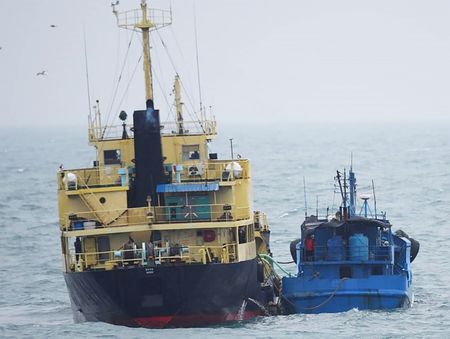
ワシントン条約で国際取引が禁止されている象牙を密輸出しようとしたとして、警視庁生活環境課は、関税法違反(無許可輸出未遂)の疑いで、東京都台東区の象牙加工販売会社「全日本象牙卸売センター」取締役、土屋雅右(まさお)容疑者(47)=港区高輪=を逮捕した。
逮捕容疑は中国籍の男2人=いずれも同法違反罪で起訴=らと共謀し、平成29年11月28日夜、東京都江東区の岸壁に停泊中のコンテナ船に、加工した象牙605本(約7・5キロ=当時の価格で約32万円相当)を隠して持ち込み、密輸入しようとしたとしている。「密輸に関わった自覚もなければ意識もない」などと容疑を否認している。
同課は同月30日に同法違反容疑で、船へ象牙を持ち込もうとした中国籍の船員、陳天彪被告(31)を逮捕。その後の捜査で、別の中国人の男(36)がセンターで象牙を購入し、陳被告に渡していた可能性が高いことが判明したという。
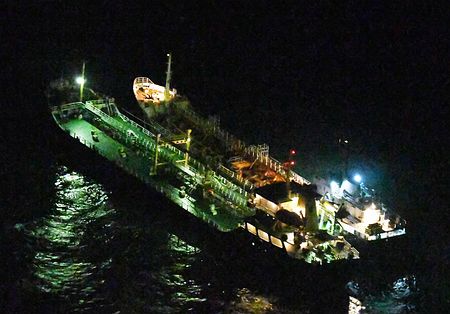
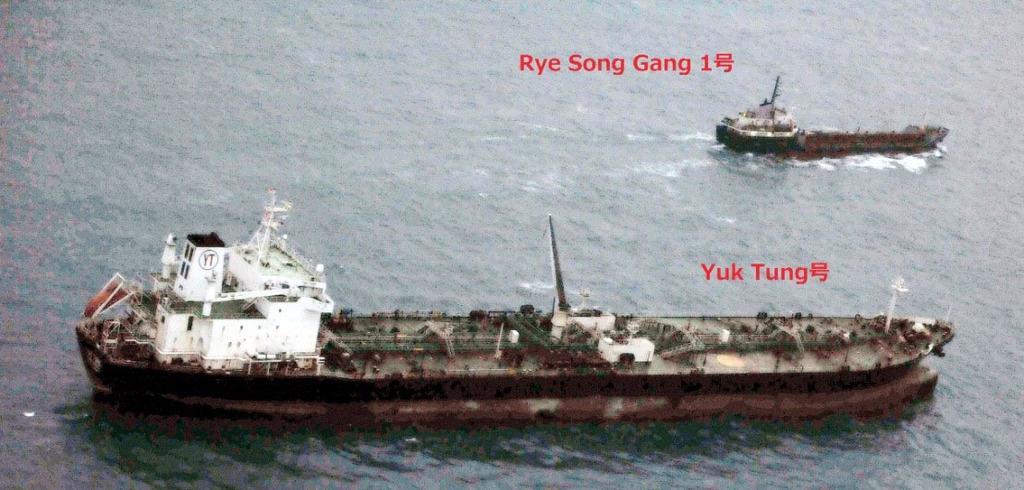
ワシントン=峯村健司
北朝鮮が制裁逃れのためアフリカ船籍などの船舶を使い、石油や石炭を密輸している実態が日米韓の政府関係者への取材で明らかになった。発覚を防ぐため、定期的に船籍を変えているという。16日にカナダ・バンクーバーで開かれる北朝鮮関連外相会合では、ティラーソン米国務長官が海上での船舶の貨物検査強化を各国に呼びかけ、違法行為の監視を強める方針だ。
北朝鮮の密輸を巡っては、昨年10月から12月にかけ東シナ海や南シナ海などの公海上で、複数の外国船舶が北朝鮮側の船に積み荷を移し替えている現場を米軍などの艦艇が確認。積み荷は石油や石油精製品とみられ、ロシアや中国などが関与しているとみられる。
ただ、国連安全保障理事会は昨年9月の制裁決議で北朝鮮の船に海上で積み荷を移すことを禁止。昨年12月の決議では、北朝鮮への石油精製品の輸出を9割削減することも決まるなど、制裁が強まっている。こうした動きに対抗するため、北朝鮮が密輸の手口を巧妙にしているようだ。
日米韓の政府関係者によると、…
水島港に入港したタンカーで覚醒剤6kgを密輸入した疑いでナイジェリア人の船員ら4人が逮捕されました。覚醒剤取締法違反の疑いで逮捕されたのはナイジェリア人の船員オークワン・ゴズタイム・チディマ容疑者(30)ら外国人の船員4人です。警察などの調べによりますと、4人はナイジェリアから来た液化天然ガスを運ぶタンカーで覚醒剤約6kg、末端価格にして約4億2000万円分を密輸入した疑いです。覚醒剤は水島港の手荷物検査でオークワン容疑者のリュックサックの中から見つかりました。警察の調べに対し4人は「何も知らない」と容疑を否認しています。警察は日本に荷受人がいるとみて捜査しています。また、税関は12日付けでオークワン容疑者を関税法違反でも岡山地検に告発しました。岡山県で覚醒剤6kgの押収は過去最多です。

「ライトハウス・ウィンモア号」(M/V "LIGHTHOUSE WINMORE", IMO: 9635987)は、「台湾企業に数カ月前、貸し出した」となっているが
裸用船なのであろうか?裸用船であれば船員と船を管理する会社は借り手が手配する事もあるので貸し手が船の動向を知らない事もある。
裸用船でなければ、船員や管理会社は船に対する指示を船主に報告できるので、知らないとは言えない。
「タンカーを昨年11月に摘発した韓国政府当局の説明によると、同タンカーを借りたのは台湾に拠点を置く『ビリオンズ・バンカー・グループ』。台湾当局は『同社の法人登記はマーシャル諸島にあり、台湾人の関与については調査中』としている。」
「ビリオンズ・バンカー・グループ」の拠点が台湾となっているが、実際に事務所が台湾にあるのなら、調査を行えるのかは台湾の法律及び台湾次第。
多くの船の所有会社がオフショア会社として登記されるのは普通である。しかし、登記されていない実質の船主は存在する。
ISMコードが存在するため、調査するのはそれほど難しくはないと思うし、
ISPS(国際保安)コードが存在するため、管理会社が洋上で受け渡しに関して記録をしないように
指示しない、そして/又は、受け渡し書類に関して消去していない限り、偽造された書類又は何らかの書類が存在するはずである。
船を借りた会社が違法行為であるとの認識があれば、多くの書類が存在しない、又は、偽造されていると思う。
| From(Maritime Connector.com) | |
|---|---|
| Ship Name: | LIGHTHOUSE WIN MORE |
| IMO: | 9635987 |
| Type of ship: | OIL/CHEMICAL TANKER |
| Flag: | HONG KONG |
| Gross tonnage: | 11253 tons |
| Year of Built: | 2014 |
| Builder: | YINXING SHIPYARD - JIUJIANG, CHINA |
| Class Society: | BUREAU VERITAS |
| Manager: | LIGHTHOUSE SHIPMANAGEMENT - GUANGZHOU, CHINA |
| Owner: | WIN MORE SHIPPING - HONG KONG, CHINA |
【台北・福岡静哉】香港船籍のタンカー「ライトハウス・ウィンモア号」が東シナ海で石油精製品を北朝鮮船に移し替えたとされる問題で、タンカー所有会社「ウィンモア・シッピング」(中国・広東省)の関係者は2日、「台湾企業に数カ月前、貸し出した」と認めたうえで、「北朝鮮との貿易に使われるとは知らなかった」と弁明した。香港紙「サウスチャイナ・モーニング・ポスト」(電子版)の取材に答えた。
タンカーを昨年11月に摘発した韓国政府当局の説明によると、同タンカーを借りたのは台湾に拠点を置く「ビリオンズ・バンカー・グループ」。台湾当局は「同社の法人登記はマーシャル諸島にあり、台湾人の関与については調査中」としている。
聯合ニュースは31日、北朝鮮の船舶に石油精製品を移し替えた疑いのあるパナマ船籍の運搬船を、韓国西部の港で当局が調べていると伝えた。事実なら、韓国政府による北朝鮮船への移し替え確認は、南部の麗水港で検査した香港船籍の貨物船「ライトハウス・ウィンモア」に次ぎ2例目となる。
聯合によると、韓国当局は「北朝鮮との関連が疑われる船舶」としてパナマ船籍の「KOTI」号を調べている。船員の大部分は中国人やミャンマー人。出港を許可せず、調査には関税庁や情報機関の国家情報院が当たっているという。
国連安全保障理事会は9月、海上で北朝鮮の船に積み荷を移すことを禁止する制裁決議を採択した。しかし、既に韓国が確認した香港船籍の貨物船のほか、ロシア船籍の複数のタンカーも過去数カ月間に北朝鮮の船舶に石油精製品を移し替えたとの報道もある。(共同)
【ソウル聯合ニュース】北朝鮮船舶に石油精製品を移し替えた疑いで、パナマ船籍の石油タンカー「KOTI」号(5100トン)が韓国西部の平沢・唐津港で関税庁など関連機関の検査を受けていることが31日分かった。平沢地方海洋水産庁が明らかにした。
乗船していたのは中国人とミャンマー人が大部分で、関税庁と情報機関・国家情報院が合同で調べを進めているもようだ。
韓国政府は29日にも、香港籍の船「ライトハウス・ウィンモア」号が10月に公海上で石油精製品600トンを北朝鮮船舶に移し替えたことを確認したと発表した。11月に韓国南部・麗水に寄港した同船は検査を受け、抑留されている。
国連安全保障理事会は9月、海上で北朝鮮船舶へ積み荷を移すことを禁止する制裁決議を採択している。パナマ籍の船の嫌疑が確認されれば、この制裁決議への違反で韓国当局が船舶を摘発するのは2度目となる。
荒ちひろ、遠藤雄司、小坪遊
象牙を日本国内から密輸出しようとしたとして中国籍の男が先月、警視庁に逮捕された。象牙の国際取引は約30年前にワシントン条約で禁止され、国内市場の閉鎖に踏み切る国が相次ぐが、日本は文化的背景などを理由に市場を維持し続けている。国際NGOなどからは改善を求める声が上がっている。
11月28日午後11時45分。東京港に停泊していたコンテナ船に戻ろうとする中国人の男が茶色の紙袋を携えているのに、東京税関の職員が気づいた。3時間ほど前の入国時には持っていなかったものだ。
調べると、紙袋と男が背負っていたリュックに淡い色の小さな角材が大量に入っていた。「友だちにもらったアイボリー(象牙)です。スタンプに使います」。素直に認めたという。
「象牙を密輸出しようとしている」と警視庁に連絡。専門家の鑑定結果も踏まえて警視庁生活環境課が30日、男を逮捕。今月19日に起訴された。
男はコンテナ船員の陳天彪(ちんてんぴょう)被告(31)。約1センチ四方で長さ約10センチにカットされた象牙の印材605本(重さ約7キロ、約31万円相当)を許可なく、江東区青海3丁目の埠頭(ふとう)に停泊中のコンテナ船に持ち込み、密輸出しようとしたとされる。印材は「8ミリ 角棒 35本」などサイズごとに紙に包まれていた。警視庁によると象牙の印材は、中国では日本の3~4倍の値がつくという。
陳被告は逮捕時には「自分の荷…
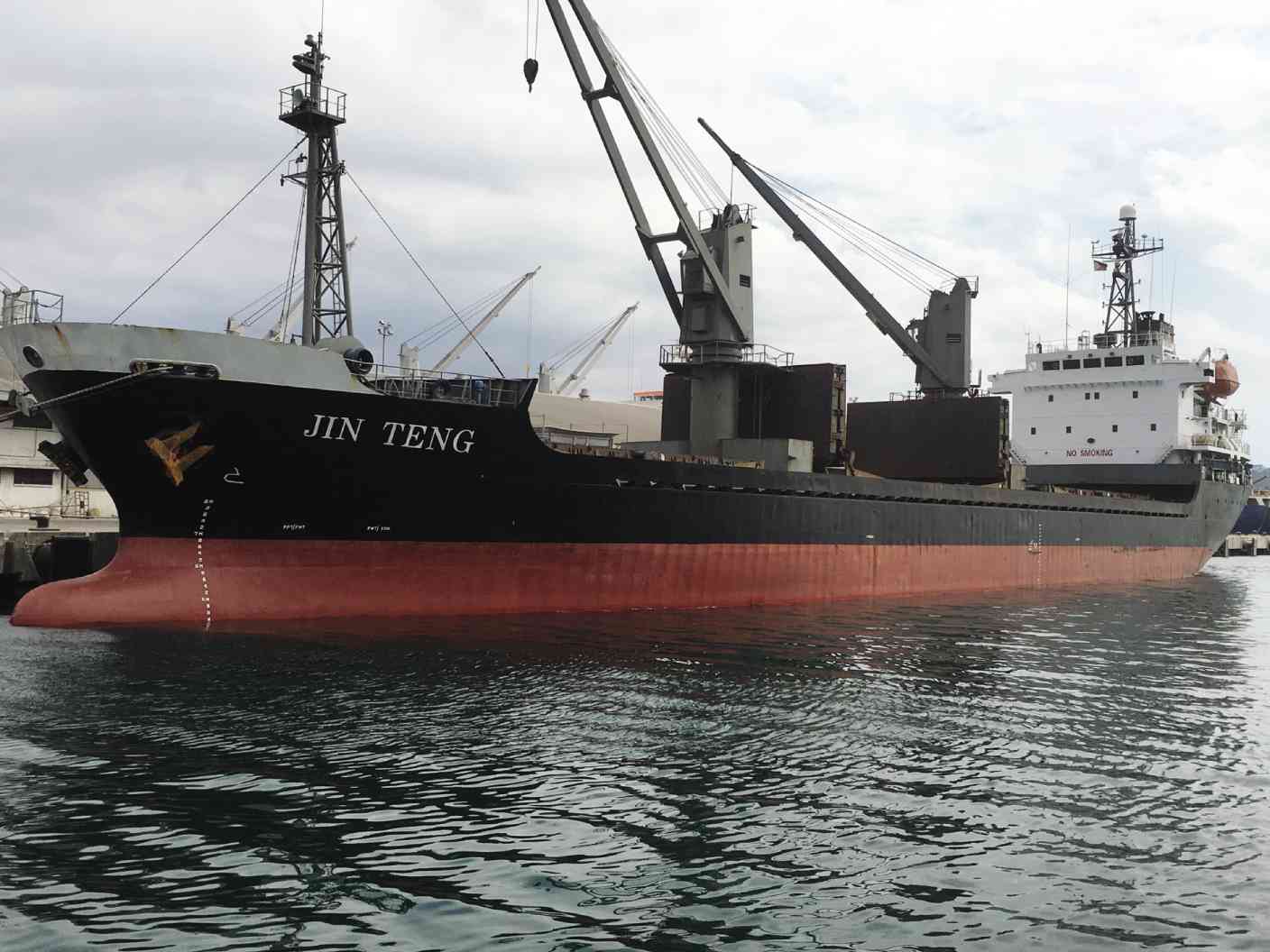
国連安全保障理事会の対北制裁に反して、石油とみられる物資を他の船舶との間で受け渡ししている様子を撮影した画像が21日、公開された。この動かぬ“証拠”により、北朝鮮船舶は追加制裁の対象に指定された。写真は先月19日に撮影されたものという。
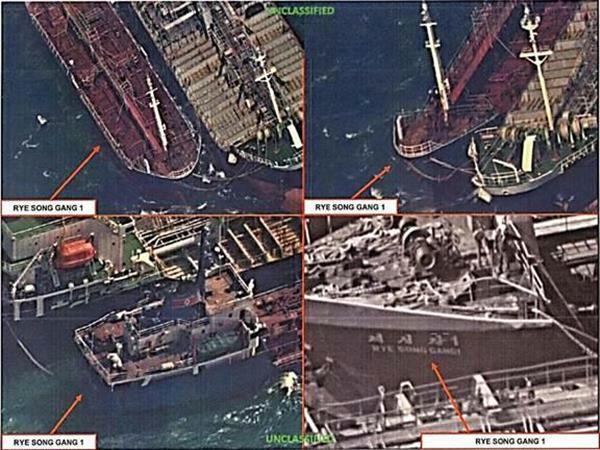
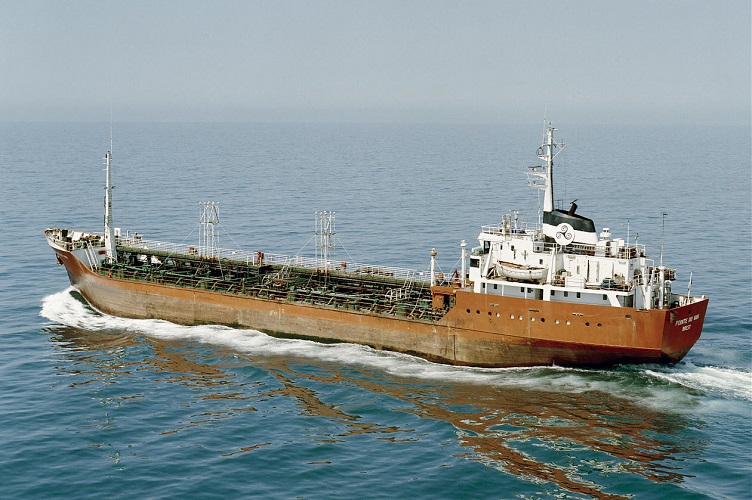
The United States has sanctioned North Korea’s maritime administration, along with six North Korean and four Chinese shipping companies, in an attempt to block Pyongyang from evading tightening trade restrictions.
Swept up in the sanctions, announced on 21 November, are 20 North Korean-flagged vessels, some of which are suspected of engaging in ship-to-ship transfers of oil, coal, and other commodities.
It is the latest effort by the Trump administration to disrupt North Korea’s funding of its nuclear and ballistic missile programmes.
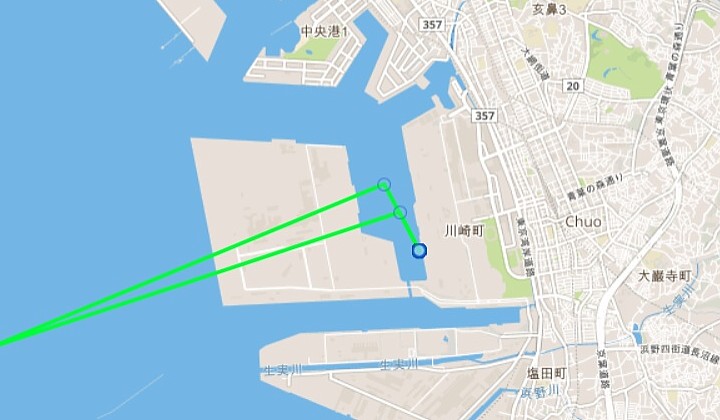
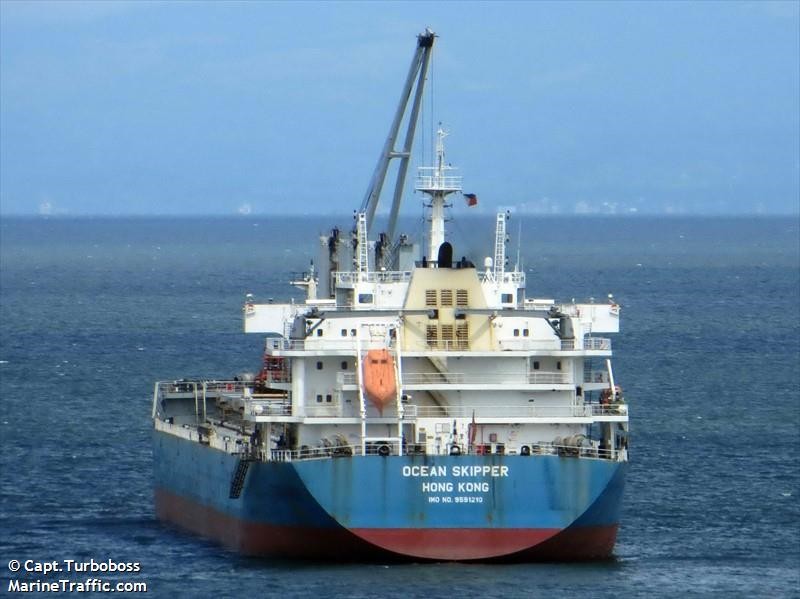
| From(Maritime Connector.com) | |
|---|---|
| Ship Name: | OCEAN SKIPPER |
| IMO: | 9591210 |
| Type of ship: | BULK CARRIER |
| Flag: | HONG KONG (CHINA) |
| Gross tonnage: | 33456 tons |
| Year of Built: | 2011 |
| Builder: | XINGANG SHIPBUILDING HEAVY INDUSTRY - TIANJIN, CHINA |
| Class Society: | LLOYD'S SHIPPING REGISTER |
| Manager & Owner: | HONGDA SHIPMANAGEMENT - FUZHOU, CHINA |
「北朝鮮に寄港した全船舶は、日本政府の独自制裁により入港を禁じられている。」
いつ適用となったのか知らないが、そんな規則があるのであれば、船舶代理店が通報する国際航海・港湾保安法に基づく船舶保安情
報(事前通報)の時に過去2年に北朝鮮に寄港したか一緒に報告させれば良い。もし、虚偽の報告をした場合、船舶代理店、及び/又は、
船長を処分すればよい。
外航船(外国の港に行く事が出来る船)ISPS(国際保安)コードの要求を満足する必要があるので
少なくと過去1年に寄港した港の記録は持っているはずである。2、3年の寄港記録を持っている船はたくさんある。
「小此木八郎国家公安委員長は同日の記者会見で、『国際社会と連携して北朝鮮に対する圧力を強化している段階において、このようなことは断じてあってはならない』と述べ、
再発防止に向け、警察当局に関係機関との連絡の徹底などを指示したという。」
小此木八郎国家公安委員長は本気で上記の事を言っているのなら、国土交通省と直ちに規則の改正又は通達で船舶代理店が通報する国際航海・港湾保安法に基づく船舶保安情
報(事前通報)で北朝鮮に寄港した事があるのか、あれば、最後の寄港日時を連絡するようにすれば良い。
対応しないのならやる気のない単なるパフォーマンスだと思う。
北朝鮮を経由した疑いのある船が千葉港に入港し、必要な対処が取られないまま出港していたことがわかりました。千葉県警によりますと、11月3日、香港籍の貨物船、「OCEAN SKIPPER」号が千葉港に入港しました。
その後、11月12日になって県警の水上警察隊の警察官が貨物船を訪問した際、船員の説明や書類からことし1月と2月に、この船が北朝鮮に寄港した疑いが浮上しました。ただ、警察内での連絡が適切に行われず、千葉海上保安部への連絡や必要な事実確認も行われないまま、13日の昼ごろに貨物船は出港したということです。日本の制裁措置として、北朝鮮に寄港した貨物船の入港は現在禁止されていて、県警は「非常に重く受け止めている。再発防止に向けて関係機関などへの報告・連絡をはじめ、必要な措置を迅速に講じていきたい」とコメントしています。
チバテレ(千葉テレビ放送)
今月3日に千葉港へ入港した香港船籍の貨物船が、今年初めに北朝鮮に寄港していた疑いがあることが17日、捜査関係者への取材で分かった。
北朝鮮に寄港した全船舶は、日本政府の独自制裁により入港を禁じられている。千葉県警の警察官が船員の話や書類の記録などで寄港を把握したが、刑事手続きなどは行われないまま既に出港したという。
小此木八郎国家公安委員長は同日の記者会見で、「国際社会と連携して北朝鮮に対する圧力を強化している段階において、このようなことは断じてあってはならない」と述べ、再発防止に向け、警察当局に関係機関との連絡の徹底などを指示したという。
関係者などによると、貨物船は「OCEAN SKIPPER」号(乗組員22人)。県警の警察官が12日に貨物船を訪問した際、船員から、1月と2月に北朝鮮から中国へ石炭各数万トンを運搬したとの説明を受けた。しかし、刑事手続きは取られないまま、貨物船は13日に金属のスラグを積みシンガポールに向け出港した。
千葉海上保安部によると、通常は海運会社を通じて直近10カ所の寄港状況を把握している。今回はその中に北朝鮮への寄港情報はなく、県警から情報が入ったのは出港後の14日だったという。
政府は2日、北朝鮮に対し、人や資金の移動を規制する新たな独自制裁を決定した。資産凍結対象は中国の企業・個人を新たに加えるなどし、43団体・40個人から54団体・58個人に拡大。ただ、独自制裁に残されたメニューは限られており、既存の制裁を含め実効性をどう確保していくかが課題となる。
北朝鮮が9月に行った5度目の核実験や相次ぐ弾道ミサイル発射を受け、国連安全保障理事会は制裁強化決議を決定。独自制裁はこれを受けたもので、拉致問題に進展がないことも考慮に入れた。閣議決定などの手続きを経て順次発動する。
資産凍結の対象に中国企業を加えたのは、これまでの経済制裁で「抜け穴」と指摘される第三国企業による取引を遮断する狙いからだ。米政府も9月に中国・遼寧省の貿易会社を制裁対象とした。
このほか、在日外国人の核・ミサイル技術者の往来規制では、北朝鮮からの再入国禁止対象を拡大。原則禁止としている在日本朝鮮人総連合会(朝鮮総連)関係者の再入国についても対象を広げる。外国籍船が対象だった北朝鮮に寄港した船舶の日本への入港禁止も、新たに日本籍の船舶を追加した。
政府は2014年、北朝鮮が拉致被害者の再調査を約束したのと引き換えに独自制裁を緩和した。しかし、今年2月、再調査が進まないことや1月の核実験を受け、再び大幅に強化した経緯がある。
安倍晋三首相は2日、北朝鮮の一連の挑発について「新たな段階の脅威であり、このような暴挙は断じて容認できない」と強調。ただ、残されたカードは少なく、外務省幹部は「米韓両国と一緒にやるというメッセージにはなるが、独自制裁だけでは大したことはできない」と明かす。
鹿児島県徳之島に覚醒剤約100キロを陸揚げしたとして、門司税関などは24日、住所不定、無職の男(64)を、関税法違反容疑で福岡地検に告発した。
告発の容疑内容は、共謀の上、平成28年2月6日、東シナ海の海上で、船籍不明の船舶から覚醒剤約100キロを受け取り、同月8日、鹿児島県徳之島の漁港に陸揚げし、輸入してはならない貨物である覚醒剤を輸入した容疑。
第10管区海上保安本部(鹿児島市)は18日、鹿児島県・屋久島の安房港(屋久島町)沖合で6月に見つかった白い粉末入りの小袋200個(約70キロ)の中身は全てヘロインで、国内で一度に押収された量としては過去最高だったと発表した。
10管によると、末端価格は約21億円。10管などは、違法薬物の密輸入が行われようとしていたとみて、関税法違反の疑いで捜査を進める。
白い粉末入りの小袋が見つかったのは6月26日。トビウオ漁をしていた男性が、網に引っ掛かっていた五つの土のうを引き揚げ、種子島海上保安署に届け出たところ、土のうに入った箱の中に袋が詰められていた。
朝日新聞が入手した国連安全保障理事会の最新報告書で、エジプト政府が昨年拿捕(だほ)した貨物船から、北朝鮮製のロケット弾3万発が見つかっていたことがわかった。北朝鮮製の武器の押収としては過去最多。北朝鮮は安保理制裁で武器輸出を禁じられている。
北朝鮮制裁の履行状況を調べる安保理の専門家パネルが最新の年次報告書に盛り込んだ。報告書によると、貨物船に積まれていた鉄鉱石の下に79の木箱が隠され、ロケット推進式の擲弾(てきだん)が計約3万発入っていた。中国・南京で荷積みされた「水中ポンプの組み立て部品」と虚偽の説明が記されていたという。
貨物船は昨年7月23日に北朝鮮・海州を出港、マラッカ海峡を通過し、スエズ運河で同8月11日に拿捕された。最終目的地は不明。航海中、位置情報を外部に知らせる船舶自動識別装置(AIS)の電源はほとんど切られていた。旗国はカンボジアで、船長は北朝鮮人だったという。
朝日新聞社
【ニューヨーク=共同】国連安全保障理事会の北朝鮮制裁委員会の専門家パネルがまとめた報告書の全容が24日、判明した。北朝鮮国籍の船長らが乗り組み、エジプト政府が昨年8月に拿捕(だほ)した貨物船から北朝鮮製の携行式ロケット弾約3万発(約132トン)と大量の鉄鉱石が押収されたと指摘。制裁逃れの手法を駆使して大規模な武器取引を企てたとみている。
北朝鮮製の同種武器の押収量としては過去最多。北朝鮮による武器輸出は過去の安保理制裁決議で全面禁止されているが、核・ミサイル開発の資金源の一つとして継続中とみられる。
ロケット弾が隠してあったコンテナの最終目的地は特定されていないが、エジプトのほか、北朝鮮と軍事協力してきたシリアやアフリカ向けだった可能性もある。
共同通信が入手した報告書によると、エジプト政府は昨年8月11日、自国領海で北朝鮮からスエズ運河に向かっていた貨物船を拿捕した。船内を調べた結果、大量の鉄鉱石の下から、分解された北朝鮮製の携行式ロケット弾約2万4千発と約5千発分のロケット弾の部品が見つかった。北朝鮮産の鉄鉱石の取引も昨年3月に安保理が採択した決議で禁止されていた。
船はカンボジアの国旗を掲げ、船荷の品目は「中国・南京で積まれた水中ポンプの組み立て部品」と偽装されていた。
北朝鮮の武器を巡っては2009年、タイ・バンコクの空港に着陸した貨物機から携行式地対空ミサイルや対戦車ロケット砲など計約35トンが押収された例がある。
NEW YORK (Kyodo) -- North Korea is intensifying efforts to evade international sanctions, as exemplified by its attempt last year to export a large number of rocket-propelled grenades, according to a U.N. experts' report obtained by Kyodo News on Friday.
The report, produced by a group of experts under the U.N. Security Council's sanctions committee on North Korea, shed light on the country's continued arms trade activity.
Although its weapons exports are prohibited outright under Security Council sanctions, the regime of leader Kim Jong Un is apparently trying to continue the trade as a means of securing funds for its nuclear and missile development programs.
Pyongyang "is flouting sanctions through trade in prohibited goods, with evasion techniques that are increasing in scale, scope and sophistication," it said.
Egypt last August seized 30,000 PG-7 rocket-propelled grenades and related subcomponents in wooden crates concealed under about 2,300 tons of iron ore in a ship commanded by a North Korean captain.
The case marked "the largest interdicted ammunition consignment in the history of sanctions against the Democratic People's Republic of Korea," the report said, referring to the country by its formal name.
The document also said the shipment of weapons and iron ore "highlights the nexus in trade by the Democratic People's Republic of Korea in a variety of illicit goods," from small arms and light weapons ammunition to minerals banned under a U.N. sanctions resolution adopted last March.
A bill of lading showed the North Korean-made arms were falsely described as "assembly parts" of an underwater pump loaded in Nanjing, China. The transfer of iron ore is also prohibited in principle under the same resolution.
The Cambodian-flagged vessel Jie Shun was intercepted in Egyptian territorial waters when it was en route from North Korea toward the Suez Canal.
The vessel's final destination was not identified as Egypt. The cargo could have been bound for Syria, with which North Korea has pushed for military cooperation, and some African nations.
Since 2006 when North Korea conducted its first underground nuclear test, the isolated country has been subject to six rounds of U.N. sanctions.
On Nov. 30, the Security Council adopted its harshest sanctions yet in response to the country's fifth nuclear test, conducted in September. The measures were aimed at hitting coal, the cash-strapped state's largest export, in an effort to cut off funding sources for its nuclear and missile programs.
China last weekend suspended coal imports from North Korea until the end of the year as part of tightened sanctions against the country in accordance with the latest Security Council resolution.
But China, the main economic and diplomatic benefactor of the North, has been reluctant to pile too much pressure on the country, fearing it could destabilize Kim's regime.
By Jack Davies and Daniel Nass

The Cambodian shipping register rescinded hundreds of so-called flags of convenience last month. In doing so, it began to draw the curtains on 22 years of the Kingdom’s banner flying over arms trading, drug smuggling, human trafficking, sanctions violations, embargo busting and unsafe practices.
The Cambodian Shipping Corporation was established by the government in 1994 and, according to a Ministry of Public Works and Transport website, “began immediately flagging ships of other nations”.
Ships from as far afield as Ukraine and the United States adopted the Cambodian flag as their own, and experts say little or no oversight has been applied to ships that fly the ensign of Angkor Wat.
‘Protecting the abusers’
The past two decades have seen the Cambodian flag blacklisted by the world’s largest shipping watchdogs – the Tokyo Memorandum of Understanding (MoU) and the Paris MoU. Trawling through shipping registries, vessel tracking data and corporate ownership documents across multiple continents, the Post has attempted to catalogue what has been an embarrassing era for Cambodia’s ad hoc merchant marine as it comes to an end.
A 745-tonne cargo ship named the Tallas has been floating inert off the coast of Turkey since August 2015 after years of plying a route across the Black Sea from Crimea to Istanbul. It has not been abandoned in the strictest sense: five of its seven crewmen are still aboard.
But its owner – nominally Importica LP, a shadowy partnership registered, along with 300 others, to a detached home in Inverness, Scotland; whose two listed partners are Belize-registered companies, but whose beneficial owner is reportedly Crimea-resident Nuraddin Asadov – has cut off all funds to vessel and crew.
Russian-language media reported that without cash to replenish the ship’s stocks, fresh water, food and fuel soon ran out. Since then, the crew has reportedly resorted to alternately gathering rainwater and begging fresh stocks off passing ships. For food, they are said to be casting out lines to fish.
The same reports claim the crew has not been paid since July 2015 and has been unable to come ashore in Turkey due to expired documents, leaving them stranded.

Problems mounted for the crew after a Turkish fighter jet downed a Russian bomber conducting a sortie over Syria in November 2015, four months after the Tallas was abandoned by its owner.
The ship’s captain, Valery Nalivaiko, told the Russophone Seafarers Journal that until then, Turkish authorities had been providing support to his crew, but that the deterioration in relations between Ankara and Moscow that followed the shooting saw assistance dry up.
The International Transport Workers’ Federation (ITF) visited the Tallas last October, according to ITF’s maritime coordinator Jacqueline Smith.
“We have tried to assist them, with advice and representation on their behalf to port state control, embassies and the Cambodian register. That register has failed to act to assist them in any way,” Smith said in an email. “The owner has washed his hands of this ship and of its crew. Sadly, the Cambodian flag register has done the same thing.”
“Abandoning a crew miles from home is made much easier if the ship is flying a flag of convenience that embodies lax oversight, anonymity, and a desire to pocket the registration fee and ignore the responsibilities that go with it,” Smith continued. “Those are features long associated with the Cambodian flag.”
But the Tallas’ chequered history did not begin there. In July 2015, the Tallas was identified by Ukrainian NGO the Maidan of Foreign Affairs as one of 105 commercial vessels docking at Crimean ports after the peninsula’s annexation by the Russian Federation, having made its last recorded call at its home port of Yevpatoriya on September 12, 2014.
A legal analysis published in August 2014 by London law firm Reed Smith found that under the EU sanctions, “no funds or economic resources may be made available, directly or indirectly, to or for the benefit” of Crimean ports, raising the question of how UK-registered Importica could have paid for the Tallas to dock in Yevpatoriya without violating those sanctions.

Despite his name not appearing on any documents connected to the company that owns the Tallas, the ITF and Russian-language media outlets both identified Nuraddin Asadov as the principle owner of Importica LP. Russian and Ukrainian numbers listed for Importica have been disconnected and the company’s email address has been disabled. As of press time, a message sent to Asadov’s Facebook account had not been read.]
The ITF’s Smith said that anonymity was a core feature of the flags of convenience system, which often makes it easier for seagoing lawbreakers to escape justice. “[It] allows abuses and enshrines secrecy, protecting the abusers,” she said.
2003-2016: Letting your ‘clean’ flag fly
Until the flag of convenience scheme was scuttled, the body responsible for handling registrations was the International Ship Registry of Cambodia (ISROC), established in 2003 as the successor to the Cambodian Shipping Corporation (CSC), which was dissolved in 2002 as a result of international pressure.
In 2002, French commandos exchanged fire with the crew of a Cambodian-flagged vessel discovered to be laden with more than a tonne of cocaine, according to the New York Times. Also reported in the New York Times was the seizure of 15 scud missiles from a Cambodian-flagged ship destined for Yemen.
The incidents were the straws that broke the back of the international community’s patience.
An inquiry was held by the Cambodian government and the CSC was shut down to be replaced with ISROC.
The new firm, run by a South Korean company and boasting several deputy registrars in such far-flung locales as Russia, Dubai and Greece, presented itself as a safe and reputable one-stop shop for Cambodian ship registration. An archived version of ISROC’s now-defunct website touted Cambodia as “the CLEAN flag”.
But if the change of agencies – briefly – cleaned up the Cambodian flag’s image, it did nothing to help its actual performance. Vessels registered to the Kingdom have continued to flout maritime law and draw regulators’ scrutiny. Last month, six of the nine vessels on the Tokyo MoU’s August 2016 “under-performing ships” list were Cambodian flagged.
Jack Davies and Daniel Nass
North Korea’s couriers
The 5,300-tonne cargo ship called the Pu Hae was flying the Cambodian flag when it made its way across the Yellow Sea from the Chinese port of Weihai to the North Korean port of Nampo on April 30.
The ship has made more than a dozen calls to Nampo, North Korea’s busiest port, and its neighbouring port, Kyomip’O, since late 2013, according to maritime tracking site FleetMon.
Over that three-year period, nearly one in 10 of the vessels that called at Nampo were registered in the Kingdom.
GPS tracks examined by the Post revealed dozens of Cambodian-flagged ships crisscrossing the sea between China and other Pacific nations including Japan, the Philippines, and – for a few – North Korea.
Little information is available about the companies that own and manage these ships, though records reveal they are based primarily in Taiwan, Hong Kong and mainland China.
The Pu Hae’s manager, Hong Kong-based Hua Heng Shipping Ltd, made the news last year when it defaulted on debt, leading South Africa to seize and auction off two ships managed by the firm, according to NK News. Both were crewed by North Koreans, an indicator that the company may have ties to the hermetic state.
Daniel Sneider, associate director for research at Stanford University’s Shorenstein Asia-Pacific Research Center, said via email that ships from both North Korea and China could have reason to hide behind flags of convenience.
Chinese firms wishing to do business with North Korea would benefit from foreign flagging, he said, because “United Nations sanctions against North Korea have put added attention on that traffic.”
China is North Korea’s largest trading partner, he added, accounting for as much as 90 percent of total trade. Trade between the two countries reached nearly $7 billion in 2014, according to the Council on Foreign Relations.
Some North Korean shippers are also compelled to avoid the scrutiny that accompanies the flag of their home nation. “The North Koreans have long used foreign flagging to conceal their activity, particularly things like arms shipments,” said Sneider.
But with its ignominious history, the Cambodian flag does not provide ideal cover for ships hoping to stay under the radar.
“The fact that a ship is flying a Cambodian flag has long acted as a signal to port state control authorities that it requires particular oversight,” said the ITF’s Smith.

The Pu Hae was detained in China in May of this year after a routine inspection – conducted under the auspices of the Tokyo MoU, which regulates international maritime conventions among Asia-Pacific states – found 10 deficiencies, including issues with radio communications, fire safety, navigation safety and lifesaving devices.
Because of these shortcomings, the website of the Tokyo MoU classifies Pu Hae as a “high risk ship”. This is far from a rare distinction: of the 4,150 inspections of Cambodian ships conducted under the MoU between 2013 and 2015, 13.5 percent led to detentions, far above the regional average of 4 percent.
And under the Paris MoU, whose purview covers Europe and the North Atlantic, Cambodian ships had a 10.7 percent detention rate, earning the flag a spot on the organisation’s 2015 black list. Of the 19 Cambodian-flagged ships identified by the Post that had been to North Korea, 12 had been detained at least once.
Cambodia-registered ships with ties to North Korea have a long history of maritime mishaps. In 2002, a North Korean freighter was caught carrying 15 Scud missiles to Yemen under the Cambodian flag, according to the New York Times.
And in 2011, Japanese media reported that China had shipped missile-launching vehicles to North Korea aboard the Cambodian-flagged cargo ship Harmony Wish, a claim which China denied.
But as the days of foreign companies doing business – illicit or otherwise – under the Cambodian flag draw to a close, firms must re-register elsewhere.
A representative of Taiwan-based World Merge Shipping Management SA, which manages at least eight ships that have previously flown the Cambodian flag, said she was aware that Cambodia’s flag of convenience program had been terminated at the end of August.
The representative, who did not wish to be identified by name, said the firm had chosen to register in Cambodia because it was convenient “transportation-wise”, but declined to elaborate. She said the company had already taken action to register its ships in another country, which she would not identify.
Online records are gradually beginning to reflect the demise of Cambodia’s flag of convenience policy. In the two weeks since the announcement, re-registrations have been logged for several formerly Cambodian-flagged ships, including the Pu Hae.
As of September 6, the ship had traded the spires of Angkor Wat for the flag of Tanzania.
Circulated to member states
But even as fleets search out new flags, plenty of vessels still roam the oceans bearing Cambodia’s.
The ITF’s Smith cautiously welcomed the rescinding of the Cambodian flag to foreign vessels.
“There will be plenty of Cambodian flag ships at sea . . . Common sense suggests that many, at least for the near future, will be foreign owned,” Smith said. “Potentially this is a very positive step, but it is still way too early to judge its sincerity or effectiveness.”
The Ministry of Public Works and Transport did not respond to a request for comment. However, on August 17, it sent a letter to the International Maritime Organisation (IMO) advising of its decision to close its shipping registry.
“Any ships claimed to be under Cambodian flag after [the end of August], are considered illegal and subjected to applicable international laws and regulations,” the letter signed by Senior Minister Sun Chanthol read, going on to ask the IMO to “convey this information to all concerned member states and authorities”.
The IMO confirmed in an email that it had received the ministry’s letter and had circulated it to all member states.
The International Chamber of Commerce’s Commercial Crime Services (ICCCCS) division welcomed the move, although ICCCCS spokesman Pottengal Mukundan noted in an email that it is “not difficult” for a vessel to hop from one flag of convenience to another.
“Managing a shipping registry properly takes considerable resources and if this is not possible then [closing] it is probably a positive step,” he said.
Additional reporting by Kali Kotoski and Joey Chua Xue Ting
佐賀地検、無許可輸入の関税法違反罪で
佐賀県唐津市の漁港に金塊約206キロ(約9億3000万円相当)を小型船で密輸したとして、佐賀地検は22日、小型船船長の斎藤靖昭容疑者(49)=長崎県壱岐市=ら日本人5人と中国人3人を関税法違反(無許可輸入)罪で起訴した。地検は8人の認否を明らかにしていない。
起訴状などによると、8人は同法違反容疑で逮捕された青森県むつ市、会社員、山崎竹助容疑者(66)らと共謀し、5月30日午後4時40分ごろ、東シナ海の公海上で金塊を国籍不明の船から小型船に積み替え、31日午後3時ごろ名護屋漁港に陸揚げしたとされる。
佐賀県警などは当日漁港には現れず陸揚げ後に福岡空港から韓国経由で中国に出国した中国人の男について同法違反容疑で逮捕状を取っており、国際的な密輸グループが関与していたとみている。【池田美欧】
唐津市鎮西町の名護屋漁港で1日、10億円相当の金塊とみられる荷を密輸した疑いで8人が逮捕された事件。犯行に使われた船は、1週間ほど前にも同じ場所に停泊していたことが地元の人たちに目撃されている。「密輸だったなんて」「なぜここが現場に」-。漁港に動揺と衝撃が走った。
逮捕容疑は、5月31日、金塊とみられる積み荷を積んだ漁船を唐津市の港に入港させ、同日午後3時ごろ陸揚げした疑い。
31日午後3時ごろ、玄海漁協鎮西町統括支所のすぐそばの岸壁に漁船が接岸した。荷降ろしのさなか、静けさを打ち破るように何台もの車が一斉に詰め寄り、沖合からは海上保安庁の船が猛スピードで滑り込んできた。支所の職員の女性は緊迫した状況を振り返る。「保安官が船に乗り込み、『動くな』と叫びながら男を取り押さえていた」
青森船籍、1週間前にも
名護屋漁港は、観光地で有名な呼子港と向かい合う小さな港で、普段は地元の漁船や瀬渡し船、離島定期便しか利用しない。
時折、隣県の漁船が立ち寄ることはある。犯行に使われた船は青森県の船籍を表す「AM」の文字が記されていたため珍しく、1週間前にも停泊していたのを複数の人が覚えていた。
現場近くの路上で、釣り客を相手に野菜を販売している女性(65)は「船から降りてきた男の人3人が『たばこ屋どこですか?』と聞いてきた。『野菜いらんですか?』と言ったら、『青森に帰るからいらない』と言われて。1人はどう見ても漁師じゃない雰囲気だった」と話す。
船は照明を縦に連ねてイカ釣り漁船の外観をしているが、仕掛けを巻き上げる機械を積んでいなかった。身柄確保で騒然となった現場に駆け寄った地元の人は一目で船体の不自然さに気づき、「ただごとじゃない」と感じたという。
名護屋漁港では2015年、日本から国外追放処分になっていた韓国人を漁船で日本に密航させたとして、韓国人の男3人が逮捕される事件も起きている。
輸送ルートの解明はこれからだが、福岡県などで金塊を巡る事件が相次ぎ、当局の警戒が厳しくなる中、中国や韓国に近く、人けの少ない漁港が格好の陸揚げ地として狙われた可能性もありそうだ。
各地で航空機を使った金塊密輸事件が相次ぐ中、船舶を使った新たな手口で地方の小さな漁港が狙われた。佐賀県唐津市の漁港で5月31日、金塊とみられる積み荷206キロが陸揚げされて8人が関税法違反(無許可輸入)の容疑で逮捕された事件。捜査当局は事前に情報をキャッチして現場を確認し、一気に容疑者の身柄を押さえる“大捕物”を演じた。
「動くなーっ」。31日午後3時ごろ、静かな漁港の日常が、船に詰め寄る捜査員らの怒号で一変した。それまでTシャツにズボンなどの普段着姿で釣り人やカップルに扮(ふん)していた捜査員らが、一斉に男らを取り押さえる。男らが金塊とみられるものを陸揚げした直後だった。10台以上の捜査車両も猛スピードで船を取り囲み、上空にヘリコプターが旋回する。船から降ろされた男らは岸壁に膝を抱えた格好で座らせられ、うなだれていた。
一部始終を目撃した漁港近くに住むアルバイトの女性(65)は、船が1週間ほど前にも来ていたのを覚えていた。たばこ屋を探す男らに「野菜買って」と話しかけると「青森に帰るからいらない」と断られたという。「こんな事件が起こるなんて」と女性は驚きを隠せない様子だった。
これまでの金塊密輸事件は、航空機で持ち込む事例が大半だ。財務省関税局によると、昨年6月までの1年間で摘発された金塊密輸事件は294件。うち約98%の287件は航空機を使った手口だった。薬物の密輸で船が使われるケースはあったが、金塊が海路で大量輸送された例は「聞いたことがない」(同局)という。
一方、空路による金塊密輸事件はここ数年で急増。日本国内に密輸して転売すれば消費税分の8%が丸もうけとなるためだ。持ち込み量の大口化も進み、各空港が取り締まりを強化してきた経緯がある。同局は「摘発増加を受け、密輸組織が新たな方法を考えたのかもしれない」と話す。
現場となった名護屋漁港近くの自営業の男性(52)は、青森県所属の船舶番号で、イカ釣り用のランプは設置されているものの船内に漁具はなく「明らかにおかしい船だった」と話す。近くの無職、太田ヒデ子さん(87)も「東北の船や外国人なんて地元で見たことがない。今までこんなことなかったから、ただ驚いている」と興奮した様子で話した。【石井尚、吉川雄策、宗岡敬介】
第7管区海上保安本部(北九州市)は1日、漁船を使って佐賀県唐津市の港に金塊とみられる積み荷約206キロを密輸したとして、関税法違反(無許可輸入)の疑いで長崎県壱岐市勝本町、船長斎藤靖昭容疑者(49)や中国人の男ら8人を逮捕したと明らかにした。
逮捕容疑は、5月31日、金塊とみられる積み荷を積んだ漁船を唐津市の港に入港させ、同日午後3時ごろ陸揚げした疑い。
7管は、沖合などで金塊を取引した可能性もあるとみて調べている。
金塊約30キロを密輸したとして、愛知県警が1日に関税法違反などの疑いで逮捕した同県の女5人は「普通の主婦」(捜査関係者)だった。摘発される金塊の密輸事件は近年増加しており、県警は「氷山の一角。同種の事案はたくさんある」と指摘する。
県警によると、5人のうち、韓国籍の李芳子容疑者と金愛子容疑者は親子で、残り3人は李容疑者の知人。李容疑者は事件後、韓国に戻ったリーダー格とされる50代の女と連絡を取り合い、他の4人に持ち掛けていた。
この女は5人から金塊を受け取り、売却して得た金で報酬を支払っていたとみられる。
財務省によると、金の密輸による処分件数と脱税額は増加傾向にある。昨年6月までの1年間で294件、約6億1千万円に上り、統計を始めた平成17年7月以降で最多。香港や韓国と直接行き来できる大きな国際空港がある場所で件数が多いという。
摘発件数の半数以上は、今回の5人と同様、体に巻き付けたり衣服に隠したりする手口という。
5人は「アルバイト感覚で過去に複数回、金塊を密輸した」と供述。税関の担当者は「薬物の密輸と違い、金塊自体に違法性はないため一般の人が罪の意識を持たず、犯罪に手を染めてしまっている」と話す。
福岡地裁 「過去にも3回」「小遣いにと軽い気持ちで」
韓国から福岡空港に金塊を密輸しようとしたとして、関税法違反(無許可輸入未遂)などに問われた堺市堺区の大阪市営地下鉄職員、大成牧生被告(54)は23日、福岡地裁(森喜史裁判官)であった初公判で、過去にも3回金塊を密輸していたことを明らかにした。1回当たりの報酬は14万円で、「小遣いになればと軽い気持ちでやった」と述べた。
検察側の冒頭陳述などによると、2016年9月下旬ごろ、パチンコ仲間の男から神戸市の飲食店で密輸を持ちかけられ、昨年11月以降3回密輸した。いずれも韓国・仁川(インチョン)国際空港のフードコートで氏名不詳の人物から金塊を受け取り、トイレで股間や足の裏に隠して飛行機に搭乗。福岡空港に到着後にパチンコ仲間の男に金塊を渡し、報酬を受け取っていた。
渡航費や宿泊費は自己負担だったため、実質的利益は1回6万円程度だった。同じ男の指示で運び屋をしていたのは被告の他にも4、5人いたという。
起訴状によると、パチンコ仲間の男らと共謀して3月21日、韓国から福岡空港に金の延べ板3個(1300万円相当)を無許可で輸入し、消費税など約108万円を免れようとしたとされる。【平川昌範】
メキシコから横浜港に陸揚げされたコンテナから昨年、覚醒剤約230キロが見つかり、県警が麻薬特例法違反の疑いで、ともにメキシコ国籍で職業不詳の男(32)と女(34)の2人と、日系ブラジル人の男4人の計6容疑者を逮捕していたことが22日、捜査関係者への取材で分かった。末端価格は約161億円に上り、県警が一度に押収した量としては過去3番目、全国の警察が昨年押収した量としては2番目の多さだという。
県警は国内で販売する目的で密輸されたとみて、3月上旬にも覚せい剤取締法違反の疑いで、このうち起訴されたメキシコ人の男女2人と日系ブラジル人の男(49)の3人を再逮捕する方針で、密輸組織の関与など全容解明を進めている。
捜査関係者によると、昨年7月下旬、メキシコから横浜市中区の南本牧ふ頭に陸揚げされたコンテナの中に覚醒剤があるのを、横浜税関の職員がエックス線検査で発見。中をくりぬいた金属製パイプ(高さ約80センチ、直径約20センチ)46本に隠されており、中身を入れ替えて行方を追跡したところ、埼玉県内の資材置き場に運ばれた。
パイプの大部分はその後、さらに相模原市緑区の倉庫に運ばれ、県警は同年12月4日、現場にいたメキシコ人の男女2人を逮捕。
県警の調べに対し、2人は当初「中身は知らなかった」と容疑を否認していたが、その後は「違法な薬物かもしれないと思っていた」と供述している。その後同月12日までに、残る4人も逮捕した。
■密輸量が大口化 高価格の日本が「最終目的地」に
警察庁のまとめなどによると、全国の警察が昨年1年間に摘発した覚醒剤密輸事件の押収量は1トンを超え、2002年以降で最多だった13年の816・1キロを大幅に上回る見通しとなっている。
13年を除き、11年以降は300~400キロ台で推移。昨年の急増は、神奈川県警の230キロ以外にも、沖縄県警が5月、密輸しようとした台湾人が乗ったヨットから一度の押収量として過去最多の597キロを発見、警視庁も150キロ超を2度押収するなど、全国で大型の摘発が相次いだためだ。1件当たりの密輸量の大口化について、ある捜査員は「日本は覚醒剤の価格が高く、需要も多いため『最終目的地』として目指してくる。一発勝負。成功すれば大もうけ」とその背景を明かす。
県警が昨年1年間に摘発した覚醒剤の密輸事件は6件。台湾から横浜港に来た船の貨物コンテナの中から50キロが見つかったほか、国際郵便としては過去最多の36キロが押収された。
捜査関係者によると、体に巻き付けたまま航空機に乗るといった「運び屋」が減る一方、国際郵便を利用するなど手口が巧妙化。「運び屋は捕まりやすい。逮捕されにくいように、一度郵便局留めにし、様子を見て受け取りに行ったり、別の場所に転送させたりする手口もある」(捜査関係者)。今回も発見から逮捕までに4カ月以上を要したが、「警戒心が強く、なかなか姿を現さなかった」(同)という。
また1グラム当たりの末端価格は09年は9万円だったが、最近は7万円に“値崩れ”。捜査関係者は「摘発されているのは一部。供給過多となっており、安い値段が維持されているのでは」と分析している。
以前、ある場所についた客船の保安対策がかなり甘いと感じたことがある。何か悪い事をしようと思えば可能だと思えた。
日本はあるところでは、ばかとかあほとか思うほど厳しくセキュリティーを行うが、別の場所ではとてつもなく甘い、又は、ほとんどノーチェックの
状態である。
クルーズ船だとか、外国人観光客誘致だとか目先の利益を優先してセキュリティーや犯罪のリスクに目を瞑るのはどうかと思う。
ISPS(国際保安)コードが外国船には適用されているが、ISPS(国際保安)コード
に問題がある状態で日本に入港している船はたくさん存在する。問題として認識されていない、又は、問題を発見できていないだけ。チェックする権限を
持っているところが問題を発見できず、問題はないと言えば、専門性がない人達は問題があるとは思わないだろう。
沖縄県警暴力団対策課と那覇署は14日、覚醒剤密輸の「受取人」で、県外へ逃走後に逮捕された台湾人3人を覚せい剤取締法違反(営利目的所持)の疑いで再逮捕した。クルーズ船で来沖した台湾人による一連の密輸事件で押収した覚醒剤は計17・2キロ(末端価格12億400万円相当)に上り、一部は国内で流通した可能性があるという。
クルーズ船を利用した覚醒剤の営利目的密輸の摘発は県内初。県警と沖縄地区税関は同日、押収した覚醒剤を報道陣に公開した。
県警などによると那覇地検は11日、昨年12月20日の台湾発クルーズ船で体に覚醒剤を巻き付けて入国したとして、台湾人の男3人を覚せい剤取締法違反(営利目的輸入)の罪で起訴した。
うち1人は税関の検査をすり抜け、船に戻ったところを共犯容疑で逮捕され、「覚醒剤を人に渡した」と述べた。3人の捜査から「受取人」の別の台湾人3人が浮上。県警が追跡したが県外に逃走しており、一緒に行動していた2人を東京都内で逮捕し、1人のスーツケースから約10キロの覚醒剤を押収した。
逃走したもう1人は関西国際空港で逮捕したが、覚醒剤を所持していなかったため、すでに他の人に譲渡した可能性があるという。
暴力団対策課によると、覚醒剤密輸の摘発人数は2015年はゼロだったが、16年は14人に激増。捜査関係者は「何十万人が利用するクルーズ船を密輸グループが悪用している可能性がある」と警戒している。
横浜港に先月入港した船の積み荷からコカインとみられるおよそ100キロの粉末が見つかり、横浜税関に押収されていたことが捜査関係者への取材でわかりました。粉末の一部を鑑定した結果コカインとわかり、すべてがコカインと判明すれば国内での1度の押収量では過去2番目に多いということです。
捜査関係者によりますと、横浜港の南本牧ふ頭に入港した船の中から、先月6日、コカインとみられる大量の粉末が見つかり、横浜税関が押収したということです。
粉末は、船の積み荷のコンテナの中で見つかり、総重量はおよそ100キロで、一部を鑑定したところコカインだったということです。すべてがコカインと判明すれば、財務省などによりますと、国内での1度の押収量では過去2番目に多くなり、末端の密売価格ではおよそ60億円分になるということです。
コカインが見つかった船は、南米の国や中米のパナマなどを経由して横浜港に到着していました。税関などは、生産地である南米から積み荷に紛れ込ませて密輸しようと企て失敗したものと見て、調べています。
コカインは大量使用で死亡も
コカインは、コカという植物の葉からとれる成分を原料にした麻薬で、違法に流通するコカインの多くは白い粉状です。覚醒剤と同じように神経を興奮させ幻覚症状が現れるほか、一度に大量に使用すると死亡するケースもあるということです。
UNODC=国連薬物犯罪事務所の報告によりますと、原料となるコカは南米で主に生産され、アメリカやヨーロッパの国々などに密輸されているということです。
財務省によりますと、国内でのコカインの押収量は覚醒剤と比べて少ないものの、1度に大量に見つかるケースもあります。1度の押収量としてこれまでで最も多いのは、平成25年11月に神奈川県横須賀市と隣の葉山町にかけての海岸で見つかった合わせて118キロだということです。
コンテナ船に覚醒剤約50キロ(末端価格約35億2千万円相当)を隠して密輸したとして、県警薬物銃器対策課と横浜税関などは7日、覚せい剤取締法違反(営利目的輸入)の疑いで、茨城県古河市大和田の会社役員、林境鴻容疑者(40)=麻薬特例法違反容疑で逮捕後、処分保留=ら、いずれも台湾籍の男2人を再逮捕した。
同課によると、「スクラップを輸入しようとしただけで、覚醒剤が入っているとは知らなかった」などと容疑を否認している。
再逮捕容疑は、8月24日、横浜市中区南本牧の埠頭(ふとう)で、船に積んでいた覚醒剤約50キロを陸揚げして輸入したとしている。
同課などによると、横浜税関が船のコンテナをX線検査するなどして事件が発覚。真ん中が空洞になった状態の鉄製の円柱計25個の中に覚醒剤が詰められていた。
スクラップを装ったとみられ、空洞部分は外から見えないよう、蓋がされていたという。
「県警の担当者は『審査の簡素化に加え、旅行代金が安くなり、富裕層以外も利用するようになった』と背景を分析する。」
常識が考えればわかること。それが出来ないのは県警の能力に問題がある。分析と言う言葉を使うほどでもない。
どのクルーズ船が格安ツアーの割合が高いのか、インターネットとか旅行業者に問い合わせればターゲットを絞り、効率よくチェックできる。
それが出来なかったのであれば、能力か、やる気がなかったと言う事。日本のセキュリティーのレベルは非常に低い。
外国クルーズ船の入港が相次ぐ長崎、佐世保両港で、出港時までに船に戻らず、失踪する訪日客が2015、16年に計17人確認されていることが県警の調べで分かった。不法入国の新たな手口とみて県警は警戒を強めている。
県警外事課によると、15年に長崎港で11人、16年は長崎、佐世保両港で6人が失踪。国籍別では中国人14人、ネパール人2人、フィリピン人1人。このうち10人が入管難民法違反容疑(不法残留)で逮捕されたり、自ら入管に出頭するなどして強制退去させられた。
身柄を保護された場所はほぼ関東地方。失踪者は「就労目的だった」「もっと観光がしたかった」などと動機を話したという。いまだに行方不明の7人も、捜査の網をかいくぐって首都圏などで不法残留していると県警はみている。
国土交通省によると、15年のクルーズ船の寄港回数は博多が259回で全国最多。長崎は131回で2位、佐世保は36回で8位。中国をはじめ東アジアからの訪日客の急増で、地理的に近い九州・沖縄への寄港が目立つ。福岡県警によると、博多港でも15、16年に計17人が失踪している。
クルーズ船の寄港増に対応するため、国は12年以降、特定の船の乗客に対し、顔写真撮影の省略など入国審査の簡素化を図っている。県警の担当者は「審査の簡素化に加え、旅行代金が安くなり、富裕層以外も利用するようになった」と背景を分析する。
法務省入国管理局は「空港経由で入国する不法残留者に比べ、クルーズ船による不法残留者は微々たるものだが、引き続き厳格に対処する」としている。
大阪府警は28日、覚醒剤とみられる薬物計約60キロ(末端価格約48億円)を営利目的で密輸したとして、共に中国籍で、留学生の曹鋭(32)=京都市右京区=と会社員曹春輝(35)=同市下京区=の両容疑者を麻薬特例法違反(業としての不法輸入)の疑いで大阪地検に送検し、発表した。容疑を認めているという。
薬物対策課によると薬物は1~6月、10回にわたって香港発関西空港行きの国際貨物郵便で密輸された疑いがある。円柱形の鉄製容器(直径14センチ、長さ51センチ)に1・5キロずつ分け、木箱に詰められていたという。
府警や大阪税関関西空港税関支署が、税関検査や2人の京都市内のアパートで見つけた95個の鉄製容器のうち、四つの容器に入った覚醒剤約6キロを押収。ほかに空の容器36個で覚醒剤反応が検出されたため、それぞれに1・5キロずつ入っていたとして薬物は約60キロと計算した。2人は香港から覚醒剤約12キロを密輸したとして覚醒剤取締法違反容疑で逮捕・起訴されていた。
ヨット「LA GAETA」をAIS:船舶自動識別装置でチェックしてみると台湾の高雄(Kaohsiung)でロストしています。最後は台湾の高雄で3月20日にロスト。ここから隠密行動でしょうか?
船長は本当に何も知らなかったのでしょうか??
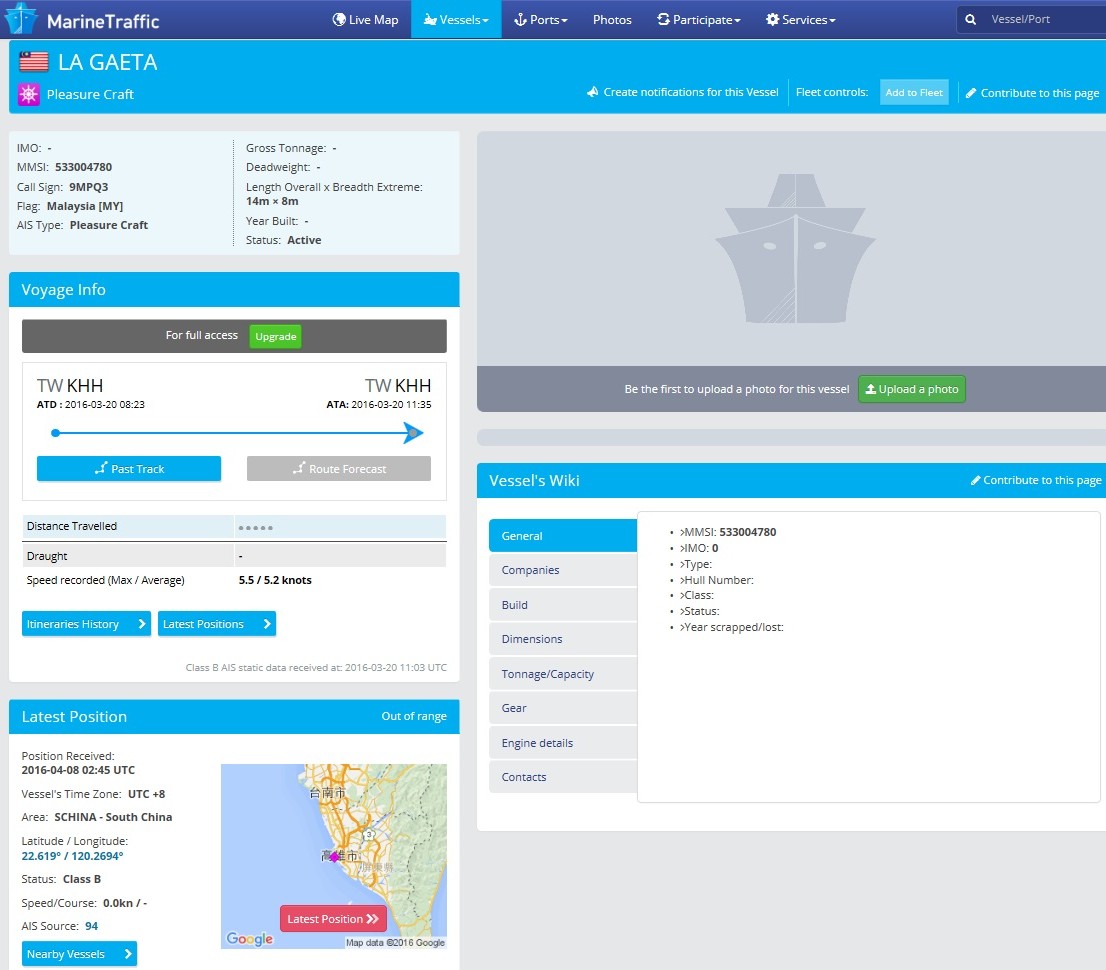
LA GAETA Pleasure Craft (Aarine Traffic)
甘い保安規則を作るから人員が足りないとか騒ぐのだ!自業自得!
セキュリティーに関して甘い国内規則にするからこうなるのだ。まあ、人員が足りないのは何割程度かは知らないが、言い訳だと思う。外航クルーズ船を誘致しているのは
国交省と地方自治体。税関や海保は問題を予測していたはずだ。何も対応をしなかったのか?規則の改正は打診したのか?
まあ、言い訳なのだから、事前に対応する意思もないのだろうからいろいろな事に疑問を持つ事は意味のない事かもしれない。
職員の数に制限があるのであればなおさらセキュリティーに関する甘い国内規則を改正する提案をするべであろう。まあ、やる気のない言い訳だからそのような提案などしないのであろう。
自業自得なので無理をしてでも仕事はするべきだと思う。
那覇市の海の玄関口・那覇ふ頭に停泊した外国籍のヨットから、覚醒剤の国内最大押収量となる約600キロが見つかった密輸入未遂事件。台湾人の男女6人(うち船長ら4人を覚せい剤取締法違反の罪などで起訴)が乗ったヨットは当初、石垣港へ入国したが、現地で税関や海保による密輸監視の目をくぐり抜け、書類審査で3日間停泊した。外航クルーズ船の急増などで離島の監視体制は人員不足が深刻。捜査関係者は「密輸摘発は氷山の一角。水際対策は不十分」と危機感をあらわにする。(社会部・山城響)
ヨットは石垣港から那覇港に入港した際、船内検査で麻薬のケタミンが見つかり、その後の捜査で覚醒剤も押収された。石垣を「通過」したことについて、沖縄地区税関の担当者は24日の記者説明会で、石垣では入港尋問にとどまり、船内検査は実施しなかったと認め「那覇に向かうことも把握し監視の範囲内だった。石垣で取り逃がしたという意味ではない」。船内捜索実施の判断については、「どこで取り締まり、検査するかは人員配置も含めたこちらの事情もある」と説明した。検査の実施基準は「取り締まりの手法に関わる」と回答を避けた。
違法薬物の密輸取り締まりや通関業務を担う沖縄地区税関の職員は約220人。対象は、空港や港の旅客旅具に国際郵便物など多岐にわたる上、近年、海外観光客が急増する離島も抱える。同税関は密輸取り締まりに従事する監視艇「しまかぜ」で薬物の洋上取引にも目を光らせているが「限界がある」(税関幹部)と認める。
県は観光客数1千万人を目標に掲げる。県内に入港する外航クルーズ船は2011年に年間82隻だったが、昨年は202隻。ことしは400隻超と倍増するとみられる。平良港は昨年の13隻から100隻超へ激増する見込みだ。
同地区税関の安井猛税関長は「ここ1~2年で明らかに変化した」と強調。先島地域のクルーズ船増加には、本島から職員を派遣し「どうにかやりくりしている」(税関幹部)のが現状だ。他地区の税関から出向などで10人を緊急増員するも、捜査関係者は「当然、手薄になる状況も出てくる」と明かした。
<薬物密輸で検挙>近年まれに見るハイペース
沖縄県警暴力団対策課のまとめでは5月末現在、薬物密輸の検挙数は8人で、昨年の7人を上回り、「近年まれに見るハイペース」(捜査幹部)という。薬物事犯の発覚するケースの大半が税関検査で、国際郵便物を含む密輸対策も課題となる。税関関係者の中には、国境を接する台湾での「覚醒剤製造拠点」を指摘する声もある。
個人や組織で増加する薬物密輸にどう立ち向かうのか。捜査関係者は「水際対策の人員を増強しないと、物理的に追いつかない。捜査機関全体に言える」と警戒感を強めている。
日本はセキュリティーが甘いから盲点を突けば、いろいろな事が可能。日本周遊の旅を装って全国で覚醒剤の配達と販売を試みたのでは??
運が良ければ不可能ではないと思う。
那覇市の港に停泊し、台湾から来たとみられるヨットの中から、覚醒剤およそ600キロ、末端の密売価格でおよそ420億円分が押収されました。国内で摘発された覚醒剤としては最大の量とみられ、警察などは、売りさばく目的で密輸されたとみて捜査を進めています。
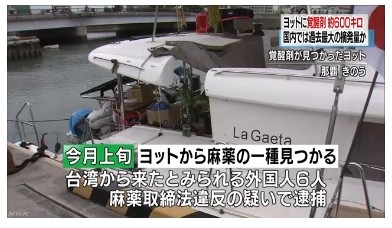
捜査関係者によりますと、今月上旬、那覇市の港に停泊していたヨットの中から麻薬の一種が見つかり、乗っていた台湾から来たとみられる外国人6人が麻薬取締法違反の疑いで逮捕されました。
船内でさらに詳しい捜索が行われた結果、今月17日、およそ600キロの覚醒剤が見つかり、末端の密売価格でおよそ420億円に上るということです。正確な量は今後捜査するということですが、国内で1度に摘発された覚醒剤の量としては、平成11年10月に鹿児島県の海岸で押収された564キロを超えて、過去最大となる可能性があるということです。
捜査関係者によりますと、逮捕されたヨットの船長は調べに対し、およそ600キロの覚醒剤について、「知らない」と話しているということです。
警察と海上保安本部、それに税関は、6人が売りさばく目的で密輸しようとしたとみて、捜査を進めています。
第11管区海上保安本部と沖縄地区税関が、那覇港那覇ふ頭に停泊中のマレーシア船籍のヨットから、覚醒剤約600キロを押収していたことが19日、捜査関係者への取材で分かった。押収された覚醒剤の末端価格は400億円以上とみられ、一度に押収される量では国内最大級。乗組員らは別事件で逮捕されており、県警含め関係機関が全容解明を進めている。
捜査関係者によると、ヨットに乗船していた台湾人乗組員6人は、台湾から石垣島経由で那覇ふ頭に入港。税関の検査で麻薬のケタミンを所持していたとして11日、麻薬及び向精神薬取締法違反で逮捕されていた。
関係者によると、6人中3人は容疑を認めており、ほかは否認している。11管は、覚せい剤取締法違反(営利目的輸入)などの容疑を視野に再逮捕する方針。台湾人船長は容疑については否認しているという。
第11管区海上保安本部と沖縄地区税関が、那覇市通堂町の那覇港那覇ふ頭に停泊中のマレーシア船籍のヨットから、覚醒剤約600キロを押収していたことが18日までに分かった。末端価格約420億円に相当する。捜査関係者によると一度に600キロの覚醒剤が摘発されるのは県内で過去最大とみられる。11管などは県内外で覚醒剤を販売しようとしていた可能性もあるとみて捜査している。
ヨットの台湾人乗組員6人は11日、麻薬ケタミンを共同所持していたとして麻薬及び向精神薬取締法違反で逮捕されていた。11管は覚醒剤の鑑定などを終え次第、覚せい剤取締法違反(営利目的所持)の疑いで再逮捕する方針。
捜査関係者によると、台湾人船長は覚せい剤取締法違反の容疑について「知らない」と否認している。
乗組員は11日午後、台湾から石垣島経由で那覇ふ頭に入港したところ、沖縄地区税関の検査で麻薬のケタミンを隠し持っていたとして逮捕されていた。6人のうち3人は容疑を認めているが、他の3人は否認しているという。
17日午前、11管と税関で行われた合同家宅捜索で船内に隠されていた覚醒剤約600キロが発見された。
ヨットがマレーシア船籍でランカウイ島のものであることから、東南アジアで生産された覚醒剤を台湾経由で運び、日本国内に密輸しようとした可能性がある。
捜査関係者は押収量が大量であることから「県内ではさばき切れない。県外で転売しようとしていた可能性がある」とし、背後に暴力団や海外マフィアなどがいないかなどを県警とも連携しながら捜査を進める方針だ。
日本はセキュリティーが甘いから盲点を突けば、いろいろな事が可能。今回も氷山の一角なのでは??
第11管区海上保安本部(那覇市)などが今月、那覇市の那覇港に停泊中のヨットから覚醒剤約600キロを押収していたことが、捜査関係者への取材でわかった。
末端価格は約420億円に上るとみられるという。ヨットに乗っていた台湾の男ら数人は別の事件で逮捕されており、海保や沖縄県警などは大規模な覚醒剤密輸事件とみて、密輸ルートなど全容の解明を進める。
警察庁の統計によると、覚醒剤の年間押収量は2015年が約430キロだった。今回は1回の摘発で昨年1年間の押収量を上回ったことになる。
捜査関係者によると、男らは今月に入り、海外から同県の離島を経て那覇港に入港した際、麻薬のケタミンを所持していた疑いで逮捕された。その後、海保などが17日に男らが乗っていたヨットを捜索したところ、大量の覚醒剤を発見したという。海保などは今後、覚醒剤取締法違反容疑で男らを調べる方針。
取締る側が、見逃すつもりがあればいろいろな事が可能。
北朝鮮が、ロシア産重油を中国企業を介して経済特区の港に運び、積み荷を放棄させる手続きで密輸していたことが15日、中朝関係者らへの取材で分かった。代金は中国企業を装って中国国内で決済。この重油からは、国連安全保障理事会の対北制裁で禁輸となった航空燃料も精製できるという。軍事転用可能な物資の北朝鮮への流出が懸念される中、制裁を骨抜きにするルートの存在が新たに浮き彫りになった。
中国税関総署によると、北朝鮮への原油輸出は、統計上2014、15年連続でゼロを記録した。にもかかわらず、北朝鮮国内でガソリンなどの価格が高騰せず、平壌市内を多くのタクシーが平然と走るという奇妙な現象が起きていた。
この謎を解く鍵の一つがロシア産重油マズートM100だ。原油の約3分の1という安値で手に入り、中国の中小企業がこの重油からガソリンなどを再精製し、転売してきた。
北朝鮮はこれに着目。中朝貿易関係者によると、書類上、ロシア企業からシンガポールなど東南アジアの企業を経て中国企業が購入したM100を、ロシア極東のウラジオストク港から北朝鮮北東部の経済特区羅先(ラソン)の羅津(ラジン)港に船で運び出す。
M100についてはあらかじめ、積み荷の所有権を放棄する「サレンダー」と呼ばれる手続きが取られ、荷揚げ後は北朝鮮側が自由に持ち出せる。
中国企業にとって表面上ただで手放すことになるが、別の中国企業を装った北朝鮮のダミー会社から中国内の取引として裏で代金が支払われるという。
中国漁船が北朝鮮領海での漁業権と引き換えに朝鮮人民軍に石油を譲り渡したり、北朝鮮に進出した中国企業用と称して運び出したりする手法もあるとされる。こうして統計上ゼロのまま、北朝鮮に石油が供給され続けることになる。
日本や中国の専門家によると、M100からは装置さえあれば、ガソリン以外にも、軍事転用の恐れがあるとして安保理の制裁対象となった航空燃料も精製できるという。
北朝鮮の核実験などを受け、中国は主要銀行による対北取引を原則停止する厳しい措置に出た。しかし、中朝関係者によると、北朝鮮傘下の企業の多くは、中国籍を持つ関係者名義で登記し、中国国内で商取引の大半を完結。本国へ送金する必要はなく、打撃は少ないとみられている。
国連安保理の北朝鮮制裁委員会の専門家パネルは、北朝鮮が日本製レーダーや米国製衛星利用測位システム(GPS)機器を軍事転用していた実態を報告している。こうした物資も中国内の取引を装い、「民生品」に紛れ込ませて密輸していた可能性が高い。
倉敷市・水島港で覚せい剤約6キロ(末端価格約4億2千万円相当)を密輸していたとして、岡山県警組織犯罪対策1課と
水島署は12日までに覚せい剤取締法違反(営利目的輸入)の疑いでナイジェリア国籍のオークワン・ゴズタイム・チディマ
容疑者(30)ら外国人船員の男4人を逮捕した。県警や神戸税関水島税関支署によると、同県内での覚せい剤押収量としては
過去最多。
他の3容疑者はナイジェリア、ロシア、フィリピン国籍。
オークワン容疑者のリュックサックに覚せい剤を持っていたが、4人とも「なぜリュックに入っていたか分からない」と容疑を否認
しているという。「下船後は岡山空港から東京に行き、飛行機で母国に帰るつもりだった」と供述しており、県警は4人が国際的な
密売組織の「運び屋」とみて、日本側の受取人など背後関係を調べる。
4人の逮捕容疑は、昨年12月22日午前11時20分ごろ、バミューダ船籍のタンカーで水島港に寄港し、覚せい剤を密輸
した疑い。水島税関支署の職員が港内の手荷物検査場(倉敷市水島福崎町)で、リュックから不審なビニール袋2個を
発見し、県警に通報した。
県警によると、タンカーは液化天然ガス6万200トンを積載して昨年11月24日、ナイジェリアを出発。12月21日、水島港に
到着した。4人は荷降ろしが終わった翌22日、休暇を取り下船した。
水島税関支署は12日、関税法違反(禁制品輸入未遂)容疑でオークワン容疑者を岡山地検に告発した。
約6キロ(末端価格約4億2000万円)を持ち込んだ疑い。
<山陽新聞デジタル 2016年1月12日配信記事より転載>
昨年12月下旬、倉敷市の水島港に入港した外国貨物船の船員4人が覚せい剤約6キロ(末端価格約4億2千万円相当)を密輸したとして、岡山県警組織犯罪対策1課と水島署などは12日までに、ナイジェリア国籍の船員オークワン・ゴズタイム・チディマ容疑者(30)ら外国人の男4人を覚せい剤取締法違反(営利目的輸入)容疑で逮捕した。県警や神戸税関水島税関支署によると、県内での覚せい剤押収量としては過去最多。
4人は他にロシア、フィリピン国籍で、リュックサックに隠して運び込もうとしたとみられ、「なぜ覚せい剤がリュックに入っていたか分からない」などと容疑を否認しているという。4人は「岡山空港から飛行機で東京まで行き、母国に帰る予定だった」とも話しているといい、県警は4人が密売組織の「運び屋」で、日本側に受取人がいたとみて、背後関係や流通ルートの解明を進める。
4人の逮捕容疑は、昨年12月22日午前11時20分ごろ、バミューダ船籍のタンカーで寄港し、同市水島福崎町の水島税関支署の手荷物検査場から覚せい剤を密輸した疑い。逮捕は同日付。
同支署職員がオークワン容疑者のリュックの中に、ビニール袋などで何重にも巻かれた覚せい剤の袋2個を発見、県警に通報した。
県警によると、タンカーは液化天然ガス6万2千トンを積載して昨年11月24日、ナイジェリアの港を出港、同12月21日水島港に到着した。4人は荷降ろしが終わった同22日、下船した。
水島税関支署は12日、関税法違反(禁制品輸入未遂)容疑でオークワン容疑者を岡山地検に告発した。
県内の覚せい剤密輸事件では、岡山空港で2010年と12年に1回ずつ計約5キロを摘発。新岡山港では11年11月、貨物船の中国人船員が仲間に約3キロを手渡す事件が起きている。
倉敷市の水島港で入国しようとしたナイジェリア人の船員のリュックサックから覚醒剤およそ6キロが見つかりこの船員ら4人が覚醒剤取締法違反の疑いで逮捕されました。
押収された覚醒剤の量は末端の密売価格で4億円あまりと県内では過去最多で、4人はいずれも容疑を否認しているということです。
逮捕されたのはナイジェリア人のオークワン・ゴズタイム・チディマ容疑者(30)らナイジェリア人とロシア人、それにフィリピン人の船員4人です。
警察によりますと、12月22日、オークワン容疑者ら4人はバミューダ船籍の貿易船から降りて日本に入国しようとした際、覚醒剤およそ6キロ、末端の密売価格でおよそ4億2000万円分を密輸した覚醒剤取締法違反の疑いが持たれています。
入国する際の税関の手荷物検査でオークワン容疑者のリュックサックの中からポリ袋などで何重にもくるまれた覚醒剤が見つかり通報を受けた警察などが逮捕したということです。
4人の乗った船は去年11月にナイジェリアを出発し水島港まで液化天然ガスを運んできたということで、船長など29人の乗組員がいましたが4人だけが水島港で入国しようとしたということです。
警察の調べに対し、オークワン容疑者は「なぜ覚醒剤が自分のかばんの中に入っているのかわからない」などと供述し、ほかの3人も「知らない」などと容疑を否認していて、岡山空港などを経由してそれぞれ帰国する予定だったと話しているということです。
警察では入手ルートや覚醒剤の販売先などについても調べを進めることにしています。
岡山県警察本部によりますと、押収された覚醒剤の量は統計が残っている昭和54年以降で県内では過去最多だということです。
ナイジェリアから岡山県倉敷市の水島港に、液化天然ガスを運んだバミューダ船籍のタンカーの外国人船員4人が覚醒剤約6キロ(末端価格約4億2000万円)を密輸。
押収された覚醒剤の量は統計が残っている昭和54年以降で、岡山県内では過去最多。
昨年の2015年12月22日の午前11時20分ごろ、ナイジェリアから岡山県倉敷市の水島港に入港していたバミューダ国籍のタンカーから降りて、共謀して結晶状の覚醒剤約6キロ(末端価格約4億2000万円)を密輸したナイジェリア国籍とロシア国籍とフィリピン国籍の船員の男4人。
入国する際の手荷物検査で、水島税関支署の職員が港内の手荷物検査場(倉敷市水島福崎町)でナイジェリ国籍の船員(30)のリュックサックから不審なビニール袋2個を発見。
ポリ袋などで何重にもくるまれた覚醒剤を発見し、通報。
昨年の2015年11月24日、ナイジェリア国籍らの船員4人を乗せたバミューダ船籍のタンカーは液化天然ガス6万200トンを積載してナイジェリアを出発。
2015年12月21日、岡山県倉敷市の水島港に到着。
荷降しが終わった翌、12月22日、ナイジェリア国籍ら船員4人は休暇を取り下船。
船長など29人の乗組員がいたが、ナイジェリア国籍ら船員4人だけが水島港で入国しようとした。
ナイジェリア国籍らの船員4人が国際的な密売組織の「運び屋」とみて、日本側の受取人など背後関係を調べる。
逮捕されたのは
ナイジェリア国籍の船員、オークワン・ゴズタイム・チディマ容疑者(30)。
他にナイジェリア国籍、ロシア国籍、フィリピン国籍の船員の男3人。
合わせて船員の男4人。
ナイジェリア国籍のオークワン・ゴズタイム・チディマ容疑者(30)は「なぜ覚醒剤が自分のリュックの中に入っているのかわからない」と容疑を否認。
他のナイジェリア国籍、ロシア国籍、フィリピン国籍の船員の男3人も「知らない」などと容疑を否認。
「下船後は岡山空港から東京に行き、飛行機で母国に帰るつもりだった」と供述。
ナイジェリア国籍、ロシア国籍、フィリピン国籍の船員は岡山空港から東京へ行き、飛行機でそれぞれの国へ帰国するつもりだったらしい。
これまでもナイジェリア人、ロシア人の覚醒剤密輸が発覚してる。
日本国内に仲間がいて、大量の覚醒剤を「運び屋」として密輸。
東京に密売組織の仲間がいたのだろうか。
台湾で重大犯罪を捜査する法務部(法務省に相当)調査局などは21日夜、南部・高雄港で、日本向け冷凍キハダマグロ約50匹の内部から覚醒剤約140キロを押収した。台湾メディアが22日、報じた。日本での末端価格は約14億円。
マグロは縦に2つに割って覚醒剤を詰めた後、元の形に戻して再冷凍されていた。冷凍コンテナ内の約300匹のうち、覚醒剤入りの約50匹には、青いシールのようなものが付いていたという。(台北 田中靖人)
【リオデジャネイロ=吉田健一】南米コロンビアの検察当局は3日、中国の国旗を掲げてキューバに向かっていた船から、爆発物の材料となる火薬が大量に見つかったことを明らかにした。
中国人の船長は逮捕された。検察は、軍事物資を違法に輸送した容疑で船長を訴追する方針だ。
検察当局などによると、船長が示した書類では貨物は穀物類と記されていたが、船内から火薬100トンなどが見つかった。納入者として中国の大手武器製造企業の名前が記され、受け取り主にはキューバ企業の名前があったという。
門司税関博多税関支署は20日、ロシア国籍で、福岡県嘉穂郡桂川町、会社役員男(32)容疑者を、関税法違反容疑で佐賀地検に告発した。
同支署の調べによると、ロシア国籍の同容疑者は、今年5月22日、輸出の際に必要な税関長への申告に基づく輸出許可を受けずに、中古トラクター1台をカンボジア王国国籍の船に積み込ませ、ロシアに向けて輸出しようとした疑いで、貨物確認にあたった同支署の税関職員に発見され、摘発された。
その後の調べで、同容疑者は昨年4月14日から8月24日まで、9回にわたり、同様の手口で、船外機46機をロシアに輸出した疑い。
この事件では、同支署が佐賀県、熊本県、宮崎県の各県警と共同捜査を続けていた。
=2014/10/20 西日本新聞=
個人的な意見だがやはり九州はセキュリティーが甘いと思う。ISPSコードの要求を満足していない外国船舶が接岸するバースも存在するので狙われるのだろう。
韓国・釜山(プサン)港との定期旅客航路などを持つ博多港(福岡市)で、大量の覚醒剤を密輸する事件の摘発が相次いでいる。
同港で10年ぶりに密輸事件が起きた2012年7月以降、計4件を摘発し約263キロ・グラム(末端価格約184億円)を押収した。警戒が緩いとみて地方の港を選ぶ密輸者が増える傾向にあるのが理由とみられ、税関側はトラックごと調べられる大型X線装置の導入や職員の訓練などで摘発態勢を強化している。
覚醒剤の摘発を巡っては、北海道・室蘭港で10年11月に約5キロ、岡山県・宇野港で11年11月に約3キロが発見されるなど、ほとんど摘発のなかった地方港での密輸事件が目立つようになった。
博多港でも02年1月に中国籍漁船から約151キロを押収して以降は摘発がなかったが、12年7月、釜山から高速船で博多港に来た韓国籍の男が覚醒剤約1キロを所持しているのを職員が発見。男が「3日間の観光旅行」と説明したのに、持ち物がバッグのみだったのを、職員が不審に思い調べたところ、インスタントコーヒーのスティック状の袋などに覚醒剤が隠されていた。
博多港で旅客船で持ち込まれた覚醒剤の摘発は初めてで、同年12月には高速船で入国したドイツ国籍の女のバッグから約2キロを職員が見つけた。
門司税関博多税関支署では、旅客や貨物が少ない時間帯に少なくとも月に数回、職員に対して実践的な訓練を実施。客に扮(ふん)したベテラン検査員が、覚醒剤に見立てた白い粉をバッグや靴、体に隠しているのを、職員が発見できるかどうかをチェックする。見つけられない場合は、改善策を話し合うという。
貨物船を使用し、押収量が100キロを超える密輸事件も同港で続いた。同月、オランダで積み込まれ、博多港に陸揚げされた重機の中から約110キロ、今年1月にもメキシコから来た加工石の中から約150キロが見つかった。
同支署では03年4月、大型のX線装置を導入している。装置にはコンテナを運んできたトラックごと入れることができ、この2件はいずれも同装置で密輸を見破った。ただ、X線で貨物内部から覚醒剤を見つけるには、一定期間、専門的な訓練を受けることが必要で、職員らは技術向上に励んでいる。
同支署の小手川祥悟総務課長は「以前から地道にやってきた訓練の成果が実を結んできている。今後も、水際で阻止できるよう努力を続けたい」としている。(今泉遼)
SINGAPORE - Criminal charges were filed against a Singapore-registered shipping company yesterday for helping to smuggle missiles and fighter jets from Cuba to North Korea.
Chinpo Shipping Company allegedly transferred US$72,000 (S$90,000) to C B Fenton and Co, a Panama shipping agent, on July 8 last year, knowing that the money could be used to contribute to the "uclear-related, ballistic missile-related, or other weapons of mass destruction-related programmes or activities" of North Korea. This was in breach of United Nations sanctions restricting arms trading with North Korea because of its nuclear weapons programme.
The charge carries a fine not exceeding S$1 million.
The shipment of weapons was seized near the Panama Canal, hidden under a cargo of sugar on Chong Chon Gang, a North Korean container ship. Two Cuban fighter jets in perfect condition, missiles and live munitions were found.
In March this year, the UN Security Council's sanctions committee named Chinpo as one of two firms trying to smuggle arms to North Korea ? the other was Pyongyang-based Ocean Maritime Management.
A UN report also alleged that North Korea's embassies, including in Singapore and Cuba, were used to shift arms to Pyongyang via complex financial methods that were "pioneered by drug-trafficking organisations". "The panel has found that North Korea makes increasing use of multiple and tiered circumvention techniques," a summary of the 127-page report said.
Chinpo was also said to share a Beach Road office address with the North Korean embassy here. The report added that Chinpo acted as the agent for Ocean Maritime Management, which operated the Chong Chon Gang.
In a joint statement yesterday, the Ministry of Foreign Affairs and Ministry of Home Affairs said it received information about Chinpo in January and immediately launched an investigation.
"Singapore takes a serious view of our international obligations to prevent the proliferation of weapons of mass destruction, their means of delivery and related materials," the ministries said. "As a responsible member of the international community, Singapore has given full effect in our domestic legislation to the measures prescribed by UN Security Council resolutions and will take action against any individuals and/or companies that flout these.?
Chinpo was charged with a separate offence of carrying on a remittance business without a licence between Apr 2, 2009 and July 3 last year.
Tan Hui Tin, 50, was also charged with helping her father and Chinpo director Tan Cheng Hoe, 80, withhold electronic evidence from the Commercial Affairs Department in February this year. She is understood to have been an accounts executive in the firm at that time. If she is convicted, she could be jailed for up to one month and/or fined up to S$1,500.
Chinpo and Tan are represented by Mr Edmond Pereira, who requested for time to make representations and take instructions yesterday.
The case will be heard on Aug 1.
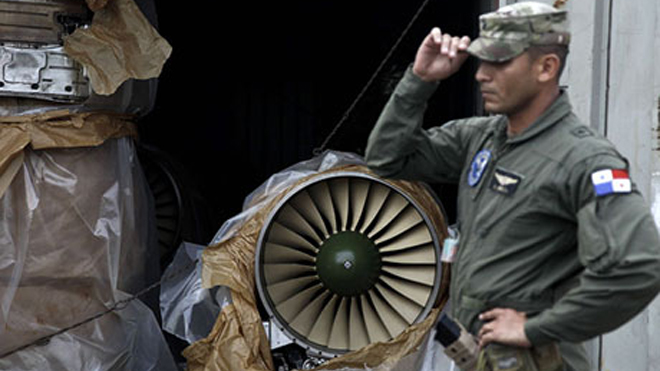
A Panamanian policeman guards a Russian fighter jet engine in one of the hidden containers discovered on a cargo ship bound from Cuba to North Korea via Panama. (ap)
Singapore (AP) - Singapore filed criminal charges Tuesday against a shipping company implicated in a shipment of weapons to North Korea that was seized by Panamanian authorities last year.
Locally registered Chinpo Shipping Company Ltd. was charged with transferring $72,000 to a Panama shipping agent knowing that the funds could be used to contribute to the "nuclear-related, ballistic missile-related, or other weapons of mass destruction-related programs or activities" of North Korea. A Chinpo executive, Tan Hui Tin, was also charged for withholding potential electronic evidence.
The charges stem from an incident that unfolded during the second half of 2013. In July, Panama seized a ship, the Chong Chon Gang, in the Panama Canal which was headed from Cuba to North Korea. Panamanian authorities suspected that it was transporting drugs, but when they searched the vessel they found two Cuban fighter jets, missiles and live munitions hidden in a cargo of sugar.
After the seizure, Cuba said the cargo included "obsolete defensive weapons" including two MiG-21 fighter jets and 15 motors, nine missiles in parts, and two anti-aircraft systems that were being shipped to North Korea "to be repaired and returned."
However, in October, Belsio Gonzlez, director of Panama's National Aeronautics and Ocean Administration, said that the fighter jets "are in operational condition and their engines are in excellent shape." The Central American nation said that the weapons violated U.N. sanctions that restrict arms trading with North Korea because of its nuclear weapons program.
In February, Panama released all but three members of the ship's crew after Chinpo paid a fine of nearly $700,000.
In March, the United Nations Security Council's sanctions committee named Chinpo as one of two companies involved in trying to ship arms to North Korea. The other was Ocean Maritime Management, a Pyongyang-based company.
Singapore's foreign ministry said authorities received information about Chinpo in January this year.
A panel of experts advising the Security Council said in its annual report on North Korea that the country's embassies, including in Singapore and Cuba, were suspected of helping to organize arms shipments to Pyongyang via complex financial methods that were "pioneered by drug-trafficking organizations."
The report said Chinpo Shipping Company was "co-located" with the North Korean Embassy in Singapore and that the shipping firm acted as the agent for Ocean Maritime Management, which operated the Chong Chon Gang.
A woman who answered the phone at Chinpo declined to comment.
By Elena Chong
SINGAPORE - A Singapore-registered shipping company was charged on Tuesday with transferring financial assets or resources that may reasonably be used to contribute to North Korea's nuclear- and ballistic missile-related or other weapons of mass destruction (WMD) related programme. Chinpo Shipping Company's accounts executive Tan Hui Tin, 50, was also brought to court for intentionally aiding her father, Mr Tan Cheng Hoe, 80, the chairman of the company, in not handing over electronic records required by the police. The company allegedly transferred US$72,017 from its Bank of China account to one C.B. Fenton and Co., a shipping agent at Panama Canal, on July 8 last year, having reason to believe that the sum may be used to contribute to the nuclear and other WMD activities of North Korea. The company also faces a second charge of having carried on a remittance business without a valid licence between April 2009 and last July.
「絹代被告らが税関当局に提出した書類では、中国山東省の石島港にある水産会社に輸出することになっていた。李被告は船長を脅したり、なだめすかしたりして従わせた。」
船の用船者や管理会社の了解なしで、中国山東省の石島港ではなく北朝鮮の興南港に入港できないと思う。???
日本政府が経済制裁を科している北朝鮮に、日本から秘かに大量の魚が輸出されていた-。平成23年8月、北朝鮮に大量の冷凍タラを不正輸出したとして、東京地検は20日、外為法違反罪で東京都中央区の貿易会社「東アジアサービス」社長、松本絹代容疑者(47)=江東区=ら3人を起訴した。不正輸出の4カ月後には金正日総書記が死亡し、タラやニシンが特別配給されており、捜査当局は不正輸出されたタラが配給に充てられたとの疑いを強める。絹代被告の実兄も北朝鮮への不正輸出事件で摘発された過去があり、絹代被告らと北朝鮮をつなぐパイプの解明が急がれる。
中国→北朝鮮に行き先変更 積み込みの写真をメールで送信
「北朝鮮東部にある興南港に行ってくれ」
独特の北東からの冷たい風「やませ」が吹き付ける青森県八戸市の八戸港。昨年8月18日、中国籍で無職の李宏海被告(35)=埼玉県戸田市=から、当初教えられていた場所とは異なる港を告げられた中国人船長は戸惑い、拒絶した。
「聞いていない」
カンボジア船籍の貨物船には、冷凍タラ約410トン(約2050万円相当)が積み込まれていた。絹代被告らが税関当局に提出した書類では、中国山東省の石島港にある水産会社に輸出することになっていた。李被告は船長を脅したり、なだめすかしたりして従わせた。
船が八戸港を出るのを見届けた李被告は、タラを積み込む様子などを撮影した複数の写真を東アジアサービス国際貿易部マネジャーで絹代被告の実弟、昇被告(40)=東京都足立区=にメールで送った。
警視庁公安部と青森、鹿児島両県警などの合同捜査本部は今年1月、東アジアサービスなどを家宅捜索し、この写真を押収するなど強制捜査に着手。資格外活動をしたとする入管難民法違反容疑で李被告、失業手当を不正受給したとする詐欺容疑で昇被告を11月8日にそれぞれ逮捕した。
さらに、八戸港を出た貨物船が中国には立ち寄らず、北朝鮮の興南港に入ったことが確認されるなどしたことから、同29日に外為法違反(無承認輸出)容疑で、李、昇両被告を再逮捕、新たに絹代被告を逮捕した。
李被告は「絹代被告に頼まれ、タラの積み出しに立ち会い、写真を送った」と供述している。
共犯者?の実兄、行方知れず 過去にも不正輸出で摘発
北朝鮮では2011年12月17日、金総書記が死去。生前に特別配給することが指示されていたといい、後を継いだ金正恩第1書記の命令で平壌市民にタラやニシンが配られたという。
捜査幹部は「タイミング的に、不正輸出されたタラが配給に充てられた可能性が高い。金総書記の生前の意向が、何らかの形で絹代被告らに伝わったのは間違いない」と指摘する。
東京地検は今月20日、絹代被告ら3人を外為法違反罪で起訴。起訴状によると、共犯者として、絹代、昇両被告の50代の実兄を名指ししている。
実兄は中古自転車を大量に盗むなどしたとして、平成15年に広島県警に窃盗容疑で逮捕された。当時、鳥取県境港市で海産物の輸出入業を行っており、境港を訪れた北朝鮮の船員らに自転車や乗用車、家電製品などを組織的に売り渡していたとされる。
さらに、18年には大量破壊兵器の運搬などに使われる恐れのある20トントラックを北朝鮮に輸出するため、虚偽の申請書類を作成するなどしたとして、鳥取県警などに電磁的公正証書原本不実記録・同供用の容疑で逮捕されている。
捜査関係者によると、実兄はその後、行方をくらましているという。
絹代被告は警視庁公安部に逮捕された当初、否認していたが、「兄に言われ、税関などの手続きは自分がやった。北朝鮮に送られるものだとうすうす気付いていた」と容疑を認める供述をしている。ただ、兄の行方については「知らない」と口を閉ざしているという。
公安関係者は「北朝鮮のどの組織から発注があったのか。兄がいまだに北朝鮮本国とのパイプを持っていて、絹代被告らに指示を出していたと考えるのがわかりやすいのだが…」と首をかしげる。
輸出入全面禁止、4月に再延長 北への「圧力」、政府の思惑と一致
北朝鮮との輸出入をめぐっては、北朝鮮が18年10月9日に核実験を行ったのを受け、日本政府が同13日に人道目的以外の輸入を全面的に禁止。同年11月14日にぜいたく品や大量破壊兵器関連物資の輸出を禁止する経済制裁を発動している。
その後もミサイルや核実験などの度に制裁を強化し、21年6月には北朝鮮向けの輸出入を全面禁止。北朝鮮が今年2月に3回目の核実験を強行したのを踏まえ、4月には延長期間を従来の1年から2年に延ばす厳しい姿勢を示した。
捜査当局がタラの不正輸出を立件した背景には、経済制裁を無視する形で、北朝鮮側と水面下で結びつく民間企業の動きを牽制(けんせい)する狙いがあるとみられる。輸出入が全面禁止された21年6月以降、日本から直接、北朝鮮に物資が送られた事件を立件するのは初めてという。
警視庁公安部が東アジアサービスの家宅捜索に着手したのは、昨年12月に自民党が政権を奪還し、安倍晋三首相が拉致問題の解決に向け、北朝鮮への圧力を強める姿勢を打ち出した時期と重なる。支援ルートを断ち切り、経済的な孤立を深めさせる政府の思惑とも合致する。
公安関係者は「会社の業績を優先していることもあるだろうが、経済制裁の重みを理解していない企業が少なくない。今後も水面下の動きは徹底的に取り締まっていく」としている。
第4管区海上保安本部と名古屋海上保安部は10日、覚醒剤約10キロ(末端価格7億円相当)を密輸しようとしたとして、住所不定、職業不詳の寺山秀朋容疑者(60)を覚醒剤取締法違反(営利目的輸入)の疑いで逮捕したと発表した。「知らない」と容疑を否認しているという。
保安本部によると、寺山容疑者は今年7月18日、名古屋港弥富ふ頭(愛知県弥富市)で、停泊中のカンボジア船籍の貿易船から覚醒剤が入った袋を受け取るため、近くに止めた乗用車で待機した。実際には同容疑者でなく、共犯のほかの仲間が覚醒剤を受け取ったという。
この事件では、韓国籍と中国籍の男3人が現行犯逮捕、起訴されている。寺山容疑者は事件後、逃亡していた。
29日午前5時45分ごろ、仙台港沖防波堤(仙台市)で釣りをしていた男性から「男2人が消波ブロックの隙間に隠れている」と緊急通報電話の118番があった。宮城海上保安部の巡視艇が出動、入管難民法違反(不法上陸)容疑で2人を現行犯逮捕した。
同保安部によると、2人は、仙台港沖に停泊中の台湾漁船「北裕6号」(926トン)のベトナム人乗組員。
同船では他にも4人のベトナム人乗組員の行方が分からなくなっていたことから同保安部が巡視船や航空機で捜索したところ、仙台港沖で救命胴衣を着け、板のようなものに乗っていた4人を発見。29日午前9時半ごろいずれも入管難民法違反(旅券不携帯)の疑いで現行犯逮捕した。
「北裕6号」は26日にエンジントラブルのため仙台港沖に緊急避難、修理をしていた。乗組員はベトナム人やインドネシア人ら49人だった。
国際船舶・港湾保安法に基づく埠頭保安規程等の承認 (国土交通省) を受けても適切に満足していない埠頭もあるし、外国船が1年に12隻以上接岸しても 国際船舶・港湾保安法を満足しない埠頭もある。違法のやり放題と言ったところか!国土交通省がしっかりすれば、 サブ・スタンダード船やこのような違法に関与する船舶が 日本に入港する回数は減ると思う。まあ、警察にしても、税関にしても張っているのがわかるところに いたらだめだ!素人から見てもわかる。服装や使用する車ももっと自然な感じにするほうが良い。あと、 同じ場所にいるのも不自然。違和感があると、もしかして警察か税関と素人でも思うから。せっかく、海の近くなのだから、 釣り人とか港湾作業員の服装のほうが見分けにくいと思うよ。常識で考えればわかると思うけど! 公務員パフォーマンス(仕事)のレベル、個人的な意見だが、低い。
【ニューヨーク=黒沢潤】パナマのマルティネリ大統領は15日、パナマ運河近くを航行中の北朝鮮籍の船舶から、高性能のミサイル関連機器とみられる積み荷を押収したと発表した。
フランス通信(AFP)によれば、同船はキューバを出航後、北朝鮮に向かうため、パナマ運河にさしかかる直前のカリブ海上を航行していたという。
パナマ当局が麻薬の密輸を疑い、停船させ臨検したところ、積み荷の砂糖で隠すようにミサイル関連とみられる機器が収納されているのが見つかった。
当局は機器名を明らかにしていないが、調達を禁じた国連安全保障理事会決議などに違反している物資とみられる。
マルティネリ大統領は「武器を未申告のまま、パナマ運河経由で搬送するのは不可能だということを世界の人々は知るべきだ」と強調した。
報道によると、乗組員は約35人で、北朝鮮人とみられる。機器が押収された際、船長が自殺を試みたほか船員も抵抗し、全員が拘束されたという。違法行為の発覚を恐れての行動との見方が強まっている。
社会主義国のキューバは北朝鮮と関係が深く、先月下旬から今月初めにかけて、北朝鮮の金格植・朝鮮人民軍総参謀長がキューバを訪れ、ラウル・カストロ国家評議会議長やシントラ国防相と会談した。
北朝鮮をめぐっては、国連安保理が2006年、09年、13年3月の各決議でミサイル物資の調達や輸出を禁止するなどし、国際的な包囲網を形成している。
韓国当局は実際、12年5月に釜山港で、シリアに向かう船からミサイルへの転用が可能な黒鉛シリンダーを押収し、北朝鮮に圧力をかけた。
神戸港に輸入されたコンテナから覚せい剤(合成麻薬)約200キロが押収された事件で、兵庫県警薬物銃器対策課と近畿厚生局麻薬取締部、神戸税関は2013年6月25日、覚せい剤取締法違反(営利目的輸入)の疑いで逮捕したメキシコ国籍の無職サンチェス・コルデーロ・フロレンティーノ容疑者(36)=神戸市灘区船寺通4=ら男3人を送検した、と発表した。ほかに逮捕されたのは、同国籍の自称農業手伝いメサ・ガラス・ファン・マヌエル容疑者(25)=住所不定▽船舶代理店社員、谷水豪容疑者(27)=同市中央区南本町通4。3人の送検容疑は5月4日、鉄鉱石に見立てた材質不明の塊に覚せい剤193キロ(末端価格約135億円)を隠し、コンテナ3個に収納してメキシコから貨物船で神戸港に密輸した疑い。3人は「鉄鉱石と思っていた」などと、容疑を否認している。船に積まれた三つのコンテナの荷物は鉄鉱石約70トンと申告されていたが、実際は覚醒剤が入った石材の塊(15~35キロ)193個が交ざっていた。
捜査関係者によると、覚醒剤を約1キロずつ入れたポリ袋を鉄鉱石に偽装したコンクリート製ブロックの内部に隠し、50センチ四方大の鉄鉱石に見せかけて持ち込もうとしていた。神戸税関がX線検査で見抜いた。鉄鉱石に偽装した覚醒剤密輸の摘発は全国で初めてで、荷揚げの段階で、鉄鉱石の中に不審なブロックが交じっているのが分かり、エックス線検査などで覚醒剤と判明したことから、県警は税関などと合同で捜査を開始。鉄鉱石の荷受け人となっていた日本人やメキシコ人ら男3人を6月5日に逮捕した。覚醒剤の大量密輸をめぐっては、今年2013年3月にもメキシコから横浜港に荷揚げされた大型製粉機内に覚醒剤約240キロ(末端価格約168億円)が隠されているのが見つかり、4月、覚せい剤取締法違反(密輸など)の疑いで、中国人男女8人と日本人男女2人の計10人を逮捕している。
量の多さから、組織的なのは確かで、メキシコと日本の組織が直接取引を活発に行っていると想像でき、長くメキシコの麻薬組織を追っているが、心配していたことが現実になり、すでに他国のことではなくなってきたようだ。図で見れば、摘発件数は150件未満と減少しているが、押収量は年間500キロに届く勢いで増加している。メキシコからの密輸量は全体の14%まで急増し,
2007年のメキシコからの密輸摘発1件が、2012年は24件になっている。メキシコを中心とした中南米ルートが急増しており、捜査関係者らは「今後も中南米ルートの警戒が必要」と指摘する。
覚醒剤とみられる薬物約193キロ(末端価格約135億円相当)を密輸したとして、兵庫県警と近畿厚生局麻薬取締部、神戸税関は25日までに、メキシコ国籍で神戸市灘区の無職、サンチェス・コルデーロ・フロレンティーノ容疑者(36)ら3人を覚せい剤取締法違反(営利目的輸入)容疑で逮捕した。
県警などによると、3人とも容疑を否認している。県警などは組織的な密輸グループが関与したとみて調べている。
ほかに逮捕したのは、メキシコ国籍で住所不定の自称農業手伝い、メサ・ガラス・ファン・マヌエル容疑者(25)と、神戸市中央区の会社員、谷水豪容疑者(27)。
3人の逮捕容疑は5月4日、鉄鉱石に見せかけた石の中に覚醒剤を隠し、メキシコから神戸市中央区の神戸港へ密輸した疑い。
県警などによると、神戸港に陸揚げされた鉄鉱石のコンテナを神戸税関がエックス線検査したところ覚醒剤が隠されていることが判明。中を調べたところ、鉄鉱石に見せかけた石の中に、約1キロずつに小分けされた覚醒剤とみられる薬物が埋め込まれていた。コンテナは最終的に神戸市西区の空き地に運び込まれていたという。
県警などは押収した薬物の成分の分析を進めており、これまでに鑑定を終えた約61キロはすべて覚醒剤だった。全量が覚醒剤と判明すれば神戸港での押収量としては過去最大となる。
鉄鉱石を偽装したブロック内に覚醒(かくせい)剤約200キロを隠して密輸したとしてメキシコ人ら3人が逮捕された事件で、覚醒剤はメキシコを出発後、中国経由で神戸港に到着していたことが25日、兵庫県警への取材で分かった。県警などは、中国を経由させ、メキシコからの密輸の発覚を逃れようとしたとみて調べている。
県警や神戸税関などは同日、覚せい剤取締法違反(営利目的密輸)の疑いで、神戸市灘区船寺通の無職、サンチェス・コルデーロ・フロレンティーノ容疑者(36)らメキシコ人2人と、神戸市中央区南本町通の会社員、谷水豪容疑者(27)を神戸地検に追送検した。
県警などによると、覚醒剤とみられる粉末は、重さ15~35キロのブロック193個に1キロずつ袋詰めされており、合わせて193キロ(末端価格135億円相当)。このうち61キロは鑑定で覚醒剤と確認し、残りについても鑑定を進めている。
ブロックは鉄鉱石68トンとともにコンテナ3個に分けて貨物船に積まれ、メキシコを3月下旬に出発。4月下旬に中国で別の船に積み替え後、5月4日に神戸港に到着したという。
ベン・ライン・エージェンシーズ・ジャパン(飯垣隆三社長)は29日、海外送金に関する同社への捜査に関連して声明を出し、「最終的な捜査の結果、容疑が晴れ、3月28日に正式な不起訴決定がなされた」と発表した。職員1人が海外送金処理...
イラン不正送金、社員を略式起訴 役員らは処分保留 02/14/13 (日本経済新聞)
国の許可を得ずにイランの企業に送金したとして、東京地検は14日までに、海運代理店、アトラス・シッピング(東京・品川)の送金業務を担っていた関連会社の三宅由紀社員(41)と法人としてのアトラス社を外為法違反(支払い等の制限)の罪で略式起訴した。東京簡裁は同日までに、三宅社員に罰金50万円、同社に罰金100万円の略式命令を出した。
アトラス社を設立した海運代理店の男性役員(64)と男性の経理統括部長(58)も同法違反容疑で逮捕されたが、いずれも処分保留で釈放した。
これまでの調べによると、三宅社員は2011年11月~12年2月、国の許可を得ずに、イランの船会社向けにアトラス社名義の口座から総額約1400万円を送金したとされる。
イランの制裁安保理決議をめぐる不正送金事件で、東京地検は13日、制裁対象になっているイランの船舶会社に無許可で貨物運賃を支払ったとして、外為法違反(無許可支払い)罪で、海運代理店「ベン・ライン・エージェンシーズ・ジャパン」(東京都港区)の女性社員(41)を略式起訴、男性役員ら2人を処分保留で釈放した。
東京簡裁は女性社員に罰金50万円の略式命令を出した。
捜査関係者によると、女性社員は「制裁対象になっていることは知っていた」などと容疑を認めているという。
イラン制裁安保理決議に基づく経済制裁に違反し、核関連物資を運搬しているとされるイラン国営の船舶会社IRISLは世界中に点在するダミー会社を隠れみのに、制裁逃れを続けてきた。国際社会がイランに厳しい姿勢を示す中で、公安部は日本でも水面下で行われていたイランの資金獲得工作の全容解明を進めている。
IRISLはイラン商務省の傘下で、同国防軍需省が扱う軍事物資を輸送している疑惑が持たれており、米国が平成20年9月に初めて経済制裁の対象に加え、国連安保理が22年6月、EUが同7月、日本も同9月に追随した。
捜査関係者によると、IRISLは、イラン以外にも欧米、東南アジアなどにダミー会社を設立。経済制裁で禁じられた金融取引を続けているほか、貨物船の塗装を塗り替え、船名を変更するなどして、輸送活動を継続してきたとされる。
公安部が摘発した海運代理店「ベン・ライン・エージェンシーズ・ジャパン」が不正送金していたIRISLの関連会社「ハーフィゼ・ダルヤー・シッピング・ラインズ(HDSL)」も、IRISLのコンテナ部門を独立させる形で設立されたダミー会社だ。
公安部幹部は「制裁逃れが目的なのに、ダミー会社の住所がIRISLと同じであるなど、手口はずさん。IRISLとの関係が確認されれば制裁が強化される。いたちごっこが続いている」と語る。
23年6月には、米金融機関を通じて偽造書類で約6千万ドルの取引をしていたとして、米司法当局がIRISLとダミー会社を摘発。ベン社は国際社会がイラン包囲網を狭める中で、焦燥感を募らせたとみられる。
制裁後、金融機関からベン社経理統括部長、野武俊明容疑者(58)にIRISL側との取引禁止が伝えられたが、ベン社がIRISL側に支払わなければならない貨物運賃は数億円も残されていたという。
ベン社は日本でのIRISLの業務を独占的に請け負っており、「両社の関係は周知の事実。制裁後も取引を続ければ、ベン社自身も制裁対象になりかねないとの焦りが生じたのではないか」(捜査関係者)。これが、複雑な送金の流れを構築した動機とみられる。
ベン社は23年1月、「アトラス・シッピング」を設立。HDSLと代理店契約を結ぶ一方、IRISLとの契約を解除した。だが、水面下では、ベン社がアトラス社の経理業務を請け負う形で、IRISL側への不正送金を続けていた。
捜査関係者は「ベン社社員がアトラス社にまとめて移るなど、両社は一体」と指摘。HDSLからの送金指示は、ベン社社員に直接メールされ、アトラス社の資本金1千万円もベン社側が出していたという。
一連の偽装工作はベン社役員、水島邦明容疑者(64)の指示とみられる。捜査幹部は「会社の利益を優先し、結果的にイランの核開発を支えていることへの罪の意識が希薄だ。テロ支援国家に対する経済支援は厳しく取り締まっていく」と強調している。(伊藤真呂武)
イラン不正送金を摘発…経済制裁の核関連企業へ
経済制裁を受けているイランの企業に無許可で送金していたとして、警視庁公安部は23日、東京都港区の海運代理店業「ベン・ライン・エージェンシーズ・ジャパン」役員、水嶋邦明容疑者(64)(神奈川県鎌倉市)ら同社社員3人を外為法違反(無許可支払い)容疑で逮捕した。
送金先は、核・弾道ミサイル関連物資の輸送を手がけるイラン国営海運会社の関連会社で、同国への送金が規制された2007年以降、不正送金の摘発は初めて。
発表によると、水嶋容疑者らは11年11月と12年2月の2回、品川区の海運会社を通じてイランの船舶会社「ハーフィゼ・ダルヤー・シッピング・ラインズ」(HDSL)のシンガポールの関連会社名義の口座に計1400万円を不正に支払った疑い。3人は容疑を否認している。
(2013年1月23日18時17分 読売新聞)
http://www.yomiuri.co.jp/national/news/20130123-OYT1T00768.htm?from=ylist
「イラン以外と貿易」と口座開設=ダミー会社設立し隠蔽-不正送金事件で・警視庁
イランに対する経済制裁措置に絡む不正送金事件で、外為法違反容疑で逮捕された海運会社「ベン・ライン・エージェンシーズ・ジャパン」役員水嶋邦明容疑者(64)らが、「イラン以外の国との中東貿易に使う」などと偽り、送金用の口座を開設していたことが23日、捜査関係者への取材で分かった。
口座はベン社が制裁実施後に設立した関連会社の名義で、警視庁公安部は、違反を把握しながら、会社ぐるみで偽装工作をしていたとみている。
水嶋容疑者らは、イラン国営の海運会社「イランイスラム共和国シッピングラインズ」(IRISL)の関連会社で、2010年9月に制裁の対象になった同国の海運会社「ハーフィゼ・ダルヤー・シッピング・ラインズ(HDSL)」に運賃名目で不正送金した疑いで逮捕された。
捜査関係者によると、水嶋容疑者らは制裁実施後の11年1月に関連会社「アトラス・シッピング」(東京都品川区)を設立。運賃はアトラス社の口座からHDSL側に送られていた。アトラス社の口座を開く際には、「取引先に制裁対象の会社は含まれていない」などと、銀行側に虚偽申告をしていたという。
アトラス社にはベン社の元社員などが在籍。HDSLが送金を依頼するメールやファクスは直接ベン社に届いており、公安部はアトラス社はイラン側との取引を隠蔽(いんぺい)するためのダミー会社とみている。
ベン社は04年ごろから、日本企業がIRISL側に貨物を依頼する際、代理店として手続きを独占。年間1億円以上の手数料を得ていたという。(2013/01/23-22:12)
http://www.jiji.com/jc/c?g=soc_30&k=2013012301051
イラン企業への不正送金事件で、警視庁に外為法違反容疑で逮捕された海運代理会社社員に、イラン企業から送金を指示するメールが届いていたことが23日、捜査関係者への取材で分かった。警視庁公安部は、イラン側が不正を主導していたとみている。
捜査関係者によると、メールは「ベン・ライン・エージェンシーズ・ジャパン」(東京都港区)の社員三宅由紀容疑者(40)の社用パソコンに保存されており、指示に応じて送金したとみられる。
送金先のイラン国営海運会社「イラン・シッピング・ラインズ(IRISL)」の関連企業は、IRISLが不正取引を分かりにくくするために立ち上げたダミー会社の疑いがある。
1 事案の概要
平成25年1月23日午前10時30分頃、名古屋港検疫錨地に停泊中の中国からの直航船パナマ船籍 MAO FENG(マオ フェン) 8号(5376トン)の
煙突(ファンネル)内に潜伏していた3名を船内捜索中の海上保安官が発見した。身分を証明する書類(船員手帳、パスポート)等を所持していなかったため
事情聴取を実施したところ、平成25年1月14日、中華人民共和国遼寧省営口市BAYUQUAN(バーユーチェン)港において、本邦に密入国する目的で同船に潜入、
船内に潜んでいたことを認めたことから、現場において緊急逮捕したもの。
2 被疑者国籍等(すべて自称)
(1)中華人民共和国福建省44歳(自称) 男
(2)中華人民共和国福建省26歳(自称) 男
(3)中華人民共和国福建省35歳(自称) 男
3 罪名罰条
出入国管理及び難民認定法違反
第70条第1項第1号
第3条第1項第1号
4 同船の要目等
船種・船名貨物船 MAO FENG 8
総トン数5376トン
乗組員船長 49歳 以下16名(全員中国人)
動静平成25年1月14日
北海道警函館中央署は7日までに、中古漁船をロシアに不正輸出したとして、水産貿易会社「大和船商」の社長、大西善範容疑者(60)=札幌市西区山の手3条9=と従業員、宮下省吾容疑者(55)=同市西区発寒7条7=を船舶法違反などの疑いで逮捕し、同社を家宅捜索した。
逮捕容疑は2010年12月から昨年4月、船舶法で定められた国の許可を得ずに中古マグロはえ縄漁船をロシアの漁業会社に譲渡し、所有者を大和船商と偽った書類を経済産業省に提出してロシアに不正輸出した疑い。
函館中央署によると、漁船は宮城県石巻市の漁業会社から買い付け、約1億円で譲渡した。
函館中央署は、08年から昨年までロシアの同じ漁業会社に逮捕容疑を含め漁船8隻を不正輸出し、少なくとも約1億2千万円の利益を得たとみている。〔共同〕
中古漁船をロシアに不正輸出したとして、北海道警は6日午前、札幌市西区の水産貿易会社「大和船商」社長、大西善範容疑者(60)と社員1人を外為法違反(虚偽申請)などの容疑で逮捕し、同社を家宅捜索した。大西容疑者は過去に暴力団関係者と付き合いがあり、漁船は最終的にロシアマフィア傘下の企業に渡ったとみられ、不透明な取引の全容解明を目指す。
同社は昨年1月、宮城県の水産会社から400トン級のマグロ漁船を約1億円で購入後、ロシア・ウラジオストクの水産会社に転売する一方で、国土交通省東北運輸局で同社所有と偽って登録。約2カ月後に虚偽の輸出申請をし、経済産業相から輸出承認を受けた疑いが持たれている。
捜査関係者によると、漁船購入費用はあらかじめロシアの会社から支払われ、宮城県から北海道・函館港までの運搬費用もロシア側が負担。函館港で改造工事し、輸出承認後にロシアへ航行した。
日本の漁船は性能が高く海外需要が高いが、漁場が競合するロシアなどへの輸出は複数の省庁から審査を受ける必要があり、手続きも複雑だという。道警は、同社がロシアに輸出しやすくするための工作と見ている。
北海道警は6日、中古漁船をロシアに不正輸出したとして、札幌市西区の貿易会社「大和船商」社長の大西善範容疑者(60)と従業員の宮下省吾容疑者(55)を外為法違反(不正承認輸出)などの疑いで逮捕するとともに、同社を捜索した
道警幹部によると、2人は昨年1月、宮城県石巻市の漁業会社から中古のマグロ漁船を約1億円で購入した国の許可を得ずにロシアの漁業会社に売却したほか、同4月になって船の所有者名義を大和船商と偽って輸出に必要な書類を経済産業省に提出した疑い
水産庁によると、日本の漁船は網の巻き上げなど中古船でも性能が高いことから、外為法は漁場が競合する隣国などへの漁船の輸出について漁業資源の管理を理由に制限しており、認められない場合が多いただ、漁具などを取り外し「運搬船」とすれば輸出できる
船は売却後、函館市で運搬船に改造されており、2人は輸出申請の際、経産省に「水産物冷凍運搬船」として輸出に必要な書類を提出し、船は昨年4月にロシアへ輸出された
しかし、輸出の許可を受ける前の同3月、ロシアの会社は自国内で「漁船」として登録していたこのため、道警は、大和船商はロシアの会社が当初から漁船として使うことを知りながら、輸出の手続きをしたとみて調べる
韓国への中古漁船の不正輸出事件で、外国為替及び外国貿易法違反容疑で逮捕された宮城県多賀城市、「松島海運」代表、岸本洋二容疑者(64)が、ロシアへも不正輸出した疑いのあることが、門司海上保安部(北九州市)の調べで分かった。門司海保は、同容疑者が価格を実際より低く申告し審査を逃れる手口で不正輸出を繰り返していた可能性が強いとみて、ほかにも関与した人物がいないかどうか、資金の流れなどを追っている。 調べでは、同容疑者は03年、ロシアへ中古の底引き網漁船を輸出。この際、兵庫県内の船主に代金として数百万円支払ったにもかかわらず、税関へは船体価格を経済産業相の承認の不要な100万円以下の船だとして申告し、審査を逃れた疑いが持たれている。 漁船の輸出は、水産庁の事前審査後に経産相の承認を得るのが条件だが、船体価格が100万円以下なら税関への申告だけで輸出できる。 今回の「第2大和丸」の場合も、実際は約300万円の船体価格を90万円と偽り、経産相の承認を得なかった。その一方、輸出のために韓国側へ提出した書類には「300万円」と記載してあったことも門司海保の調べで判明した。 同容疑者は01年6月、北朝鮮へ中古漁船を不正輸出したとして警視庁に逮捕された。このときは、書類には輸出先を「インドネシア」と虚偽記載。船は日本から南下中に「故障した」と言って韓国に寄り、その後、北朝鮮の港へ入った。 ただ、水産庁や経産省には書類を提出し形式的な手続きは踏んでおり、門司海保は同容疑者が手口を変えた経緯にも関心を寄せている。
平成15年5月、根室海上保安部(北海道根室市)は、中古漁船をロシアへ不正に輸出したとして、船舶ブローカー等4人を外国為替及び外国貿易法違反(無承認輸出)、関税法違反(輸出許可の虚偽申告)及び偽造私文書行使罪で検挙しました。
この事件は、平成14年4月、根室市花咲港に活カニ陸揚げのため入港したロシア籍鮮魚運搬船を立入検査したところ、今までに見受けられなかった北朝鮮のポートクリアランス(出港証明書)を持参していたこと、過去に花咲港からフィリピン向けに輸出された元日本漁船にも類似しているという不審な状況があったことに端を発します。
この鮮魚運搬船の輸出経緯を調べたところ、輸出申請書類の一部に偽造の疑いがあることを認めました。
そこで、警察及び税関とともに更なる捜査を進めたところ、この鮮魚運搬船は本来の輸出先であるフィリピンではなく、ロシアへ不正に輸出されていた船舶であるという事実が判明し、検挙に至りました。
この事件は粘り強い内偵捜査が実を結んだものであり、今後も捜査能力の向上に努めていきます。
鹿児島市の谷山(たにやま)港で4月、フィリピン・マニラから入港した貨物船から、偽造されたとみられる大量の古い米国債が見つかり、押収されていたことが、関係者への取材で分かった。税関当局が米国に偽造かどうかを照会し、関税法違反などに当たらないか、調べている。
関係者によると、船はベリーズ船籍で、4月14日に谷山港に着いた。乗組員は中国人で、金属の塊約50トンを積んでいたが、積載能力に比べてかなり少ない量だったという。
税関職員が船内を調べたところ、鉄板を溶接した箱のようなものが見つかった。海保や県警も立ち会って数日後に切断して中身を確認すると、新聞紙やタオルでくるまれた箱が十数個あり、偽物とみられる額面10億ドル(800億円)の古い米国債が大量に入っていた。印刷に使う原版のようなものも、船内から発見されたという。国債の発行日は戦前とみられ、一部マニアの間では高値で取引されることもあるらしい。
船を使って日本を不法に出入国する密航ビジネスが様変わりしつつあるようだ。かつては食うや食わずで100人単位が命懸けで密航してきたが、最近は少人数が船室に保護され、食事付きも。“統計に表れない入国者”は1000人単位で存在するとみられるが、警察や海上保安庁が摘発する密航者数は激減。水際で防ぐ決め手がない。
最近の摘発者数は激減
海保によると、1990年代は船を1隻丸ごと密航用に仕立てたり、コンテナに詰め込んだりして、大人数が劣悪な環境で渡航。98年の真夏、東京港に到着した貨物船のコンテナで中国人16人が見つかったが、うち8人は衰弱死していた。
そうした密航はこの数年、ほとんど摘発されなくなった。
昨年8月、中国人の男がカンボジア船籍貨物船に潜み、福岡県の博多港に不法上陸し逮捕された。同じく昨年11月には横浜・大黒ふ頭に着岸したコンテナ船から密航者5人が逃走。海保は密航を手助けしたとして船長や甲板員ら3人を逮捕した。
数人単位で食事付き
逮捕者らの供述から浮かび上がった手口は-。密航ブローカーから依頼を受けた一部の外国人船員らが窓口になり、自分が乗務する貨物船などに乗せ、居住区の部屋に数人単位で潜伏させる。
密航者のことは船内でも限られた人しか知らず、定時に食事も与える。スーツ姿で夜の闇に紛れ下船する密航者もいた。
報酬の“相場”は1人100万~250万円。ブローカーが最大8割、残りが船員らの取り分に。高額なほど密航中の待遇は良くなるらしい。
フリーペーパーで募集
東京・大久保のコリアンタウン。路上に並ぶハングルのフリーペーパーにはこう書いてあった。
「出入国で悩んでおられる方、解決可能。迅速、正確、安全100%。24時間対応…」。携帯電話番号まである。
在留期限を超え出国できない外国人や、不法入国後に出国を希望する外国人、正当な手段では入国できない仲間を日本へ呼び寄せたい人向けのビジネスだ。
「この携帯の持ち主はブローカーというより、その手先。暗躍するやつは人目に付かない奥にいる」と捜査担当者。
貨物船を使う手口のほかに、捜査当局は韓国からの「高速型密航」も警戒する。時速約70キロで疾走する小型高速船で朝鮮半島から九州北部へ。下見を重ねた日本の沿岸で数人を別の船に移したり上陸させたりする。この間、わずか数時間。捜査担当者は「端緒情報もつかみにくい」と漏らす。
〈集団密航船と摘発〉海上保安庁によると、1990年代は中国から日本へ船による集団密航が相次いだ。97年は2人以上の摘発を指す集団密航事件だけでも、中国人ら1337人を摘発した。しかし2000年代に入り摘発件数も人数も激減。統計上は10年に日本から強制退去させられた不法入国者のうち、約千人が「船で日本に密入国した」と供述している。これに対し同年、日本の捜査当局が摘発した集団密航事件の外国人は22人にすぎない。
3 crew members of general cargo vessel Jake Vincent Tres were fined by Solomon Islands Court for illegal trading of undeclared cell phones, some 32 empty boxes of phones were found in vessel’s garbage. Jake Vincent Tres in Honiara port on Dec 19 for loading copra, crew members in question were found suspicious in behaviour by police, suspicion lead to detention and search. Shipping agent Tradco Co paid a fine of $23,247 to Customs, after payment vessel was cleared by the authorities. All crew members are Philippine. No data found on Jake Vincent Tres except pic of the vessel in Honiara port, and data on other vessels run by the same owner, Villa Shipping Lines. Jake Vincent Dos IMO 7700972, dwt 1600, built 1977. Jake Vincent IMO 8622555, dwt 869, built 1977. Both vessel are general cargo type, both are Philippine flagged, owner is Villa Shipping Lines, Cebu.
JAKARTA – A boat carrying illegal immigrants heading for Australia sank off the coast of east Java in Indonesia and over 300 people were missing with many feared dead, a senior emergency official said.
Only 76 people of 380 people on board had been rescued, said Sahrul Arifin, the head of emergency and logistics at the East Java Disaster Mitigation Centre.
He said strong waves wrecked the wooden boat about 90 km (56 miles) out to sea late on Saturday night. “Our search and rescue team have begun sweeping the water around where the accident took place but we are now sending body bags to that area,” Arifin said.
He said the passengers were mainly believed to be illegal migrants from countries including Iran and Afghanistan. Many boat people from the Middle East and Asia use Indonesia as a transit point en route to Australia.
Local TV showed images of more than a dozen shocked-looking survivors huddled in a clinic in Trenggalek, a town on Java island’s southern coast.
Many economic migrants from the Middle East attempt to cross the Indian Ocean in boats in search of a better life in Australia.
Australia-based refugee advocate Jack Smit told Reuters first reports indicated the boat was overloaded. He suggested it might involve a new and inexperienced people-smuggling operator trying to make money quickly, as the boat reportedly left from the same port in Java as another that sank recently.
“It all points to new operators, and also the population of the boats is changing,” Smit, of Project SafeCom Inc, told Reuters. “It seems to me it’s a new operator that took a risk that was too big.”
Smit said there appeared to be an increasing number of Iranians taking to the boats and fewer Afghans than previously. He estimated that 2% to 5% of thousands of asylum-seekers taking to boats in this way each year died en route, with many deaths not reported.
Asylum-seekers often pay thousands of dollars to board the boats, whose journeys are organized by people-smuggling networks based in Indonesia using ramshackle vessels often poorly equipped for the perilous journey to Australian waters. This sinking is the latest of several such disasters in recent years.

タイ船籍船も要注意かもしれない。下記の事件は信じられないことだ。最近、日本の港にもタイ船籍船が見られるようになってきたが 大丈夫なのか??日本のPSC や 海上保安職員 も抜けている所があるからどうかな??
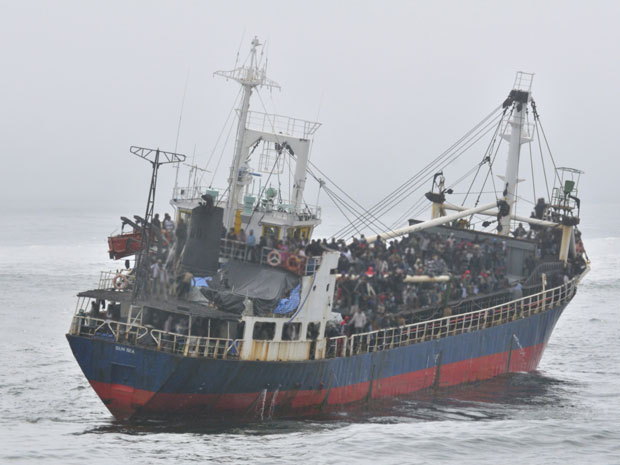
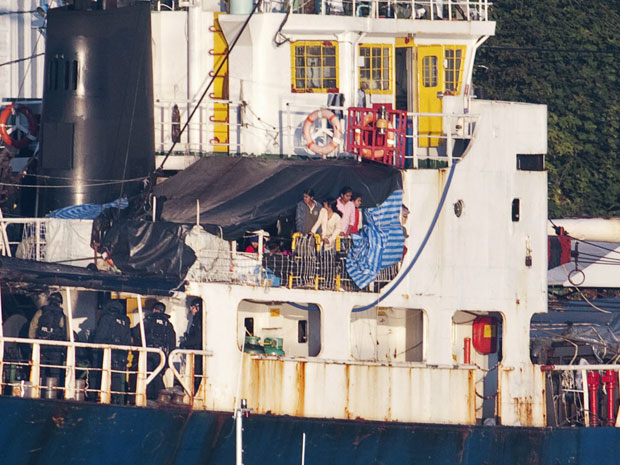
Source: http://www.nationalpost.com/news/Tamil+ship+arrives+base/3394129/story.html
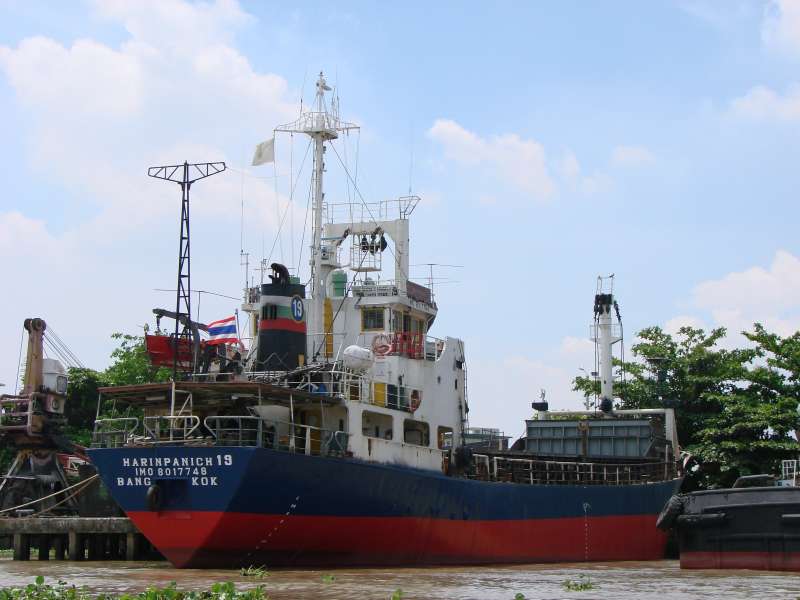
Source: http://www.shipspotting.com/gallery/photo.php?lid=663875#
The key role played by the crew members of Sun Sea ship has been brought forward.
According to the Immigration and Refugee Board Canada, among 492 Tamil immigrants, who entered Canada through MV Sun Sea in Around August 2011, were helped by the 12 crew members of the ship, who played prominent role in the major human smuggling that took place.
As by the Kenny Nicolaou, a representative of Canada Border Services Agency told that Sun Sea operation was involved in about by 45 smuggling agents from different countries including Srilanka, Thailand and Malaysia.
They provided people to be smuggled with the passports, tickets to the Bangkok, they spent around 0ne to five months there in hotels or apartments and finally transported through taxi, buses to the Sun Sea. The people were asked to $5000 before boarding the ship and an additional payment of ranging from $5000 to $30, 000 after reaching the Canada. They Sun Sea played key role to smuggle Tamils to Canada.
The charges were further confirmed on hearing from one of the crew members, who served for various purposes as cooking, manning the diesel engine room etc, said by the Canada board.
When inquired further from the member, he tried to limit his role by telling that he oftenly turn up only for his three or four hours shift and rarely helped in other ways. His lawyer defended him, by saying that on base just being a crew member he can be linked with criminal work or human smuggling people.
The board adjudicator is looking for more proofs to find out the involvement of the crew member. If the fellow is found guilty of being one of the criminal organizations, the migrant could even be deported.
After questioning in presence of his lawyer, the migrant said he turned up to Canada for seeking refugee status and don’t know anything about the ship and smuggling activities going in there.
The Canada Border Services Agency is also looking for the man, whose brother was reported to be on the ship and was the key organizer of the crime and smuggling that has taken place. The work done by him and his other helpers and have generated large sums of money through this illegal activity, further added by Nicolaou.
They are also going for the deportation of 40 migrants who they doubt were the members of banned Liberton Tigers of Tamil Eelam terrorist organization, that is active in smuggling. They also believe without the contributions of the crew members Sun Sea would not have been able to make their way to Canada.
Public Safety Minister Vic Toews described the ship as part of a larger human-smuggling operation.
Border officials expect to spend much of the weekend identifying the 490 asylum-seekers, most of them men from Sri Lanka, who arrived in Esquimalt Harbour yesterday after a three-month journey by cargo ship.
Most were much healthier than originally feared -- eight were taken to Victoria General Hospital, including a six-month-old baby and two pregnant women, but none was seriously ill.
The ship arrived in Esquimalt Harbour about 6 a.m. amid tight security.
Dean Purdy, spokesman for correctional and sheriff services with the B.C. Government and Service Employees' Union, said he was told about 400 adult men, 60 women and 30 children were aboard the 59-metre MV Sun Sea.
The men are expected to be held at Wilkinson Road jail for processing before being moved to the Lower Mainland, likely Fraser Regional Correctional Centre in Maple Ridge.
The women are reportedly being taken to Alouette Correctional Centre for Women, also in Maple Ridge.
Once the mothers and children have been processed by the federal government, they will be released into the care of B.C.'s Ministry of Children and Family Development and kept at a "secure and safe facility," the ministry said yesterday. They will be kept together while going through the federal refugee review process, and receive access to language interpreters and other support services.
Initial efforts to determine the identities of the asylum seekers, as well as any criminal connections or security threats they might pose, are expected to take 48 to 72 hours, said Rob Johnston, regional director for Canada Border Services Agency.
Public Safety Minister Vic Toews told a press conference the ship is part of a larger human-smuggling operation and Canada needs to improve its laws to ensure the country's refugee system "is not hijacked by criminals and terrorists." "I don't view this as an isolated, independent act," he said, responding to a question about whether more migrant ships are coming.
"We believe that there are others who are watching this particular situation to determine the reaction of Canadian authorities," Toews said.
"As I have said before, human smuggling is a despicable crime and any attempted abuses of our nation's generosity for financial gain are utterly unacceptable." Toews refused to provide details, however, saying he did not want to prejudice investigations into individuals who travelled on the Sun Sea.
Observing the Sun Sea's arrival across Esquimalt Lagoon yesterday, Gary Anandasangaree -- legal counsel for the Canadian Tamil Congress -- warned against painting the new arrivals with too broad a brush.
"I don't disagree with the majority of his comments," Anandasangaree said.
"But there is a difference between people smugglers and the people who are seeking refugee status. We can't lump them in together." Human smuggling was one way the Liberation Tigers of Tamil Eelam, or Tamil Tigers, financed their 25-year war with the Sri Lankan government.
The Sun Sea, which was spotted in the Gulf of Thailand in May, had been tracked for weeks by Canadian authorities because of suspicions that it was carrying illegal migrants to Canada.
HMCS Winnipeg and RCMP patrol boats intercepted Sun Sea on Thursday off the west coast of Vancouver Island. The RCMP and the navy boarded the vessel, and naval personnel piloted the vessel through Juan de Fuca Strait during the night. HMCS Whitehorse was also part of the escort.
Tugboats guided the Thai-registered Sun Sea past Fisgard Lighthouse shortly after 6 a.m. yesterday. The pocket freighter docked a half hour later at a Colwood-side wharf, where a crowd of uniformed personnel and a pair of buses waited.
By Ian Shelton, Judith Lavoie and Kim Westad, timescolonist.com August 14, 2010
Thai freighter with 200 migrants on board heading for B.C.
Friday, July 16, 2010 Canadian Press
The Thai Cargo Ship MV Sun Sea is reportedly headed for the West Coast of Canada with 200 migrants on board. Canada is watching out for a ship reported to be carrying illegal Tamil migrants after a Sri Lankan newspaper warned the vessel could be headed for British Columbia.
The Colombo Sunday Observer reported a Thai Cargo ship — the MV Sun Sea — is sailing for Canada with 200 migrants on board, including members of the Tamil Tigers, the military arm of the Tamil separatist movement.
Foreign affairs spokesman Alain Cacchione said the government is aware of reports suggesting the ship has left South East Asian waters and may be headed for Canada.
The Observer said the ship, previously known as the Harin Panich 19, was originally headed for Australia.
The paper said the vessel was last spotted in May in the Gulf of Thailand where its captain, a Tiger leader named Vinod, warned that several illegal migrants would "throw themselves overboard if anyone tried to board his ship."
Last October, a ship carrying 76 Sri Lankan migrants was intercepted in Canadian waters after crossing the Pacific from Sri Lanka.
The group on board the Ocean Lady claimed to be fleeing persecution after the country's bloody 26-year civil war.
But there are concerns that some of the migrants may have links to the Tamil Tigers, which Canada has banned as a terrorist organization.
The Sri Lankan army crushed the Tamil rebellion last May and the Canadian Tamil Congress said the migrants may have embarked on their risky ocean journey because Tamils are still persecuted and it's nearly impossible for them to come to Canada legally.
http://www.leaderpost.com/news/Canada+watching+Thai+ship+suspected+people+smuggling/3286162/story.html
Harin Panich 19 - IMO 8017748, gt 767, built 1980, flag Thailand, owner Harinpanich Co. Ltd Bangkok.
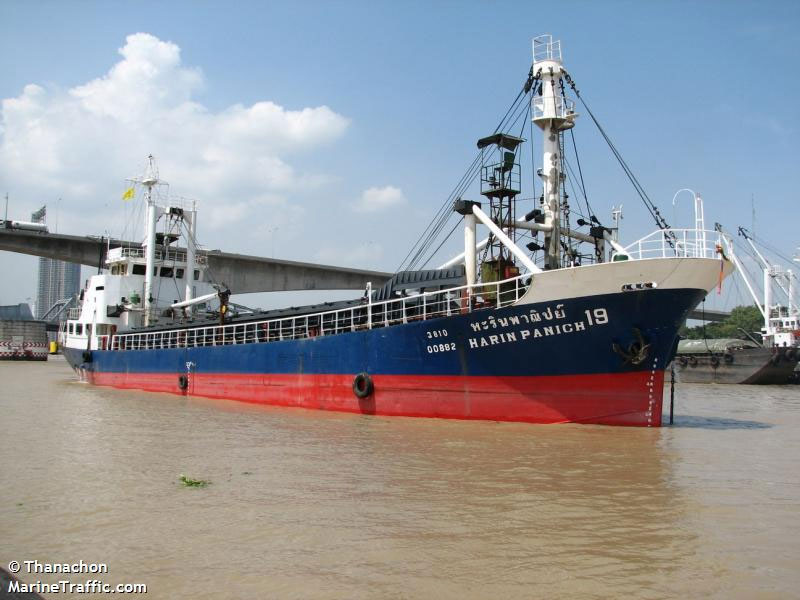
In my heart I wish we could wrap our arms around every single person whose world has crumbled and shelter them from care and share with them the peace and safety we are blessed with here in Canada.
While noble in spirit, I realize my fantasy is not possible in life. The sheer number of the world’s 43 million displaced and struggling innocents is overwhelming. Governments everywhere pool foreign-aid resources, and humanitarian groups feverishly scramble to follow in the wake of natural disasters, wars, and tyrants.
As citizens of Canada, many of us have deep personal ties to people who live outside our country, and our concerns and anxieties can’t help but extend beyond our borders. As compassionate human beings, it’s only natural that we care about what happens to immigrants and refugees when they do come here.
We also want our national security forces to protect unfailingly the peace and freedom we all so highly value. In addition to overseeing this huge country from within, we expect our officials to protect us from foreign criminals and extremists.
It’s a tall order, and a controversial one. Not everyone in Canada embraces immigration, and some even go so far as to say we should close our borders altogether. We pretty much all agree on preventing crime and terrorism, but how it’s done, and how criminals and terrorists are identified as such, also remains controversial.
All these complicated issues came together with the arrival of a small Thai cargo ship called the MV Sun Sea. Crammed in its hold were 490 Tamil men, women and children who had endured a three-and-a-half-month journey across the Pacific Ocean in order to escape persecution in Sri Lanka.
The plight of the Sun Sea illustrates the difficulties faced by those who seek refuge in this manner. It was last April when the small thirty-year-old ship left Sri Lanka. As a suspected people-smuggling vessel, she was spotted by the Philippine Coast Guard as she left the Gulf of Thailand in May. Loaded with her freight of Tamil families, she was approaching Australia when she was turned back by their navy. According to reports, the Sun Sea then changed her course and headed for Canada.
On August 13th, long before daybreak, in a large and varied flotilla, the RCMP and the Navy waited 200 miles from shore to intercept the Sun Sea as she entered Canadian waters. When she was within our jurisdiction, orders were called over to her which were calmly and readily complied with. The Sun Sea was then boarded and secured. Two navy tugs attached to each end of the ship proceeded to guide her towards Vancouver’s harbour.
How anxious the people aboard the vessel must have felt as they waited below deck! After almost four gruelling months at sea, they had finally reached dry land. In the next few hours the strangers they would be meeting would hold the key to their lives and to their children’s lives. Imagine the hopes and fears they all shared that momentous last night together!
Aside from the large police and navy flotilla which filled the harbour, on shore a wide array of people awaited the passengers. Government, military and federal officials, border protection officers, doctors, translators, advocates, the press, - they all stood fixated, staring at the infamous boat as it finally appeared in the early morning light.
Seeing the distinctive blue and red striped cargo ship for the first time, they gasped in dismay. The two tug boats almost equaled the length of the Sun Sea’s. Reporters marvelled that a ship so small, only 59 metres long, and 10 wide, could hold 490 people at high sea for over three months. On deck Canadian officials wore surgical masks for protection against potential health risks. Although most of the Tamil people were still below in the hold, a few curious faces could be seen peeking out from under a tarp, one young man giving people a shy wave.
It was still dawn and the little cargo ship’s blue and red stripes reflected in the placid waters of the natural harbour. Above, the blue sky was bathed in a rosy glow. Towering cliffs covered with lush greenery provided a gorgeous backdrop for the gleaming cluster of white tents installed to process the new arrivals. Ambulances stood by to take those who needed medical attention to a nearby hospital. Police buses were on hand to transport all the others to several local prisons where they would remain while being investigated by the Canadian Border Services Agency. Social workers had arrived to take the children into foster care. Members of the Tamil community from across Canada were flying in to volunteer professional services and material aid.
Slowly, slowly, one at a time, officials gently guided the people off the ship and over the gangplank, holding black umbrellas over them, presumably to shield them from the press. From a distance one could see a woman in a flowing white skirt, and a man carrying belongings in large clear plastic bags; slow moving elderly people and young children clinging to their parents’ hands; a little boy frightened to walk on the gangplank being kindly encouraged by the officer who was leading him. As they crossed that walkway and stepped onto that green shore, one can only imagine their wildly racing thoughts and the pounding of their hearts. Slowly, one by one, they were escorted beyond the trees and beyond the public’s sight.
The Story Behind The Story
I’ve got to stop reading those appalling comments, the ones written in response to articles about the Tamil asylum seekers from Sri Lanka. The dehumanizing insults and fear mongering one can find in these crude and mean-spirited ‘have your say’ forums is shameful. If only they were merely representative of a small group of nasty, uninformed ranters. Sadly, I also read blatantly prejudiced and unsubstantiated statements coming from officials within the Canadian government itself, and to me, that is by far more worrisome.
I’ve always felt tremendous pride in Canada for being a decent law-abiding country. The majority, I believe, still values fairness and compassion and, contrary to what I read in these low-brow forums, it does not take delight in ridiculing other people’s misfortunes. It would be good if we could all resist reducing these desperate souls to mere stereotypes and instead allow due process to take place before passing judgment.
Sri Lanka, from which these families are fleeing, is very vocal in charging that these yet-to-be-identified people are all hardcore terrorists. They had claimed the same about 76 other Tamil refugees who arrived last fall on the Ocean Lady, but none of their accusations stood. Now these same alarmists are again ringing the same bell. In the face of the United Nations, Amnesty International and many other Human Rights organizations, Sri Lanka refuses an independent enquiry into war crimes committed while implementing the gruesome final strategies which brought its 26-year-long civil war to an end.
Their Defence Secretary, the President’s brother, has on Canadian television threatened to hang Sri Lanka’s imprisoned Army Commander for treason should he attempt to testify against the Rajapaksa government. It is their usual procedure to discredit anyone whose testimonies could reflect badly on them, and their diplomatic representatives are the personification of political interference. In Sri Lanka reporters, aid workers, ordinary citizens - those who could cause embarrassment or trouble - have been tortured and ‘disappeared’.
They continue to hound Tamils in their adopted countries everywhere and shamelessly attack anyone they feel has sympathy for them, including international politicians and the heads of humanitarian agencies. Toronto’s Sri Lankan consulate has organized several anti-Tamil events over the last two years alone.
Just what is more threatening: the influence of an aggressive foreign government accused of genocide and a full menu of human rights violations in its civil administration, or a boatful of unfortunates who, along with their precious children, have taken a shot at being accepted as refugees in the only way open to them? Let them get visas the normal way, you say? The trouble with that is that Canada’s visa officers have no access to the North in Sri Lanka and the Tamil people of the shattered North are under tight military control with no freedom of movement.
Last fall when the Ocean Lady arrived off the coast of British Columbia carrying 76 Tamil men, the Canadian government took on an ‘expert witness’, Rohan Gunaratna, to bolster their case against the asylum seekers. Gunaratna bluntly stated that all the claimants were terrorists. This so-called unbiased expert failed to disclose that since 1984 he has worked closely with the Sri Lankan government as an advisor and continues to promote their interests passionately. The 1980s were notorious for Sri Lanka’s horrific state-supported violence against Tamil civilians. In the long run, none of Gunaratna’s unsupported claims against the 76 asylum seekers held up.
Many of Gunaratna’s resume credentials have been disproved. Yet inexplicably he is still advising our government, and for weeks politicians have been promoting his biased point of view in anticipation of this new boat’s landing. Gunaratna still doesn’t name his sources nor offer any evidence to back up his dangerous allegations. Without our knowing who’s on board, these asylum seekers have already been stigmatized as terrorists on the grounds of their ethnicity. Oh, Canada!
Canada’s top security official and the lead minister in the current situation, Public Safety Minister Vic Toews, has been adamant that there are terrorists and human smugglers on board the Sun Sea. He says the Government’s position is that we have to make Canada a less appealing place for smugglers and that we have to send the signal that we don’t tolerate terrorists and criminals.
When people present themselves without having the proper documentation and visas, or have arrived in an ‘irregular’ way, the procedure is for the claimants to be held in custody until cleared of criminal or terrorist association. Two local prisons east of Vancouver were readied for this purpose, the Fraser Regional Correctional Centre and the Alouette Correctional Centre for Women.
The staff at the nearby Victoria General Hospital was prepared to quarantine and treat those suspected of having any communicable diseases. These people had been at sea for over three months in a cramped cargo ship and rumours of raging tuberculosis and deaths were being reported. However, the day after their arrival, when officials had had the opportunity to examine the conditions on the Sun Sea, things appeared to be much better than first feared.
The people, they said, were in remarkably good shape and in good spirits. Only twenty seven of the 490 were sent to the hospital, and all, or almost all of them were soon discharged. One person had died at sea, but no communicable disease was found. Two of the women are pregnant.
The ship itself was mechanically sound, and alterations had been made to accommodate its human cargo. It had been kept clean and organized, and they had a system to deal with waste and garbage. There were a couple of washrooms. Although closely rationed, there had been enough water and food such as rice and dried fish. Tarps had been added to the upper deck to extend living space. Hammocks were hung to provide sleeping space.
The Tamil people were seen smiling and engaged with the officials in a willing cooperative manner. Some women and approximately fifty young children have been placed in the care of British Columbia’s Ministry of Children and Family Development.
From here we can only hope that in spite of the apparent predisposition of our government and its agencies to presume guilt, the rights of these people to due process will be respected. According to international law, those seeking asylum in Canada have the right to a fair hearing on the merits of their individual cases.
The Minister of Immigration, Jason Kenney has issued this statement via his spokeswoman, prior to the ship’s landing: “This could end up being a prime example of individuals trying to take advantage of our generous immigration system. Our government is committed to cracking down on bogus refugees while providing protection to those that truly need our help.” The Harper government holds the position that Canada is being exploited and being turned into a haven for criminals and terrorists. Amongst many others, opposition politicians Michael Ignatieff and Olivia Chow are asking people to resist prejudging and they are emphasizing in interviews that due process must take place and Canadian and humanitarian laws adhered to.
Last May, loaded with her freight of Tamil families, the Sun Sea was approaching Australia when she was turned back towards Christmas Island, a practice which leaves asylum seekers without protection and which the UN High Commission for Refugees regards as jeopardizing fundamental human rights.
Like Canada, Australia has signed on to the Refugee Convention which outlines the rights of refugees and how receiving nations are to treat them. However, Australia pays Indonesia to cut off and hold refugees who attempt to reach her shores and thereby avoids living up to her responsibilities. Last year Australia processed only 120 of the refugees detained by using this unethical loophole. Australia has suspended asylum claims from Afghanistan and Sri Lanka since early April, 2010 by designating these countries as being ‘safe’. Even if they had been unwillingly towed to shore by the Indonesian navy, asylum seekers usually languish in locked refugee camps for decades waiting for a third country to accept them. As a Canadian, I am mortified to hear that there are people here who applaud the ‘Australian solution’ in spite of the disastrous consequences that befall the people who are seeking protection.
The phrase ‘terrorist sympathizer’ is too often used carelessly – or even worse, in a calculated way - by those who, rather than being genuinely concerned with national security, have other motives best served by fear mongering. In anticipation of the arrival of the Sun Sea, some of our officials shamelessly fed the media with inflammatory statements. Is it appropriate to hang the accused before a trial in Canada? That’s not a good trend. Scaring the public, then running to their rescue is an old political trick. Lives are on the line. Politics ought not to be played at the expense of people undoubtedly already traumatized by recent events.
As to what happens now that the asylum seekers are here, immigration lawyer, Lorne Waldman explains that there are definite procedures and steps which will be taken. As mentioned earlier, health issues were immediately addressed. In anticipation of severe health problems, the order had been given to the Victoria General Hospital to prepare as if for a pandemic. They had opened an unused emergency wing and readied it for the possibility of hundreds of horribly sick people. As it turned out, the migrants had been able to take reasonably good care of themselves and had arrived in surprisingly good health.
The Canada Border Services Agency and the Royal Canadian Mounted Police are conducting their investigation looking for the people smugglers responsible for this ship-load of hopeful souls. People smuggling is a very serious offense worldwide, and these individuals, if identified, will face vigorous prosecution.
Each passenger has been photographed, fingerprinted and processed for detention. Their fates will depend on the background checks that the government authorities are conducting. Immigration law requires a Detention Review within 48 hours of apprehension and then a second Review after seven days.
Tracking down missing documents is perhaps the single most helpful thing families and representatives of the asylum seekers can do to help them. Canada Border Services Agency will need to confirm the identities of the passengers to determine whether they pose a security threat. Migrants are under obligation to produce proper identification documents and until they do, they will be held in detention. If the documents cannot be found, procedures for deportation will commence. The Government has the broad rights to hold individuals for four or five months while continuing their investigation. Eventually they must conclude whether or not the person is a security threat. Individuals cannot be held indefinitely.
When Canada Border Services Agency’s investigation is finalized, they must produce evidence if they wish to lay a charge. In this case they are looking for proof of criminal behaviour or of connections to the Liberation Tigers of Tamil Eelam. The LTTE, who fought the Sri Lankan government in a civil war for the better part of the last quarter century were, until last May, in control of the northern part of Sri Lanka, from where the asylum seekers are most likely to originate. Because the LTTE formed the government of Tamil Eelam, does it follow that all Tamil civilians living in their traditional homeland are terrorists?
Provided that individuals have their documentation, and are cleared of any security-related charges, they are then referred to immigration officials who will start to process their refugee claim. If it is determined that a person will not be a flight risk, he or she may be released into the general population, usually with conditions attached.
It may take years to determine whether a claim is accepted, and the possibility of deportation hangs over the applicant’s head all that time. It is unclear when the recent reforms designed to accelerate the processing time of claims will come into effect.
The Expertness Of Experts
On August 6, a few days before the Sun Sea’s arrival, the Canadian Tamil Congress organized a forum at beautiful Hart House in downtown Toronto to address concerns about this group of people and about Canada’s role in offering protection to refugees in general.
The first up to speak was John Argue, the Sri Lanka Coordinator for Amnesty International Canada. Amnesty, he said, continues to express concern about those aboard the Sun Sea. Asylum seekers who reach Canada using any form of transportation have the right to a case-by-case hearing, and Amnesty International Canada and the Canadian Council for Refugees had sent a joint letter to Prime Minister Stephen Harper. At the time, a rumour that the ship would be prevented from reaching Canada by our navy not only involved breaking international law but also the condemning of its passengers to a tragic fate. In their letter, hope was expressed to the Prime Minister that the rumours were untrue and that Canada intends to follow due process and provide for fair refugee hearings.
‘Expert witness’ opinions aside, the continuing lack of safety for Tamils in Sri Lanka is a far more compelling argument than the unsubstantiated warnings of their constituting a national threat to Canada. Last May Amnesty International, amongst others, requested an independent inquiry into war crime allegations to examine the activities of both sides of the conflict. The Tamils supported the inquiry; the Sri Lankan government refused.
United Nations Secretary-General, Ban Ki-moon has appointed advisors to continue to brief him about the ongoing situation. As it stands, Mr. Argue continued, Tamils don’t have a chance to be citizens in their own land. In Sri Lanka human rights activists, journalists, opposition politicians, anyone, really, can’t express frank opinions under threat of torture and death.
Sri Lanka’s Defence Secretary, Gotabaya Rajapaksa says that asylum seekers are involved with human smuggling and that their claim of being refugees allows terrorists to disguise themselves as civilians. This idea tries to take away credibility from all Tamil people as a group.
Victor Wong, the Executive Director of the Chinese Canadian National Council, which is a member of the Canadian Council for Refugees, warned about the attitudes which lead to criminalizing and stigmatizing people and detaining them for prolonged periods of time. This is a process which in turn prejudices their refugee claim, leading to deportation back to the very danger they risked their lives to escape. If the people on board the Sun Sea are maltreated as a group, it is conceivable that more groups of people will be marked by decisions driven by political objectives.
The current government’s recent changes to refugee law call for countries to be divided into two categories: countries that are safe and those that are not. The determination of who falls on which side of the fence appears to be a political decision, rather than one guided by the experience of human rights groups. Those who come from ‘safe’ countries, as Sri Lanka is asserting itself to be, will not be given the same opportunities to defend their case as those who come from countries on the ‘unsafe’ list.
Mr. Wong explained that those agencies which focus on helping refugees need to anticipate media buzz and its dramatic need for a ‘bad guy’ and to try to counter the negative profiling by insisting on rational investigation and due process. When the Ocean Lady’s passengers were detained in British Columbia last year, they were provided with legal council, interpreters, and for those without Canadian relatives, host families by the Canadian Tamil community and by non-governmental organizations. It would be advisable to be prepared to repeat these forms of help to the new arrivals. Mr. Wong spoke of past situations where people were turned away with tragic consequences, and urged everyone to work towards the proper and fair treatment of all immigrant groups.
John Cartwright, President of the Toronto & York Region Labour Council, and Chairperson of the coalition of human rights groups forming ‘Canadians Concerned About Sri Lanka’, urged that we get involved with building the kind of Canada we want to share together. Canada has a mixed history in dealing with immigrants and we need to hold it to high standards. Allowing Sri Lanka to whip up hysteria about the asylum seekers is unacceptable, and a fair hearing is critical for a just society. In order to overcome the shame of past injustices, certain standards must be met, and no asylum seeker can be branded as a terrorist in lieu of a just hearing.
Liberal Member of Parliament Rob Oliphant hoped that the information shared at the forum would better equip everyone in reaching the desired goal: that the proper process of refugee determination be extended to everyone. To spontaneous applause Mr. Oliphant said our Government should exercise discretion in accepting the ‘expertness of experts’. It is unseemly that Canada should advance the propaganda of a state almost universally accused of crimes against humanity.
Michael Ignatieff, the leader of the federal Liberal party, has said that he frankly wished there be a moratorium on the ‘T’ word as it’s so often used to bias Canadians purposely. Mr. Oliphant reiterated the need for the Canadian public to rally against propaganda. He encouraged lawyers and human rights groups to continue to educate the media and the public by presenting factual information rather than rhetoric. The refugee determination process, he said, is definitely worth the money and effort.
Hadyat Nazami is a Human Rights lawyer currently representing several of the refugees who arrived last October on the Ocean Lady. He thanked the hosting organization of the forum, the Canadian Tamil Congress, for the support the community provided for the asylum seekers. They had provided advice, legal council, therapy, translators and phone cards. Mr. Nazami went on to say that the recent statements made by the Harper Government made the support of the Opposition parties essential to maintain a balanced handling of the situation.
Our government’s ‘unbiased’ expert witness is sworn to advance Sri Lanka’s interests, not Canada’s. Rohan Gunaratna and his fellow agents publicly pressured our government to confront the ship before it reached our waters. That’s internationally illegal. In the past when Canada turned ships filled with refugees around, the people died. Recently Prime Minister Harper extended formal apologies for several such occurrences.
Mr. Nazami deplored the use of the terms ‘bogus refugees’ and ‘queue-jumping’, saying they painted false impressions of how immigration law works. There’s nothing unusual about refugees coming to Canada. There’s nothing unusual about having to check people for security reasons. But political interference can be hurtful and illegal. Although legal caution is understandable, during the Ocean Lady case, laws were broken and people were stigmatized.
Compassion was sadly absent in a haunting memory he shared of a traumatized Tamil man from the Ocean Lady, found crying in his solitary cell as he waited to hear of his fate. The charges against him and others like him were based on the opinions of Rohan Gunaratna and the Sri Lankan Army. Months later, when Canada Border Services Agency was pressed by Immigration Canada to produce evidence, all of the charges were dropped - in spite of earlier claims that they were in possession of ‘secret evidence’.
Gunaratna has been allowed to enter Sri Lankan prisons – a highly unusual ‘privilege’– to interrogate prisoners about the Tamil Tigers. He needed the use of translators as this ‘expert on Tamils’ cannot speak their language. Although he claims they answered his questions readily, it has been revealed that prior to his interrogation these forlorn people had been subjected to torture. This is a common practice, resulting in approximately 80% of Sri Lankan prisoners being tortured. The ‘Canadian Centre for Victims of Torture’ has observed that because of fear or trauma, such victims, in interviews often hide the fact long after they have left the offending country - which in turn jeopardizes their claim. Mr. Nazami emphasized that the Canadian government must take care to avoid becoming complicit in torture.
A second Human Rights lawyer, Robert Blanshay, was next to speak. His opening comments were about his colleague, Nadyat Nazami, who had just addressed the room. Mr. Nazami, he said, is representing several asylum seekers from the Ocean Lady, which arrived last fall. He was given ten minutes of preparation time to cross-examine Rohan Gunaratna, the ‘expert witness of choice’ of the Canadian Government. In this short period of time, Mr. Nazami was able to uncover substantial misrepresentation on Gunaratna’s part. He had failed to disclose that he had been closely linked with the government of Sri Lanka since the 1980s, and still is.
Responding to the discovery, Gunaratna claimed that this revelation was just a simple oversight, that he’d simply forgotten to mention it!! Our government did not react to this incredible conflict of interest. Did anyone think that such forbearance would be extended to any Tamil person, Mr. Blanshay asked. With further investigation, many of the credentials on Gunaratna’s resume turned out to be completely fabricated and he has been discredited internationally. But he’s still our ‘expert witness’!
As people are arriving all the time to seek asylum in Canada, the question of how we treat refugees should be focused not only on the Tamil arrivals. In fact, Canada has reduced the number of refugees over the last few years at a time when the world is full of people needing help. Third world countries take in far more refugees than do Western nations. The game amongst Western countries seems to be how to avoid living up to international standards and conventions by making it increasingly difficult for would-be refugees to qualify.
Far from being an exercise in charity, immigration has always been necessary to Canada and is closely linked to employment needs and foreign trade and policy. Most refugees, the majority being women and children, though having gone through great upheaval and personal loss, never do leave their countries, and are known as Internally Displaced Persons. IDPs as such are not counted as Refugees. The world’s Refugee statistics do not show these people in their tally. The comparative few that do arrive in Canada represent a tiny proportion of the quarter million immigrants we process each year.
Mr. Blanshay spoke of ‘Risk Assessments’ which examine what the country of origin is like in regards to the safety of the would-be refugees should they be sent back. For many reasons, including monetary ones involving major international loans and grants, Sri Lanka cannot afford to be seen as a state which does not live up to its Human Rights requirements. It will do anything it can to discredit any allegations against its record.
To this day President Rajapaksa maintains that there are no minorities in Sri Lanka and that no civilians were killed in the final months of the civil war, that his army was on a rescue mission. The remnants of these ‘rescued’ Tamil people were locked up in appallingly inadequate prison camps. From babies to elders, the survivors were starving and severely wounded from Sri Lankan scatter bombing and heavy weaponry being fired into civilian ‘safety zones’ and hospitals. Minimal medical help was permitted, and international aid and journalistic communities were banished. In spite of their efforts, Sri Lanka could not block the harrowing stories from leaking out of the camps, and these stories subsequently were heard around the world.
It comes down to this: people must educate themselves in order to avoid falling prey to biased political strategies and to hold our elected officials accountable for how they manage situations such as this. Mr. Blanshay expressed grave concern that the Canadian government was still receiving advice from Gunaratna.
Mr. Wong added that what happened last year with the Ocean Lady is actually a good case study on how the process works. The government had put security certificates on about 25 of the 76 migrants. Since the evidence presented by Rohan Gunaratna was unusable, they had to withdraw these certificates. Rule of law resulted in all 76 people being cleared of terrorist charges and allowed them to live amongst the general public while their claims were being processed.
Mr. Wong expressed gratitude to those who didn’t just ignore the Ocean Lady case. “What will happen to the next group of migrants if what happens to this group is ignored?”, he asked. If false assumptions and rhetoric are not challenged, it becomes progressively more difficult for those who follow.
Absolutely no one is suggesting that national security be compromised - quite the contrary. The integrity of our security and emergency alertness is crucial. Last year alone, Canada processed 34,000 refugee claims, and our government needs to prevent violent individuals and organizations from exploiting Canada. The concern here involves the ethical application of existing laws, the quality of the intelligence being used by our government, and the perception that decision-makers are being unduly influenced by foreign entities whose agendas are anathema to the kind of nation we pride ourselves on being.
None of us knows what the future will bring. We all do our best to comprehend this confusing world of ours, and sometimes it seems we are worlds apart in our views and conclusions. We just have to keep trying to be decent people and to mix compassion with caution. I think of those Tamil hopefuls, far away from their families and friends, waiting to see what their future will be. I pray it will be a good and secure one – for all of us.
地方の港と同じ。適切に教育された職員がいない。上司が知識や実地の経験に乏しく部下を指導できない。犯罪が少ない地方にいた職員は 形だけのチェックだけなので本当に該当者を見つけようとする意識が少ない。平和ボケで高齢の職員の意識改革が難しい。摘発されたケースは 氷山の一角だと思える。
覚醒剤密輸ルートが地方の空港に及んでいる。昨年から今年にかけ、五つの空港で初の摘発が相次いだ。捜査関係者らは密輸組織が警備が厳重な国際空港を避け、国際線の乗り入れが増えた地方の空港に目をつけたとみて、警戒を強めている。
4月24日午前、富山空港の税関検査場で、税関職員はある男性乗客の不審な行動にピンと来た。持っているのは小さな荷物だけ。他にないのかと確認すると、ターンテーブルに別の荷物を取りに戻った。職員にパスポートを渡すと、受け取らずに立ち去ろうとした。一刻も早く検査を終えたいように見えた。
職員が別室へ案内すると、男性は「何も持っていない」とアピールするようにズボンを脱いだ。職員が「上着も」と促すと、二つの白いポリ袋が粘着テープで腹に巻き付けられていた。中身は約490グラムの覚醒剤だった。
台湾からのツアー客を乗せたチャーター便で到着した無職の台湾人の男(66)。大阪税関伏木税関支署は身柄を拘束し、富山県警が一緒にいた女性とともに覚醒剤取締法違反(営利目的密輸)容疑で逮捕した。富山空港での初の覚醒剤密輸事件摘発となった。
大阪税関によると、男は「団体の中でカップルを装っていれば大丈夫と組織に言われた」と供述したという。男の弁護側は「単なる運び屋で密輸組織の末端に過ぎない」と主張したが、判決は「2度来日して下見するなど、密輸を成功させるため積極的に行動している」と指摘。女性は不起訴処分となったが、男は懲役7年罰金300万円の判決を受け、確定した。
富山空港には中国や韓国と結ぶ国際線が週20回程度発着している。同税関支署から職員数人が常駐している。
財務省関税局によると、成田、中部、関西、福岡の4空港をのぞき、国際線が乗り入れている空港での覚醒剤密輸事件は、統計を取り始めた1991年以降、2000年に那覇空港で初摘発された。04、05、07、08年に新千歳空港などで1件ずつだったが、09年は計5件に。このうち小松(石川県)、福島の2空港では初の摘発だった。
今年は岡山空港で7月、末端価格約2億7千万円相当の約2.9キロの覚醒剤を密輸したとして、米国人の男(32)が逮捕された。起訴状によると、男はガーナの空港から覚醒剤を隠したスーツケースを持ち込み、アラブ首長国連邦のドバイ、韓国・仁川空港経由で入国したとされる。
9月には広島空港で約2.2キロの覚醒剤を密輸したとしてドイツ人の男(48)が逮捕された。この2件と富山を合わせ、今年は地方の空港で計5件が摘発されている。
大阪税関調査部によると、地方の空港で昨年から今年に摘発されたのは計10件。いずれも旅行客を装う手口で、うち4件はツアー客に紛れ込んでいたという。
◇
地方で摘発が増えた背景には、地方に乗り入れる国際線の増加がある。国土交通省国際航空課によると、地方にある全国24空港の国際線の定期便の「冬ダイヤ」(10月下旬~3月下旬)の発着回数は2005年度の週684回から、10年度は週952回へと4割近く増える予定だ。
数字を押し上げているのは仁川空港や中国・北京空港などアジアの拠点空港からの増便。特に07年以降、韓国など10の国・地域と日本との間で結ばれた「オープンスカイ協定」により、航空会社が路線の新設や増便を自由に決められるようになった。
一方、税関の職員数には差がある。例年摘発件数が全国最多の成田空港では、500人以上の税関職員が常駐。しかし地方の場合、常駐は4~5人という空港もある。
税関関係者は「取り締まりの厳しい大空港を避けて、摘発件数と税関職員が少ない地方を手薄と考えたのではないか」と分析する。とはいえ、地方は便数が少ないため、時間をかけて検査できるともいえる。「ベテランを配置して取り締まることもある」
覚醒剤密輸の摘発件数全体も増えている。財務省関税局によると、空路と海路を合わせた摘発は05年は33件(押収量約88キロ)だったが、09年は過去最多の164件(同約330キロ)と約5倍に。このうち約7割が空路だった。同局は「大量の覚醒剤を船などで密輸するのはリスクがあり、旅行客を装った『運び屋』を使って空路で密輸するケースが増えているのではないか」とみて、警戒を強めている。(滝沢卓)
あるロシア人と話した事があるが「知らない」と言うかもしれないがほぼ黒らしい。
法廷通訳についてBSN新潟放送の記者の方が事業創造大学院大学へ取材に来られました。新潟日報、テレビ新潟、UX新潟テレビ21に次いで取材は4回目です。
公訴事実は被告人のロシア人船員が3人で共謀し、営利目的で覚せい剤を輸入しようと企て、ウラジオストック港から、カンボジア船籍の貨物船に覚せい剤を携帯して乗船し、新潟県聖籠町東港中央埠頭で上陸して陸揚げし、覚せい剤を輸入したということで、覚せい剤取締法違反、関税法違反による裁判です。
争点は「塊が覚せい剤を含む違法薬物であると被告人が知っていたか否か」とのことです。
私は10年ほど前に、5年間ほど法廷通訳をやっていたことがあります。
そこで一番問題だなあと感じていたことは、取調べ段階の調書です。
調書は日本語で作成され、それを取り調べ段階の通訳人が読み上げて、被告人はそれを聞いて署名します。これが、ロシア語に翻訳されて、被告人がそれを読んで署名する分には問題ないと思いますが、ただ通訳人が読み上げるだけでは、微妙なニュアンスの違いや、被告人の聞き落としなど十分にありえることです。また、基本的に、判決は調書に依拠して出されますので、取調べ段階の調書への署名はとても大きな意味があります。
たとえば、アジアなど知らない外国へ行ったときに、自分の気づかないうちに、覚せい剤を荷物に入れられて、警察に拘束されたとします。通訳人を介して取調べを受け、理解できない言葉で調書が作成されます。それを読み上げられて、署名をさせられます。微妙なニュアンスの違いで、実際は本当に何の関わりもなかったのに、裁判では、調書に署名しただろうということで、有罪になって、本国に帰国できないことがありえるわけです。そういう意味では怖いです。
一方、日本国政府にしてみれば、調書を全部、外国語に翻訳していたのでは、経費がかかって大変です。
さて、裁判員裁判になってからは調書に基づいて判決が出されるのではなく、あくまでも法廷での証言に基づいて判決が出されるようですが、何がどう変わっていくのでしょうか?
法廷通訳人はものすごく緊張しますし、精神的なプレッシャーも加わり、3時間でも大変なのに、3月18日の初公判は丸一日やるようですので、負担が増すことは間違いないと思います。
BSN新潟放送のオンエアーは3月3日夕方のニュースとのことです。
個人的な経験だが東北の方は、チェックが甘いときがある。こんな事があっても不思議でない。
盗難トラックを不正に輸出したとして、関税法違反の罪に問われたロシア国籍の新発田市上館、中古車買い付け業、ブルラーカ・ビークトル被告(54)の判決公判が28日、新潟地裁であり、宮部良奈裁判官は懲役1年6月、執行猶予3年(求刑・懲役1年6月)の判決を言い渡した。
ブルラーカ被告は「税関から輸出許可をもらっていないとは知らなかった」と起訴内容を否認し、無許可輸出を認識していたかどうかが争点となっていた。宮部裁判官は「被告は以前日本に滞在し、買い付けた中古車をロシアに輸出した経験があり、輸出手続きを理解していたと推測できる」として、被告の主張を退けた。
判決などによると、ブルラーカ被告は09年3月、輸出許可車両とすり替えた盗難トラック2台を新潟西港の保税蔵置場に運び、ロシアに輸出した。【川畑さおり】
新潟県の新潟東港近くの路上で覚せい剤約5キロ(末端価格約3億円相当)を所持していたとして、新潟海上保安部などがロシア人の男2人を覚せい剤取締法違反(所持)容疑で逮捕していたことが3日、捜査関係者の話で分かった。
同保安部などは所持していた量から、2人が営利目的で密輸した可能性があるとみて、同法違反の営利目的輸入での立件に向け最終調整している。営利目的輸入で起訴されれば、県内で初めての裁判員裁判対象事件となる可能性が高い。
捜査関係者によると、ロシア人の男2人は7月中旬、新潟東港近くの路上で段ボールに入った覚せい剤約5キロを所持していた疑い。2人は張り込んでいた同保安部の捜査員に職務質問され、現行犯逮捕された。密輸された覚せい剤を受け渡す途中だった可能性もあるが、2人は「その場にいただけだ」「覚せい剤とは知らなかった」などと容疑を否認しているという。
2人のうち、「渡し役」とみられる男は、ロシアを出港して新潟東港に着いた貨物船の乗組員として日本に上陸し、もう一人の「受け取り役」とみられる男は国内で中古車業者として働いているという。ロシアからの貨物船が覚せい剤密輸に利用された可能性が浮上している。
今回の事件で押収された覚せい剤5キロは、県内での押収量としては過去最多とみられる。
弾道ミサイルの発射台などに転用できる大型タンクローリーを北朝鮮に輸出しようとしていたとして、兵庫県警は19日、京都府舞鶴市内の貿易会社社長で、韓国籍の鄭麟(チョンリン)チェ容疑者(50)を外国為替及び外国貿易法違反(無許可輸出)容疑で逮捕した。(チェは「爪」の下に「木」)
輸出先になっていた北朝鮮の貿易会社は、経済産業省に「核兵器などの開発に関与している恐れがある外国企業」と認定されている。
発表によると、鄭容疑者は2008年1月28日、大量破壊兵器などに転用可能な製品の輸出を禁じる「キャッチオール規制」対象の大型タンクローリー(最大積載量約12トン)2台を、経産相の許可を受けないまま、韓国経由で北朝鮮の貿易会社に輸出しようとした疑い。調べに対し、鄭容疑者は「納得いかない」などと否認しているという。
参考までに 香港籍船の登録についてのHPを参考にしてください。(英語)
今月7日、高知県室戸市の漁港で大量の覚せい剤が見つかった事件で、逮捕された中国人の男3人は「去年の暮れに来日し、今月6日に高知に来た」と供述していることがわかりました。警察は、男たちが船で密輸した覚せい剤を港で受け取る役目だったとみて、背後関係などについて捜査を進めることにしています。
この事件は、今月7日夜、高知県室戸市の椎名漁港の堤防に置かれていたバッグから、覚せい剤のようなものおよそ120キロが見つかり、このうち30キロについては覚せい剤と確認されたもので、警察は漁港から立ち去るのを目撃された中国人の男3人を、8日、覚せい剤取締法違反の疑いで逮捕しました。警察のこれまでの調べによりますと、3人は去年の暮れに来日しており、「大阪でレンタカーを借りて今月6日に高知に来た」と供述していることがわかりました。また3人は、室戸市内の地図を持っていたということで、警察は男たちが船で密輸した大量の覚せい剤を港で受け取る役目だったとみて、背後関係などについて捜査を進めることにしています。一方、高知海上保安部は、7日、室戸岬沖を航行していた香港船籍の漁船が覚せい剤を港の近くまで運んだ疑いがあるとみて、9日、この船を高知港にえい航し、停船命令に従わなかったとして逮捕した中国人の乗組員6人を詳しく調べることにしています。
さようなら、覚せい剤運搬船!
2010年8月23日の早朝、覚せい剤運搬船として使われたシエラレオネ船籍の貨物船UNIVERSAL(1195トン)が2隻にタグボートに引っ張られ どこかへ移動していた。8月2日には門司港のある岸壁で船名が「CHIWAN 8」と書き換えられていた。
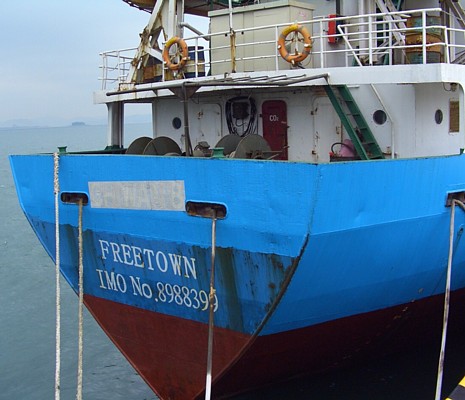 |
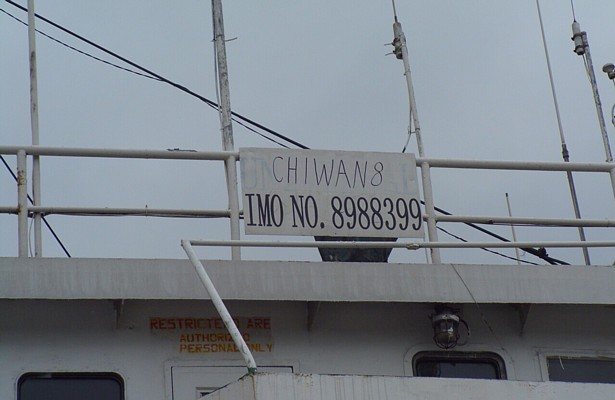 |
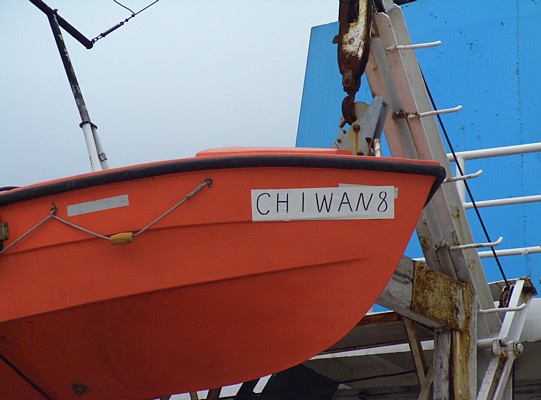 |
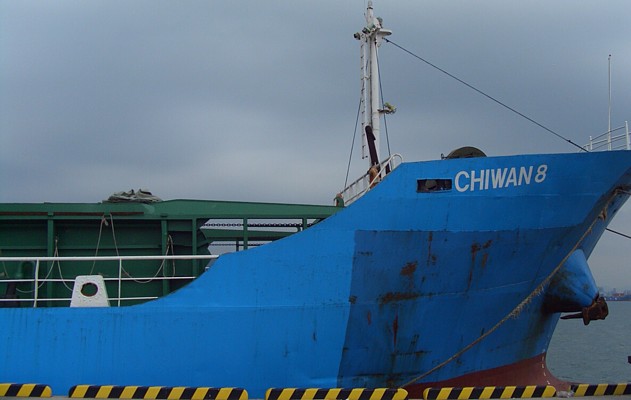 |

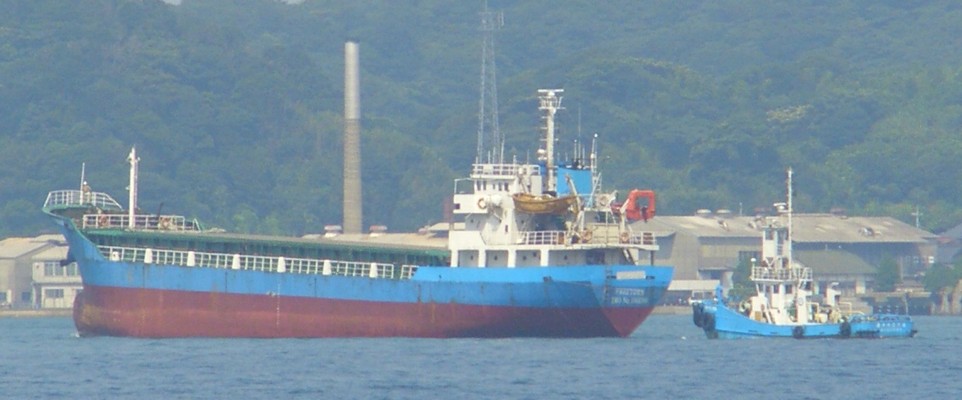
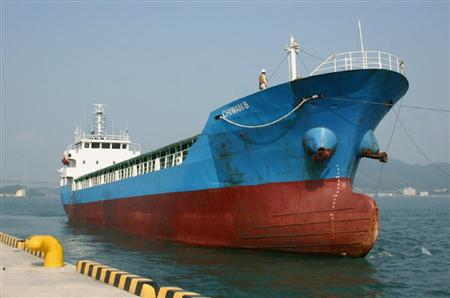
約1年9カ月ぶりに門司港を出発する貨物船の旧「ユニバーサル」=23日午前、北九州市
平成20年11月に約299キロの覚醒(かくせい)剤を密輸したとして乗組員らが逮捕された後、北九州市の門司港に放置されていたシエラレオネ籍の貨物船が熊本県上天草市でスクラップにされることが決まり、23日、事件から約1年9カ月ぶりに同港を出発した。
港を管理する北九州市によると、貨物船は旧「ユニバーサル」(859トン)。インドネシア人乗組員らが福岡県警などの合同捜査本部に逮捕され、港に係留されたままになっていた。
市は船舶代理店を通じて中国の船主側に早期の出港を要請。今年4月に神戸市の貿易会社が同船を購入し、中国での売却を計画したが、修理に予想以上の費用がかかることが判明。最終的に広島市の船舶会社に転売されスクラップが決まった。
北九州市によると、元の中国の船主側は約580万円の岸壁使用料を滞納しているが、一部は支払われる見通し。
全ての港ではないが、岡山の港、博多港、そして苅田港の特定の岸壁は港湾局が保安の規則により承認しているがチェックや警備が甘い。
姫路港、神戸港、福山港や尾道港の特定の岸壁のチェックや警備が甘い。そう言えば、鹿児島のある港も甘かった。日本は比較的に、
チェックが甘いと言うことだろう。
博多港で覚せい剤密輸があったのならスクラップを積みにくる船が一番怪しそうだ!まあ、スクラップを頻繁に積む船にターゲットを絞れば
結構、通報なしでも覚せい剤を見つけられるかも??
昨年11月に北九州市の門司港で貨物船から覚せい剤約300キロが押収された事件で、受け取り役を務めたとして覚せい剤取締法違反(営利目的密輸入)などに問われた中国在住の会社役員嶋田徳龍被告(41)の初公判が24日、福岡地裁であった。
嶋田被告は起訴事実をほぼ認めた。検察側は冒頭陳述で国際的な密輸組織の存在を指摘し、嶋田被告が2005年にも福岡市の博多港で、密輸された覚せい剤約300キロを受け取ったなどと主張した。
起訴状によると、嶋田被告はインドネシア人乗組員12人と共謀し、昨年10月、香港沖で覚せい剤約300キロを貨物船に積み込み、同11月に門司港から陸揚げしたとされる。また、07年12月には、乗組員のうち3人と共謀して覚せい剤約500キロを福岡県苅田町の苅田港に密輸したとして、麻薬特例法違反(規制薬物としての輸入)にも問われている。
検察側は冒頭陳述で、密輸入について「香港を拠点とする国際的組織の犯行」と指摘。組織の幹部は国籍不明の外国人とシンガポール人、インドネシア人の3人で、配下に東南アジアでの密造役、日本への運搬役、受け取り役などがいたとした。日本国籍を取得した嶋田被告は、中国と日本を行き来しながら受け取り役を務めたと主張。密輸1件当たりの報酬は、数百万円と述べた。
検察側は、組織は04年以降、少なくとも4回以上、1回当たり200~500キロの覚せい剤の密輸に成功したと説明。嶋田被告は05年10月に博多港で300キロを受け取ったほか、07年にも貨物船の入港にあわせて岡山や千葉の港に姿を見せていたという。
この「UNIVERSAL」を検査した検査会社と連絡を取ったのか?もう遅いが、ISMコード及びISPSコードで要求される証書を発給する
過程で、担当者や24時間連絡が取れる電話番号を記入しているはずだ。中国の警察に連絡を取れば、関係者が逃亡したとしても誰が携帯電話を
契約したのか、支払い者や口座番号などを調べてもらえるのではないか??
PSC(外国船舶監督官)
と海上保安庁は今回の事件を教訓にもっと訪船した時に、責任者等の連絡者の情報は最新の情報になっている等チェックするべきだ。
日本の規則で外国船が入港する場合、24時間前に報告する時にDPやCSOの名前と連絡先を英語訳も付けて報告するようの改正するべきだ。
日本は少し甘すぎる。一年間に外国船が12隻以上接岸しない岸壁はISPSコードを満足する事を要求していない。税関は開港か不開港だけしか
重要視しない。しかし、このような岸壁に外国船が接岸するときに外国人達がまわりにいると、「もしかして」と思ってしまう。
考えすぎかもしれない。しかし、ISPSコードを満足していない岸壁に外国船が接岸している時は、他の岸壁とは違うのだ。様子を伺っている
のか、機会を狙っている感じがするのだ。まあ、税関、海上保安庁と警察の仕事だから、何とも言えないけど???
昨年11月、北九州市の門司港で覚せい剤約300キロが押収された事件で密輸に使われた大型の貨物船「UNIVERSAL」(シエラレオネ船籍、1195トン)が、同港の岸壁に1年以上放置されたままになっている。覚せい剤の取引に関与した疑いがあるとみられている船主は所在不明で、港を管理する市港湾空港局は「前例のない事態」と困惑している。
同船は中国を出発して08年11月10日、門司港の田野浦岸壁に入港した。翌11日に福岡県警と第7管区海上保安本部などの合同捜査本部が船内を捜索。覚せい剤を押収するとともに、インドネシア人船員全12人と受け取り側の日本人2人を逮捕した。
船員らの供述から、中国・香港にいた船主にも密輸に関与した疑いが浮上。合同捜査本部は事情聴取も検討したが、行方がつかめなかった。このため船主に対する捜査は行き詰まり、貨物船は岸壁に係留されたままになっている。
市によると、岸壁使用料は1日1万1500円。昨年11月18日分から未払いが続いており、滞納額は420万円を超えた。市は船の入港手続きを取り扱った海運代理店に請求しようとしたが、代理店には法的な支払い義務がないため断念した。差し押さえて転売しても、船としての価値はゼロに近く、全額回収の見込みはないという。
市港湾空港局は「係留ロープが朽ちて切れそうだったので、危険を避けるため市費で替えた。本来、そんなことする義務もない」と話す。
同局によると、今年9月には船主の関係者とみられる人物から「船を船主から買い取ってスクラップとして転売したい」と申し出があった。「その売買を機に滞納金の一部でも穴埋めできれば」とも考えているが、その人物と船主の関係も正確に把握できない上、「採算が合わない場合は引き取りをやめたい」という条件もついているという。
風雨にさらされた船体はさび始めており、このままでは自力航行はできないとみられる。船として出航するには海上人命安全(SOLAS)条約に基づく検査が必要で、修理費などが必要になる可能性がある。「鉄くず」とみなして引航していく場合も相当の費用がかかる。日本国内で鉄くずとして処理する場合は「輸入」となり、関税がかかる可能性があるという。
市港湾空港局は「岸壁使用料の滞納よりも、岸壁が占拠されて使えないことの方が問題だ。法的な面を関係機関と協議中で、今年度中に解決策を示したい」と話している。(大畑滋生)
外交が得意な日本の外務省または国土交通省に問題を解決できるように依頼すればよいだろう。
まあ、逃げるのが好きな外務省職員もいるから、北九州市港湾空港局のために情報を提供しよう。
シエラレオネ船籍の貨物船UNIVERSALは下記の会社で登録されているはずだ。
Sierra Leone International Ship Registry
本部、中国及び韓国の連絡先は下記のとおりだ。
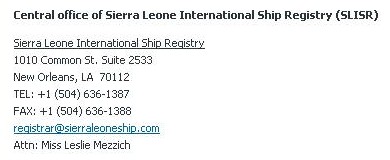
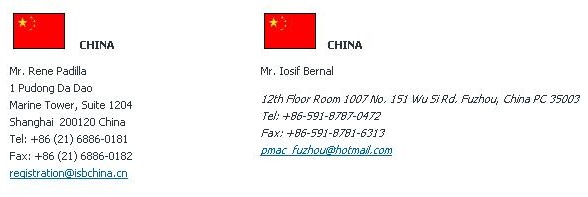

国土交通省と福岡県警は上記に連絡を取るべきだろう。「船舶の登録は適切に登録をされたのか? 船主の連絡先等などはどのようになっているのか?今回の件で登録した旗国としてどのように対応するのか?」 等の質問をするべきだろう。そして対応次第では国連やIMOの会議で問題点として議題にあげるべきだ。 このHPを見ればわかると思うが、問題が起きる前から問題を認識し適切な対応を行っていないからこのようになるのだ。 日本はISPSコードのチェックが甘い! 外国船舶がISSCを持っているかチェックするだけで、船舶がISPSコードを満足しているのか、 日本の港湾がISPSコードを満足しているのか等のチェックが甘い。今回の事件から多くを学ぶべきだ。
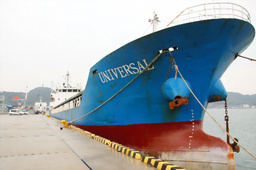 扱いの決まっていない密輸船。奥に小さく見える船が、新たに着いた貨物船=9日、北九州市門司区
扱いの決まっていない密輸船。奥に小さく見える船が、新たに着いた貨物船=9日、北九州市門司区
北九州市の門司港に覚せい剤約300キロが密輸された事件から1カ月。岸壁に残された密輸船の扱いが宙に浮いている。福岡県警や第7管区海上保安本部など合同捜査本部の調べでは、船を引き取るべき船主らが中国マフィアの関係者とみられることが判明。船主は行方をくらまして連絡が取れない状態が続いており、関係者は苦り切っている。
問題の船は、シエラレオネ船籍の貨物船UNIVERSAL(1195トン)。11月10日、肥料に使うリン鉱石を積んで中国から門司港の田野浦6号岸壁に入港。翌11日に捜査当局が船内を捜索し、大量の覚せい剤を押収。インドネシア人船員全12人と、受け取り側とみられる日本人2人を覚せい剤取締法違反容疑で逮捕した。その後、船員12人と日本人1人が起訴された。
積み荷のリン鉱石は11月下旬、付近の化学工場に引き渡された。しかし、船自体はそのまま放置され、岸壁を長期間占拠していた。
同じ岸壁に次の船が来る今月9日を前に、北九州市港湾空港局や海運代理店などが協議。8日午前、代理店側がタグボートなどを用意し、約200メートル離れた8号岸壁に船を移動させた。代理店の担当者は「岸壁の使用料は1日約1万円。移動にかかる費用なども本来はうちの負担ではないのに」と困惑気味。港湾空港局によると、11月分の岸壁使用料は、12月下旬に代理店側に請求する予定という。
今のところ、8号岸壁が利用できるのは来年1月5日まで。港湾空港局の担当者は「責任のある船主がいない以上、誰かに負担を押しつけるわけにも行かず、妙案は浮かんでこない」と話す。(大畑滋生)
北九州市の門司港に入港したアフリカ・シエラレオネ船籍の貨物船から約300キロ(末端価格約200億~300億円)の覚せい剤が見つかり、第7管区海上保安本部(北九州市)や福岡県警などが11日までに覚せい剤を押収するとともに、乗組員のインドネシア人ら12人を覚せい剤取締法違反(所持)容疑で逮捕していたことがわかった。
県警などは、暴力団が組織的に大量の覚せい剤を密輸しようとしたとみて、密売ルートの解明を進める。
捜査関係者によると、貨物船は「UNIVERSAL(ユニバーサル)」(859トン)。10日朝に中国から門司港に入港した。県警などが船内を調べたところ、エンジンルームのタンクに10個以上の段ボール箱が隠されており、中から計約300キロの覚せい剤が見つかった。貨物船は15日に中国に戻る予定だったという。
これまでの国内最大の覚せい剤の押収量は、1999年10月に鹿児島県南さつま市(旧笠沙(かささ)町)の黒瀬海岸で密輸入された564キロ。この事件で福岡県警や警視庁などは台湾人グループ9人を逮捕している。
豊橋税関支署は、第四管区海上保安本部及び蒲郡海上保安署との共同捜査により、三河港において偽造クレジットカード原板を中華人民共和国から密輸入したシエラレオネ共和国籍外国貿易船乗組員2名を平成20年6月27日(金)、関税法違反嫌疑により名古屋地方検察庁に告発した。
高速密航船 11/07/08(朝日新聞) 上陸許可借りて密航 09/14/08(朝日新聞)
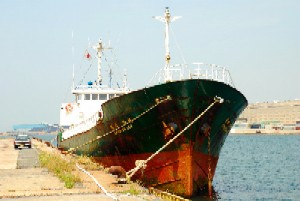
|
|---|
韓国籍の貨物船を利用した組織的な密航事件が、宇部署と宇部海上保安署の捜査で摘発された。密航者が船員の上陸許可証を借りて船に乗り降りするという手口。捜査の過程や裁判では、生活のために違法な渡航を試みる韓国人がなお少なくないことが明らかになった。
「密航費用にいくら支払ったのか」
「1千万ウォン」
韓国籍貨物船「エバーマサン号」(617トン)で韓国から渡り、不法入国したとして山口地裁宇部支部で入管難民法違反罪で有罪判決を受けた孫大鎬被告(49)は、7月に行われた公判で密航請負のブローカーに渡した金額を明らかにした。日本円で約100万円に相当する。
3年前から経営していたスーパーが借財を抱えて閉店。生活費や子どもの進学費用を稼ぐために日本で働こうとした。しかし、過去に2度、日本を強制退去になっており、正規の来日は不可能と考えて密航を決意したという。仕事はかつて日本で覚えたかばん製造。ブローカーに払った金は兄から借りたという。
摘発のきっかけは5月18日未明、宇部署の交通検問で止められた車に乗っていて旅券不携帯容疑で逮捕されたことだった。調べに対し、宇部港に前日寄港していた同船から上陸していたことを認めた。
同船は17日中に宇部港を出たが、愛媛県沖で座礁した。宇部署から通報を受けた宇部海上保安署が乗り込んだところ、船員手帳などを持っていない黄永運被告(51)=不法出国企図などで有罪判決=が潜んでいるのが見つかった。
黄被告は96年に観光ビザで来日。以来12年間、不法残留していた。東京都内のかばん工場で働き、茨城県利根町に自分の製造工場を持つまでになったが、「いつ捕まるかと心の休まる日がなかった」という。大手を振って経営を続けるため、投資経営ビザを正式にとって日本に戻ろうと考えての密出国だった。
◇
孫被告はエバーマサン号の船員から上陸許可証を借りて上陸し、日本を出ようとした黄被告と入れ替わった。
2人を引き合わせたのは、車を運転していた韓国人の金致栄被告(35)=営利目的不法入国隠避などで起訴、公判中=だった。港近くのパチンコ店でおちあい、上陸許可証を引き継がせた。その後、孫被告を東京まで運んで謝礼を受け取る約束だったという。
金被告は昨年9月に佐賀県呼子港から10人が不法出国した事件にも関与していたことが判明。密航に4度関与したことを認めた。密入国や密出国のブローカーに連なり、成功報酬は1人につき11万円だったという。
エバーマサン号の船長や一等航海士を含む船員7人も、不法入国や不法出国を助けた疑いで逮捕され、一連の事件で逮捕された容疑者は12人に上る。金被告は密航を請け負う組織については口をつぐんでいるが、捜査当局は1人を割り出して国際手配した。
◆不法入国の摘発 韓国人増加傾向
法務省の入国管理局によると、不法入国の摘発数はこの10年ほど年間1万人前後で推移してきたが、07年は前年より約3千人減の7454人にとどまった。政府は不法な出入国の母体となる不法滞在者対策に03年以降、本腰を入れており、その結果が表れたのではないかと分析している。
だが、韓国人の摘発は増加傾向にある。98年には285人だったのが07年は619人と2倍以上になった。今回の事件のように船舶を使うケースが目立ち、03年の113人から07年は301人に増加。広島入国管理局は「空港での取り締まりが厳しくなり、船舶に流れたという見方ができる」と話す。
外国人労働者が日本経済を支えているのも事実だ。全国の外国人労働者数は不法就労も含めて約85万人と推計されている。経済協力開発機構(OECD)は、日本が労働力人口を維持するには年間50万人の外国人を受け入れる必要があると指摘した。
日本経団連や経済産業省も研修・技能実習生の在留期間延長や、在留資格の緩和を要望している。
平成20年6月、稚内海上保安部は、稚内港に入港したカンボジア籍貨物船「SARGAN」に対し関 係機関と合同で立入検査を実施したところ、船内居室において乗組員名簿に記載のない2名のイラ ン人を発見、警察が同2名を不法入国容疑で逮捕し、稚内海上保安部が乗組員5名を集団密航助長 容疑で逮捕しました。
全国最多の5000枚押収 日立港で先ごろ、偽造クレジットカード作成用のカード原板を国内に持ち込もうとした貨物船の船長、船員ら中国人六人が税関職員らによって取り押さえられた。六人が持ち込もうとしたカード原板は約五千枚分。同様の偽造カードの密輸入事件は各地の空港・港湾で摘発されているが、一回の押収枚数としては全国でも過去最多になる。県警は、背後に外国人を巻き込んだ大掛かりなカード偽造団があるとみて調べている。 ■急増のカード被害 八月六日午後、日立港第二ふ頭。接岸した貨物船から上陸してきた中国人船員の不審な様子に、税関職員が気付き職務質問。ズボンのポケットにカード原板を隠し持っているのを見つけた。 原板は磁気データの入力用。スキミングで盗み出した他人のデータを書き込み、偽造カードとなる。 偽造カードによる国内の被害は年間、数十億円規模に上る。日本クレジット産業協会(東京)によると、十年前の九七年当時は約六億円だったのに対し、〇六年は約三十一億六千万円。 ■外国船員ら関与 こうした偽造カードの原板は主に海外から持ち込まれている、とみられている。鹿島税関日立出張所によると、中国やマレーシアからの持ち込みが目立つ。 原板は、かつては旅行客を装った運び屋が千枚単位で空路で持ち込むケースが大半だったが、近年は外国船員らによって大量密輸されるケースが目立つ。〇五年には、宮城県の塩釜港で原板四千枚を持ち込もうとした中国貨物船が摘発されている。 税関当局は偽造カードの横行を踏まえ、国外から流入するカード原板の水際での阻止へ本腰を入れている。その一環で、改正関税法も昨年から施行され、原板を新たに「輸入禁制品」と位置付け、持ち込みの罰則を強化した。従来は摘発されても、一般的な無許可輸入品として処理されていた。 ■水際阻止へ全力 水際で流入を阻止されたカード原板は急増している。鹿島税関支署日立出張所によると、全国の税関で摘発された原板枚数は二〇〇〇年に約三千枚だったが、〇五年には約一万七千枚に増えた。しかし、実際の摘発は「氷山の一角」(捜査関係者)とみられ、税関当局などはさらに警戒を強めている。 日立港で捕まった中国人六人は県警のこれまでの調べに対し、原板の受け渡し先について「『外に来ている車の人に渡せ』と指示された」「会社の指示に従って仕事した」などとあいまい
兵庫県警薬物銃器対策課と神戸税関、神戸海上保安部などが九月末、姫路港に入港した
中国籍の貨物船などから覚せい剤計六キロ(末端価格3億6千万円相当)を押収していた
ことが19日、分かった。同課などは、覚せい剤取締法違反(営利目的の譲渡・譲受)の
現行犯で、中国船の船員と受け取り役とみられる男女の計3人を逮捕しており、
背後に大がかりな密輸組織があるとみて売買ルートなどを厳しく追及している。
逮捕されたのは、中国籍の貨物船員(50)▽受け取り役で住所不詳、無職の女(22)
▽同、男(35)の3容疑者。
調べでは、9月28日午前6時20分ごろ、姫路市飾磨区細江の姫路港船場川公共波止場に、
中国籍貨物船「福峰山」(2,311トン、中国人19人乗り組み)が着岸した。
翌29日午前8時45分ごろ、船員の容疑者が、近くの岸壁に止まっていた乗用車に乗り込み、
車内の2人の両容疑者と接触したところを、捜査員らが職務質問し、覚せい剤3キロの所持を確認。
3人を現行犯逮捕した。
船員は、覚せい剤を茶袋6袋に分けて入れていた。さらに捜査員らが船内を捜索したところ、
別に3キロの覚せい剤を見つけて押収した。
同課などは、密輸情報を入手して合同捜査していた。福峰山は9月17日に中国の青島を出港し、
鉄鋼素材3000トンを搬送してきた。これまでも不定期航路でたびたび日本に来航していたという。
船は県警などの捜査が終わり、今月11日、姫路港を出港している。
宮城県警塩釜署と塩釜税関支署などは8日までに、偽造クレジットカードの原板約4000枚を密輸したとして、
支払い用カード電磁的記録不正作出準備などの疑いで、いずれも中国籍で船員、馬工東容疑者(33)と
飲食店従業員、夏●容疑者(33)=埼玉県川口市=の2人を逮捕した。
調べでは、2人は7月11日午後2時ごろ、中国から貨物船で宮城県塩釜市の塩釜港に入港し、
偽造カードに利用する原板約4000枚を密輸入した疑い。
税関支署を無申告で通ろうとした馬容疑者を支署職員が調べたところ、持っていたバッグからカードが見つかった。
夏容疑者は受け取り役で、港から逃走したが9月に埼玉県内で逮捕した。
カードにデータは入っておらず、馬容疑者は「中国・福建省で日本への持ち込みを頼まれた」と供述している。
塩釜署などは背後に偽造カードグループがあるとみて調べている。(共同)
●=風の右に炎
日本の大手海運会社がパナマ籍船を多く所有しているが、 (多くはIACSのメンバーである検査会社が検査している) パナマ籍船もチェックは甘い。 だから、違法や違反をしたければ ツバル籍、 モンゴル籍船、や カンボジア籍船 のようにマークされていないので、 ある意味では抜け穴だ。 でたらめな検査も可能。 検査のずさんさは上記の国籍に負けない。 不正な検査を行う検査官も多数存在する。 外国船舶監督官(PSC)もこのことについて認識しているのか知らないが、 知らなければ、 海上保安庁 や 税関 も知らないだろう。尾道糸崎税関や尾道海上保安部のように、船舶国籍証書の 偽造について問題解決に動かないところもある。付け加えて言うのであれば、統括監視官や 彼の部下などは問題の隠蔽に動いたと思われる発言や行動を取った。これでは、密輸や 密入国など止められない。真剣に問題解決に取組んでいる保安職員や税関職員には申し訳ないが、 こいつらは使えないばかりでなく、税金泥棒である。問題を教えてやる時間も無駄である。 外国船舶監督官(PSC)、海上保安職員や税関職員の中には、やっているだけで問題点を 見つけようと努力していないように思われる職員も存在する。一部のがんばっている職員の記事を見て、 皆、がんばっていると思い込むのは危険である。
「中国は国内法で、外国との二重船籍を禁じている。 海保は船籍情報などを中国に送り、中国国内での取り締まり強化を求める方針だ。」 そうだ。ある日など、海上保安庁職員が船を外国船に横付けして調べていた。この船は 上記の記事が正しいのであれば、二重国籍なので指摘されなければならない。しかし、そのまま、 保安職員達は帰っていった。二重国籍であることを発見できなかったのか、調べなかったのか、 見つけたが知らないふりをしていたのか、本人達のみが知ることである。しかし、これは事実である。 これでは税金を使って効果的な取締りを行っているのか、疑問である。
外国の国内法まで知っている外国船舶監督官(PSC)、海上保安職員や税関職員は少ないと思うが、 多くの良い旗国は、船員がいつ、乗船してきたか、下船したのか、記録簿を持つことを要求し、 記入することを要求している。また、旗国の船員手帳にはいつ、乗船したのか、下船の理由(契約の 終了や船の売船)等を記入することを要求している国もある。パナマ籍船を例とするなら、 船員がいつ、乗船してきたか、下船したのか、記録簿を持つことを要求しているし、パナマの船員手帳 にもいつどの船に乗船し、いつ下船したかを記入するページもある。このことを知った上で、 チェックすれば、より効率な摘発が出来る。もし、記入が抜けていれば、外国船舶監督官(PSC)は ISMの不備として指摘し、記録簿の記入や船員手帳の記入をすることを要求できる。なぜなら、 ISMで国際条約及び国内法を満足することが要求されているからだ。 ITFの協力を受けて、船員との雇用契約が交わされた書類のコピーがあるのか等についてもチェック できる。本当にチェックすれば簡単にごまかすことが出来ない。実際、外国船舶監督官(PSC)、海上保安職員 や税関職員がどの程度までチェックしているのか、どのようなチェック基準を採用しているのか不明である。
密入国やその他の問題が北九州の保安部により指摘されているが、九州の保安部に精鋭が配置されているのか、 偶然に優秀な保安職員が集まったのか、不思議である。他の保安部で問題がないとは思えない。
外国船が入港する港は、2004年7月1日以降、 ISPSコード(国際船舶及び港湾施設保安コード) の要求を満足することになっている。結果として、 国土交通省から国際船舶・港湾保安法に基づく埠頭保安規程等の承認 を受けた埠頭だけ外国船が入港できる。この保安法によりセキュリティーの確保のため警備員や フェンス等が設置された。しかし、警備員について言うと、知識が不十分だったり、国際船舶・ 港湾保安法の知識が乏しく、上から言われたことだけを守っているところもある。中には、時折、 警備員がいなかったり、警備員の対応がずさんだったり、国際船舶・港湾保安法が要求しているセキュリティー の確保の点から言えば、国土交通省の対応に甘さがあると言えるだろう。一旦承認しても、 抜き打ちでチェックし、あまりにもひどい対応の港湾に対しては警告又は改善が見られない場合は、 承認の取消し等を含め対応するべきであると思う。
中国新聞(2007年4月29日)より
福岡の漁港
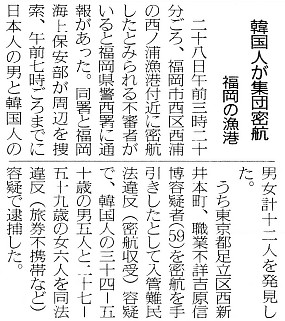
検察についても外国の政府が発行する書類が 本物であるかの確認能力、外国の政府の許可なしに発行した行為が犯罪になりえない判断等、疑問がある。 個人的に言えば、外国船舶監督官(PSC)、 海上保安職員や税関職員の中には問題のある職員も存在するので、公務員の改革が必要と考える。
下記の記事について言えば、中国員船員は他の国の船員を比べれば、船が接岸してから いろいろと歩き回っている。一時上陸許可証がないと上陸できないが、オレンジ色の紙で、 写真は貼られていない。保安庁の判断次第であるが、 国際航海船舶及び国際港湾施設の保安の確保等に関する法律で定められた船舶保安情報の通報 が入港の24時間前までに要求される。この時に、船員のリストを添付させればよい。また、 日本もセキュリティーと騒いでいるのだから、オレンジ色の一時上陸許可証を写真付きに変更し、 費用が掛かるのであれば、費用を上げればよい。最近はデジカメが普及している。代理店に 写真がないのであれば、入港した時に手続きにために乗船するのであるから、デジカメで写真を 取ることを要求すればよい。さらに不安であれば、船員手帳の写真をデジカメで取るように要求 すれば良い。代理店には不正に関与すれば、処分があることを誓約書に書かせ、会社だけでなく 対応する個人にも誓約書を書かせれば良い。代理店の中には不法であるにも関わらず、関与する 人間が存在する。この現実を踏まえて、処罰を含め対応するべきである。 データベース化すれば、密入国を摘発し易くなる。一時船陸交通の番号を警備員に記入させ、 偽造の疑いがあればエクセルやアクセスで検索できるようにすればよい。 これぐらいが出来なければ、本当に海上からの不審者等のセキュリティーの確保などできない。 保安庁の船や税関の船を減らしてでも、このようなシステムを導入するべきだ。 全ては保安庁や税関次第。
福岡県警西署と福岡海上保安部は28日、韓国から漁船で集団密航したとして、27~59歳の韓国人11人(男5人、女6人)を入管難民法違反(不法入国、旅券不携帯)容疑で逮捕、手引き役とみられる東京都足立区西新井本町2、職業不詳吉原伸博容疑者(59)を同法違反(密航収受)で現行犯逮捕した。
ほかにも数人が逃走したとの情報もあり、同署などで行方を追っている。
調べによると、韓国人11人は28日午前3時すぎ、福岡市西区西浦の西ノ浦港で、小型漁船から上陸しているところを、近くにいた男性(60)が見つけ、110番通報した。
同署員が、約7キロ離れたコンビニエンスストア近くに止めたワンボックスカーに乗っていた吉原容疑者と、韓国人6人を発見し、同法違反で現行犯逮捕。残る5人はその後、港近くで隠れているところを見つけた。
11人のうち8人は韓国のパスポートを所持していた。日本円数万円と韓国の紙幣などを持っており、「韓国南部の港から密航した」などと容疑を認めている。
吉原容疑者は「東京から車で来て、関東方面に連れて行くつもりだった」と供述しているという。同署は密航あっせん組織が関与した可能性があるとみて追及している。
西ノ浦港では、18日未明にも不審な漁船が接岸し、10人前後の人影が動いていたのを釣り人が見ている。同署は今回の事件との関連も捜査する。
28日午前3時17分ごろ、福岡市西区西浦の西ノ浦漁港で、漁船から上陸する不審な人影を、近くにいた男性(60)が見つけて110番した。福岡県警が周辺を捜索したところ、韓国人とみられる11人(男5人、女6人)と、運転手役の日本人の男を発見して身柄を確保。日本人の男を含む男女8人を出入国管理法違反容疑で逮捕した。集団密航事件とみて調べている。
福岡・西署によると、11人は20~50代。このうち6人は同区横浜の路上で、ワンボックスカーに乗っているところを取り押さえた。日本人の男は車内におり、出迎えにきたと見られる。残り5人は漁港周辺に潜んでいるところを発見した。いずれも軽装で、韓国のパスポートは偽造ではないとみられ、韓国の紙幣を所持している者もいるという。
西ノ浦漁港では、18日未明にも密航者らしい十数人が上陸したのが目撃されており、連続密航事件の可能性もあるとみて関連を調べている。【木下武】
26日午前4時45分ごろ、静岡市清水区の清水港沖合約900メートルに停泊中の韓国船籍のまぐろ漁船「シンユエン」(384トン、金東台船長)から、「船員4人がいなくなった」と清水海上保安部に通報があった。
これが現状か!
海上保安部や税関はしっかりとしないといけない。
海事保安コンサルタント IMOS アイモス
には海上保安庁出身者が多いようだ。なぜ、コンサルタントをできるほどの
人材が保安庁にはいるのに、海上保安庁/部による現状の保安のチェックは甘いのか??
海事保安コンサルタント IMOS アイモス
のHPに書かれている基本的な項目を、海上保安庁/部がチェックすれば、多くのサブスタンダード
船の保安に不備があることが明らかになる。問題にならないのは、実行していないことを意味している
と思う。
外国船に乗船しアクセスコントロールが実行されているのか、訪船者リストを常時、記録簿に記入している
のかなどをチェックしているのか疑問である。船舶が国際船舶保安証書を保持していても、発給した検査
会社によっては保安に関して問題がある船舶が多く存在する。
保安、保安と言っても、実際にチェックが甘ければ、意味がないと思う。
反論があるならば、
なぜ、このような状態を見る機会に遭遇するのか
誰が教えてほしい。海上保安庁/部の対応に問題があると思う。
正規の船員手帳を使った中国人密入国事件で、若松海上保安部(北九州市)が2月に摘発した貨物船フェンリャン号(パナマ船籍)と、船主が同じ別の貨物船(中国船籍)の2隻が04~05年、少なくとも8県の13港に計22回入り、中国人100人近くを密入国させていた疑いのあることがわかった。密入国させた後、手帳を中国に持ち帰り、次の密入国者の写真に張り替える手口を繰り返していたという。
正規の船員手帳を使った中国人による密入国事件で、門司海上保安部(北九州市)と福岡県警は24日、神奈川県警などの協力を得て横浜市や神戸市のマンションなど7カ所を入管法違反容疑で家宅捜索した。神奈川県警が横浜市内で、殺人未遂容疑と窃盗容疑でそれぞれ指名手配されていた中国人男性2人を逮捕した。窃盗容疑で逮捕された男(35)は、船員を装った密航者4人の引受人と見られるという。
正規の船員手帳で密入国したり、船員として密入国を手助けしたりしたとして、門司海上保安部(北九州市)が中国人12人を入管法違反の疑いで逮捕していたことがわかった。正規の船員手帳を持った密入国者を摘発したのは全国で3例目。今回は船員全員が密入国に加担した悪質なケースで、同海保と県警は新たな密航の手口として警戒を強める一方、背後に大がかりな密航組織があるとみて、23日までに同容疑で兵庫県と神奈川県の関係個所の捜索令状をとり、近く強制捜査に乗り出す方針だ。
18日午後3時15分ごろ、北九州市門司区の太刀浦第2コンテナターミナルに接岸していた韓国籍のコンテナ船「SSブサン」
「人民網日本語版」2004年6月4日の記事によると
天津税関、韓国へのコークス密輸船を調査
天津税関輯私局がこのほど国内沿海で行った輸送船舶の検査で、天津新港でコークス1500トン(400万元相当)を積載したある貨物船が、港湾監督部門に目的地を上海と申請しながら、実際には韓国に向かっていたのが見つかった。同船は許可証を受けておらず、密輸の疑いがもたれている。
天津税関輯私局の調査はすばらしい。尾道糸崎税関は「ニセの外国船舶証明書」の件では
協力もしなかった。広島県警は、私文書偽造だと言って、何もしなかった。
これが日本の公務員の現状である。問題解決をしようとする姿勢が見られない。
ニセの外国船舶証明書を購入し、日本の港湾ではモンゴル籍の船舶と偽って申請を行れば、
見つかる可能性はないであろう。保安庁もほとんどチェックしていなかった。船舶代理店任せであった。
今も何も変わっていないと思う。
ライブドアの堀江社長逮捕以来、法令順守、企業倫理、違法はだめとか、テレビを通して言われている。
尾道糸崎税関の監視官は、
法令順守はお金を儲けてからで良いと言っていた。この監視官のような公務員がいるから、
違法な輸出、違法や輸入、密入国、ライブドア事件、
耐震偽造、
公認会計士の粉飾決算関与
が可能なのだと思う。
法令順守は公務員の常識であるのなら、彼は非常識な公務員となる。実際は、どうなのだろうか。
人の命も日本人でなければ、軽いと思わされる出来事に遭遇する。これが日本の現実。
ライブドアの堀江社長は運が悪かっただけであろう。本当に法令順守と言うのであれば、
法の改正や制度の改正がさまざまな分野で必要となる。やる気はあるのか?多分、無い!!
正直者がばかを見る!
★ポート・ステート・コントロール(PSC)(外国船舶監督官)
は
カンボジア籍船
や
モンゴル籍船
が密輸に使われているだけでなく、国際条約を満足していないことが
ある現実を理解し、検査を行うべきである。ツバル籍船もあやしいかもしれない。
PSC(外国船舶監督官)の検査
はまだまだ甘い。
モンゴル籍船舶が出港停止命令を日本で頻繁に受けている。英語がわかる人は
上記の記事と現実との隔たりがあるとがわかるだろう。日本はカンボジア籍
の時と同じように野放しにするのだろうか。徹底的に検査を行い、国際条約を
満足しない状態で入出港を許可しないか、見守っていくしかないだろう。
欠陥船根絶で監査制度試行 日本の提唱受けIMO (共同通信)の記事を
読むと「国際条約の専門家や船舶検査官らを各国が派遣して監査チームを
結成し、海上人命安全条約や海洋汚染防止条約などに適合した国内法を
整備し、人員や設備などの十分な体制を取っているかを調べる。」と書かれて
いる。人員や設備などの体制をチェックするよりも、問題のあるフラッグ
(旗国)に登録されている船舶をどのように検査しているのか、検査報告書
と船舶の現状の違いについてどのような対応をしているのか。問題のある
検査会社に対する処分や制裁等を行っているかを確認するほうが良いであろう。
一般的に問題がある旗国でも規則等はあるのである。問題は、規則の厳守を
怠っているから問題なのである。また、問題を知っていながら放置している
旗国もある。また、PSCの能力のばらつきにより、
サブ・スタンダード船
が問題を放置したまま入港を繰り返している場合もあるのである。
故意に問題を見逃している検査会社もあり、実際にこのような検査会社を
取締まらなければならない。現状は、野放し状態である。
また、日本周辺を航行する多くの
サブ・スタンダード船
の多くが、元日本国籍で日本から輸出された事実にも注目しなければならないだろう。監査制度
を提唱するぐらいだから、これらの問題にも取組むと推測する。今後の活動
に注目したい。モンゴル籍の例のように、言っていることとやっている事が
全く違う場合もあるのである。効果を上げるにはどのようにすべきか考えて
ほしい。今後の日本のPSCの活動に反映されることを祈るのみである。
多くの
カンボジア籍船
や
モンゴル籍船
は問題を抱えたまま日本に入港している。
PSCは検査を行う時は、気まぐれで検査せずに、徹底的に検査してほしい。
船主、荷主、港湾関係者の圧力に負けずに、PSCの誇りを持ってUSコーストガード
のように日本のPSCは他のアジアのPSCとは違うと知られるようになってもらいたい。
外国に本拠を置く国際犯罪組織
事例1
清水海保や清水署によると、同日午前1~2時ごろ、清水港から東へ約900メートル沖合の外防波堤付近で、男性船員4人が海に飛び込んだ。中国籍の41歳と、ベトナム籍の32、28、22歳の計4人で、荷物は船内に残されたままだった。
波も穏やかで、「泳いでいた」との他船員の目撃情報もあることから、清水署は4人が入国目的で海に飛び込んだとみている。海保はヘリ1機と巡視船1隻を出し、清水署は海岸線を中心に4人を捜索している。船は、同日午前7時に清水港日の出ふ頭に着岸し、27日午後2時に韓国・釜山港に向け出発予定だった。
第7管区海上保安本部などが、フェンリャン号に乗っていた密入国者8人と船員7人=いずれも入管法違反の罪で有罪判決=の供述などをもとに調べたところ、同船は04年11月~05年11月、中国山東省などから徳島、山口、富山県などに計11回入港。別の貨物船は05年1~11月、兵庫、大分、千葉県などに計11回入っていたことが確認された。
船内に残されていた乗員名簿や航海日誌から、1回の入港につき数人ずつ、計100人近くの中国人を密入国させていたらしいことがわかった。
密入国を目指す中国人は、自分の写真が張られた船員手帳など複数の書類を密航組織の関係者から渡され、そこに書かれた名前や生年月日を覚え、見知らぬ人物になりすましていた。
日本の港に入ると、パスポートを持っていなくても船員手帳があれば、書類審査のみで一時上陸許可証が得られる。港湾内の人や車の出入りをチェックする警備員も、手帳を入念に調べることはないという。
密入国に成功すると、一時上陸許可証と手帳は船員に返し、中国で「日本へ着いたらここへ連絡しろ」と指示されていた先に電話を入れて、日本国内の引受人と接触することになっていた。
密入国を手助けした船員は手帳を受け取って再び船に戻る。入港時には入国管理局に船員数を申請するが、出港時に実際は何人乗っているかを調べられることはないという。中国に持ち帰った手帳は、写真を別の中国人のものに張り替え、再び密入国に使っていた。
7管は、中国にある密航組織が2隻を使って繰り返し密入国を企てていたとみている。海保幹部は「04年以前にもフェンリャン号が国内へ入港した記録があり、実際の密入国者数はさらに多数にのぼるのではないか」と話している。
門司海保は6月、グルジア船籍の貨物船ペンシャン号に乗り、正規の船員手帳の写真を張り替えて船員になりすまして密入国したとして、中国人4人を入管法違反容疑(不法入国)で逮捕、密入国を手助けしたとして、船長ら8人を同法違反(密航助長)容疑で逮捕している。
門司海保などによると、グルジア船籍の貨物船ペンシャン号で、12人のうち8人は正規の船員で、密入国者4人を手助けしていた。4人は実在する人物の船員手帳の写真を張り替えて船員になりすましていた。
船は6月9日に中国山東省を出港。同13日、日本の領海内に入る際に義務化されている24時間前通報をしていたにもかかわらず、通報時間より早く領海内に入ってきたことから立ち入り検査を実施した。
船員手帳の写真が張り替えられた疑いがあることから、海上保安試験研究センターに鑑定を依頼し、写真が張り替えられていたことが判明。「一見しただけでは見破るのが困難なほど精巧だった」(海保幹部)という。
12人は入管法違反(不法入国と密航者助長)容疑で逮捕、起訴され、9月に福岡地裁小倉支部で初公判が開かれる。
同様のケースとしては2月に若松海保が北九州市八幡西区に入港したパナマ船籍の貨物船で、正規の船員手帳を所持していた7人と船員7人ら中国人計15人を入管法違反容疑で逮捕した。
このケースでは、船員手帳を持っていた中国人は「家族に裕福な暮らしをさせるために密航した」「2、3年で200万円ほど稼いで帰国するつもりだった」などと供述。密航費用は「中国の組織に密航が成功した後で、家族などに頼んで15万~18万元(約225万~270万円)を支払う約束だった」などと話しているという。
船員7人は密航を手助けした見返りに報酬を受け取る予定だったといい、「密航を貿易船のサイドビジネスにしていた可能性が高い」(海保幹部)としている。
(1,512トン)を門司海上保安部などが立ち入り検査、機関室に潜んでいた韓国人女性2人を見つけた。
事情を聴いたところ2人とも以前から日本に滞在し不正に出国しようとしていたことが判明、同海保は入管難民法違反(密出国企
図)の現行犯で、いずれも自称韓国籍の白美仙(ペク・ミセン)(33)、奇貞淑(キ・ジョンスク)(35)両容疑者を逮捕した。
調べによると、同船は17日に韓国の釜山を出発。18日に下関と太刀浦を経由して釜山に戻る予定だった。同保安部が船長らか
ら事情を聴くなどして密出国の背後関係などを調べている。
したそうである。
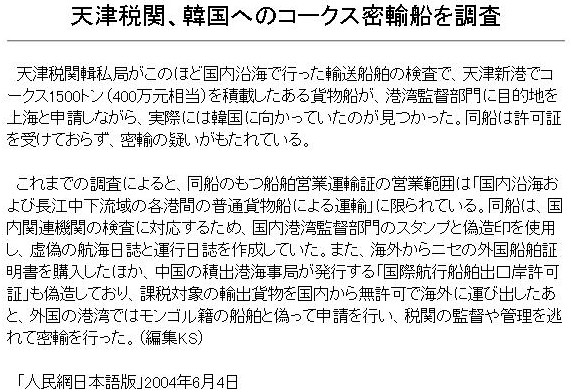
これまでの調査によると、同船のもつ船舶営業運輸証の営業範囲は「国内沿海および長江中下流域の各港間の普通貨物船による運輸」に限られている。同船は、国内関連機関の検査に対応するため、国内港湾監督部門のスタンプと偽造印を使用し、虚偽の航海日誌と運行日誌を作成していた。また、海外からニセの外国船舶証明書を購入したほか、中国の積出港海事局が発行する「国際航行船舶出口岸許可証」も偽造しており、課税対象の輸出貨物を国内から無許可で海外に運び出したあと、外国の港湾ではモンゴル籍の船舶と偽って申請を行い、税関の監督や管理を逃れて密輸を行った。(編集KS)
国際的な密航請負組織である「蛇頭(じゃとう)」は、中国での密航の勧誘、引率、搬送、船舶や偽造旅券の調達、日本での密航者の受け入れ、隠匿を行うなど、国境を越えて暗躍している。
また、ロシア人犯罪組織による盗難車の密輸出事件やロシア人女性の売春事件、韓国人グループによるすり事件等、外国に本拠を置く国際犯罪組織が我が国で活動する例も多くみられる。
ロシアに輸出される中古自動車
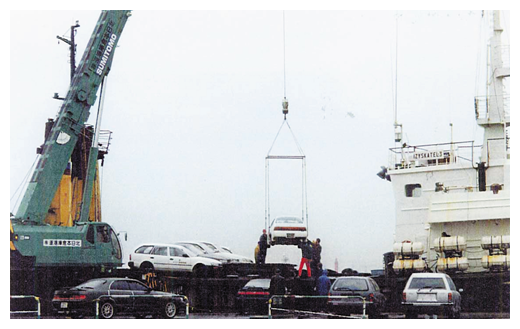
平成15年10月、京都市内で開催されていた時代祭の見物人のショルダーバッグから現金入りの財布を抜き取った3人グループのうち、2人の韓国人の男を窃盗罪で逮捕した。事件当時、両名は頻繁に来日しており、うち1人は犯行時にナイフを所持していた(京都)。
事例2
15年10月、八戸港に入港した中国船籍貨物船に対し、函館税関八戸支署とともに船内検索中の八戸海上保安部から「機関室内から覚せい剤約2キログラムを発見した。その際に中国人船員1人が逃走した」旨の通報を受け緊急配備を実施し、逃走した船員を発見、確保するとともに、海上保安部・税関と合同で同船舶の船内を検索した結果、船員居室の天井裏に潜んでいた中国人密航者7人を発見し、入管法違反(不法入国)で逮捕した。
また、海上保安部、税関との合同捜査の結果、密航者を輸送した中国人船員20人、日本での出迎え役の中国人3人を同法違反(輸送等)で、船員1人を覚せい剤取締法違反で逮捕した(青森)。
リンク先の中には繋がらないものもあると思いますが、ご容赦ください。